
My Cruiser Life Magazine

25 Best Sailboat and Catamaran Manufacturers (By Type)
Asking a sailor to pick the best sailboat brands is like asking a car enthusiast to pick the best sports car. Boaters are connected to their boats and share a personal attachment to them that goes beyond the practical. Boats are close to living things. For millennia, sailors have personified their vessels and labeled them “she.” Whatever pronouns you choose to use with your boat, there is no doubt that he or she will earn a special place in your heart.
So how does a humble writer go about breaking down the “best” sailboat manufacturers? Is it of all time? Or are only companies still producing boats today? We must set some limits, and they will no doubt seem arbitrary–but here they are.
First, we are dividing this list up to cover coastal cruisers, luxury monohulls , voyaging bluewater cruisers , cruising catamarans , and performance catamarans. Yes, there is some overlap between these categories. For example, many big “coastal cruisers” have crossed oceans, and many seawind catamaran brands are more than capable cruisers.
So what makes a boat “the best.” The best boat for you is not going to be the best boat for the next guy. There’s simply no way to define what the best manufacturers are going to be. The reason we chose these boats are specified below. It’s not arbitrary, but, at the same time, you don’t have to agree with them.
Finally, nearly all of the brands listed below have one thing in common—you can still buy a new vessel from their yard. In the world of boating, it’s not uncommon to purchase a vessel that has been out of production for decades. There are hundreds, probably thousands, of great manufacturers who went out of business during major economic downturns. Building boats is always a tricky business, but with the economy suffering no one buys new boats.
Table of Contents
5 best coastal cruiser sailboat makers, 5 best luxury sailboat manufacturers, 5 best voyaging bluewater cruising boats, 5 best cruising catamaran manufacturers, 5 best performance cats.
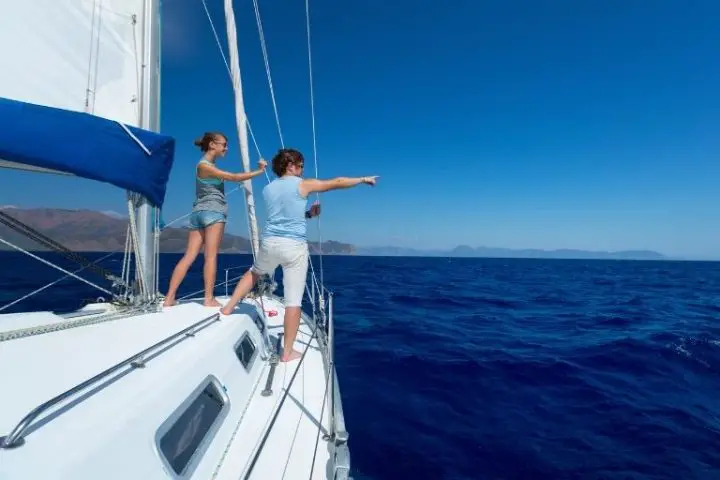
Coastal cruisers are entry-level sailboats built affordably so that nearly anyone can buy one. Another term that gets used is “production boat.” A production boat is designed to be mass-produced in an assembly-line-like factory for maximum cost savings.
The alternative is the custom or semi-custom built voyage yachts. Every element of the build is overseen by expert shipwrights. So the implication is that the production yacht has less quality—but this argument doesn’t always hold blue water if you can forgive the metaphor.
The manufacturers who make the most popular production coastal cruisers also make some larger yachts capable of crossing oceans. But one thing about these boats needs to be made clear—while some can be modified, improved, and outfitted to cross oceans, they do not leave the factory ready to do so.
And while some of them look very sharp, they do not contain the gorgeous hardwood joinery and craftsmanship that fills the hulls of hand-built yachts. These brands make their boats appealing to the mass market, and that market is not the voyaging bluewater cruisers or the luxury yacht.
So are they the “best sailboat brands?” If you’re looking for the best, most affordable coastal cruiser you can get, then yes—these are the best boats for you. However, if you’re looking for the best built, the best outfitted, or the best engineered or designed—then you’d best keep reading farther down the list!
Catalina Yachts
Catalina builds simple sloops ranging in size from fun 12.5 Expo dinghy to their 545 Flagship. There are more Catalinas in the world than any other types of sailboat . The company was founded in California in the mid-1970s.
Of the many wonderful models that Catalina has made popular, the Catalina 30 was an all-around winner. The beamy 30-footer has a cavernous interior that makes it a great entry-level liveaboard. The Catalina 38 is a popular racer/cruiser designed by none other than the famous Sparksman and Stevens (S&S).
Beneteau & Jeanneau
The French marine conglomerate Groupe Beneteau makes many different labels of boats, but their two most popular production sailboat brands are Beneteau and Jeanneau. They also make the Lagoon catamarans.
Like Catalina, the company makes production boats at an attractive price. They are roomy and comfortable to stay on or even liveaboard. In addition, Beneteau’s are known for their distinctive lacquered wood interiors, which add an air of sophistication to an otherwise average boat.
Beneteau has a long history. The company was founded in 1884 and has been building fiberglass boats since the mid-1960s. Notable models include the Beneteau Oceanis series, especially the models made after 1995. The most famous Jeanneaus come from the Sun Odyssey lineup.
Hunter Marine (Marlow-Hunter)
Hunter is another American builder and is Catalina’s primary domestic competitor. It is based in Florida and was formed in the early 1970s. Most Hunters have been racing boats or small trailer-sailors , but over the years, there have been quite a few larger liveaboard boats and long-range cruisers. They currently make boats from 15 to 50 feet long.
Dufour catamarans are another French company that makes larger cruising boats. The company was founded in 1964.
Bavaria Yachts
Bavaria Yachtbau is the largest German shipyard. The company makes sail and powerboats, as well as the French-made Nautitech catamarans. The company was founded in the 1970s and was acquired by US investors in 2007. Their monohull sail designs range from 31 to 57 feet long.
If the coastal cruiser category is reserved for the Fords and the Toyotas, let’s look at a few Cadillacs and Lexuses.
The boats below take things up a notch. These are beautifully designed boats with hand-built cabinetry and upgraded fixtures. They’re going to come with everything you need to cruise the boat in style.
Boats in this category are more likely to be built on a semi-custom basis. In other words, these yards might only be putting out a handful of boats per year. If you’re the first owner, you can likely visit and watch your sunreef yachts progress from fiberglass molds to rigging and launching.
Finally, the build quality of these yachts is generally exceptional. The designs usually come from the drafting boards of world-renown sunreef yachts designers, and their timeless beauty shines in every port they visit.
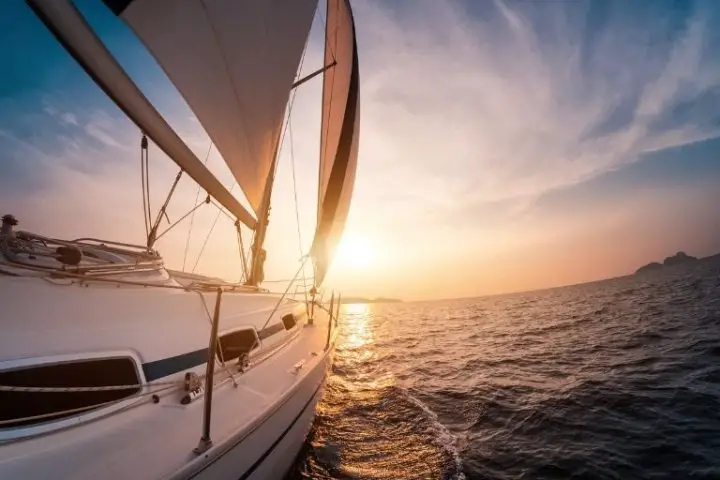
Morris Yachts
If you’re looking for a sailboat that’s also a work of art, Morris Yachts has the one you’re looking for. The company is based in Maine and produces semi-custom boats built to order. All boats are made by hand by expert craftsmen. Since it first opened in 1972, the company has made about 300 boats.
Their present offerings range from the M29 to the M42, but they have built hulls larger than that in the past. The most famous Morris boats, like the 36-foot Justine, were designed by renowned yacht designer Chuck Paine.
Island Packet
Island Packet has always made sturdy blue water cruisers with old-school looking (although technically updated) full keels. Some people may argue that IPs are production boats not quite worthy of the “luxury” title, but it is undebatable that the quality of their boats is above average.
Packets are built-in in Largo, Florida, near Tampa, and their shallow drafts and large living spaces make them perfect for living aboard in Florida or the islands. The first Island Packets rolled off the assembly line in 1980.
IP’s one-piece hulls do not feature the bolted-on keel and fractional rigs so common on many production boats now. Instead, you will find a robust design that is seaworthy and comfortable at sea.
Oysters are recognized worldwide as one of the most beautiful high-end cruising boats you can get your hands on. They focus on larger ocean-capable yachts with luxurious and cavernous interiors.
Oyster is a British yacht builder founded in 1973. Their claim to fame is the unique deck salon layout, which features large central windows around the living space that make the space feel much larger and more comfortable. The company is also known for its excellent attention to detail and outstanding build quality.
Hylas make sailboats ranging from 46 to 70 feet long. They are built in Taiwan by Queen Long Marine and were introduced in 1984. Most of their designs were created by renowned naval architect German Frers, although their first designs came from Sparksman and Stevens.
Tartan Yachts
Hailing from the Great Lakes port of Painesville, Ohio, Tartan has made sturdy and beautiful yachts since 1971. The company’s current lineup features everything from a tiny 24-foot day sailor to an ocean-capable 53-footer.
Tartans are set apart from other production boats by their beautifully crafted interiors. Thoughtful designs make these boats great cruisers and liveaboards.
Some boats are made as an accessible weekend cruisers for everybody, and some are exclusive showpieces that light up the harbor with their polished teak. Others are built tough to take on the elements at sea.
These boats are some of the best-built examples of marine engineering out there. These boats don’t come cheap, but that’s because their makers pay special attention to creating vessels strong enough to take on anything. They spend extra time making super-thick and strong hulls, and they use the best most robust equipment throughout the design.
The hull designs come from the drafting boards of world-renown naval architects. Their designs are heavy and built for a comfortable motion on big seas. In most cases, rudders are skeg-hung for extra security, and props are well-protected behind long keels.
These boat manufacturers routinely crop up on the lists of vessels that have circumnavigated successfully. These boats can cross oceans, and their crews never worry about their safety at sea.
Unfortunately, Texas-built Valiant Yachts ceased operations in 2011. The company built a series of canoe-sterned offshore sailboats from the drawing board of Bob Perry. The Valiant 40 is regarded as one of the best modern offshore sailing vessels. Many have circumnavigated, and the owners are a tight-knit group who love their boats.
Pacific Seacraft
Pacific Seacrafts are built in Washington, North Carolina. Many of their designs came from designer Bill Crealock, including the salty but comfortable PS 34 and PS 37. Other well-known models include the tiny 20-foot Flicka and the 24-foot Dana, both of which have serious offshore cred not given away by their diminutive statures.
Pacific Seacrafts are hand-built and regularly recognized as some of the best sailboats available. Build quality and thoughtfulness in design are second-to-none.
Hallberg-Rassy
Hallberg-Rassy is a Swedish shipyard that makes very sturdy and capable bluewater cruisers since 1943. Over the years, the company has made everything from small 24-footers to the flagship HR 64. Their best-known yacht was the smaller HR 35 Rasmus, of which they built 760 hulls. The 44 and 50 are their most popular current models.
Amel is the French maker of extremely well-regarded and modern bluewater ketches. This once common rig configuration, with two masts, reduces sail size to keep the lines more manageable on larger vessels. They also allow for more sail configurations to suit a broader spectrum of ocean conditions.
Famous sailing YouTubers SV Delos sail an Amel. The motor boats are large and capable of any voyage you can imagine. They feature thoughtful designs, including fully motorized sail control and a comfortable and protected center cockpit.
Winner of many best boat of the year awards, Passport yachts make spacious and comfortable offshore sailing machines. The first Passports were launched in 1979. The company is based in Annapolis, Maryland. Some of their early models, which Bob Perry designed, are excellent used sailboat options. Today, the company makes boats from 48 to 61 feet long.
And now for something a little different—the sailing catamaran categories. Sailing catamaran brands have become wildly popular in the sailing world because they are so comfortable to live on and offer a significant performance advantage over monohulls. Whether tucked safely in a marina or living off the grid by a tropical beach, sailing catamarans represent a fantastic upgrade to boat life.
You can argue about whether sailing catamarans or monohulls are the best sailboats all day long. But there will always be a place for each one, and there will always be people who love one but not the other.
The best catamaran brands below are the big and comfortable ones that most people will consider the “best” ones to cruise and live on. However, there are two types of sailing catamaran sailors—those that choose these boats because they have wonderful living space and those that choose sailing catamarans for the performance. If you’re the second type of person, you’ll want to move on to the next section about performance catamarans.
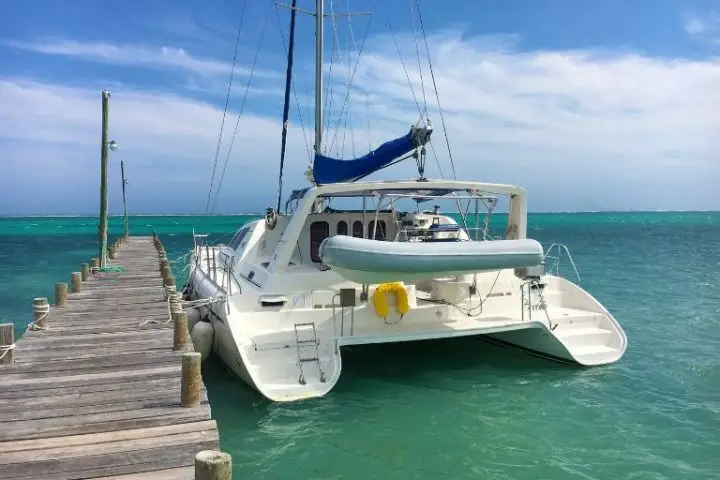
Antares Catamarans
The Antares began life as the PDQ 44. It’s a stout sailing catamaran with a few uncommon features that set it above most cruising catamarans—it has a high bridge deck for smoother rides, and it features maintenance-free traditional shaft-drive engines. The company currently builds boats in Argentina and is launching a hybrid model for the 2022 model year.
Knysna Yachts
The Knysna 500 is one of the most beautiful sailing catamarans that you’ll ever lay eyes on. Unfortunately, there aren’t many of these semi-custom boats in the world. The factory in South Africa has only made about 100 of these boats, but they’re well worth taking the time to seek out. Their overall craftsmanship and attention to detail are unmatched in the sailing catamaran industry.
Nautitech Catamarans
The French-built sailing catamaran arm of Bavaria Yachts, Nautitech catamarans makes boats that blend beautiful living spaces and solid offshore performance. Current models range from 40 to 54 feet long.
This Australian manufacturer of fast cruising cats has focused on performance while offering comfortable sailing catamarans suitable for cruisers. The Seawind 1000, first offered in the 1990s, set the standard for the small, simple, yet capable cruising catamaran. They currently produce boats from 38 to 52 feet long.
The Big Three— Lagoon , Leopard , and Fountaine Pajot
The three big names in cruising cats can’t be left out, but they aren’t particularly distinct enough to warrant individual shout-outs. Each company makes production cruising and charter sailing catamarans of average build quality. In car terms, these companies are making the Honda Civics of the sailing catamaran world. In monohull terms, these companies are Beneteau, Catalina, or Hunter.
Fountaine Pajot and Lagoon are French-built, while Leopard catamarans come from South Africa. All of the companies began gaining popularity in the late 1990s, and all of them are popular in the charter boat market. They all compete with one another closely, and their designs follow distinct trends. They often have functional layouts that are pleasant to liveaboard, but their build qualities are mixed.
One of the most common advantages that sailing catamaran companies want you to know about is their performance. Foot-by-foot, sailing catamarans are faster than monohulls. Regular cruising cats can still be sluggish in light winds, though.
But companies below take performance to another level. State-of-the-art rigging, sails, and weight-savings composites turn some of these boats into rocket ships. The vessels are big enough and outfitted well enough for voyages of any length. Many have circumnavigated. In short, these performance cats can move.
Catana is very similar to Lagoon or Fountaine Pajot—French-built charter sailing catamarans with lots of living space. However, the company’s designs feature retractable daggerboards instead of the more common mini-keels. This gives them better downwind performance and an advantage on big seas.
Regardless of the actual performance of the vessels, Catanas are built with sailing in mind. Aft helms provide a beautiful clear view of the sails and the conditions.
If you’re looking for a floating rocketship, Gunboat has your number. These carbon fiber-built miracles of space-age technology regularly zip along at speeds higher than the true wind. Carbon hulls and masts and the latest in rigging technologies make them tick.
They’re as fast as race boats but comfortable liveaboards, too. In their words, “Life is too short to sail a slow boat.” Since they opened in 2002, Gunboat has made fewer than 40 boats, ranging from 48 to 90 feet long. They’re made in La Grande-Motte, France.
The now-famous Outremer is featured on the YouTube channel Sailing La Vagabonde. It’s a fast boat. Current designs range from 45 to 55 feet long. Like all boats in this class, these are fast cats that still maintain enough space for comfortable living at sea. Outremers are built in France, and the company has been making performance catamarans since the 1980s.
HH Catamarans
Awarded several best boat the year awards by Cruising World and Sail magazines, the HH is a thoroughly modern take on the traditional cruising catamaran. More emphasis is placed on speed and performance, using daggerboards and super light composite construction. HH Cats are built in Xiamen, China. The company currently offers HH44, HH50, and HH88.
The sleeper of the performance cat category is Maine Cat, hailing from Lincolnville, Maine. Their boats are built lightweight with a focus on light air and upwind performance. Daggerboards are used along with simple, intelligent designs.
Of the boats on the performance list, the MC 30 is the smallest sailing cat offered. It features an impressive feature set, however, and a unique combination of traits. For one thing, these boats are designed to be straightforward and light instead of filled with luxuries. For more living space, the MC 41 offers speed and space with none of the frills.
Matt has been boating around Florida for over 25 years in everything from small powerboats to large cruising catamarans. He currently lives aboard a 38-foot Cabo Rico sailboat with his wife Lucy and adventure dog Chelsea. Together, they cruise between winters in The Bahamas and summers in the Chesapeake Bay.
Leave a comment
Your email address will not be published. Required fields are marked *
Save my name, email, and website in this browser for the next time I comment.
Better Sailing
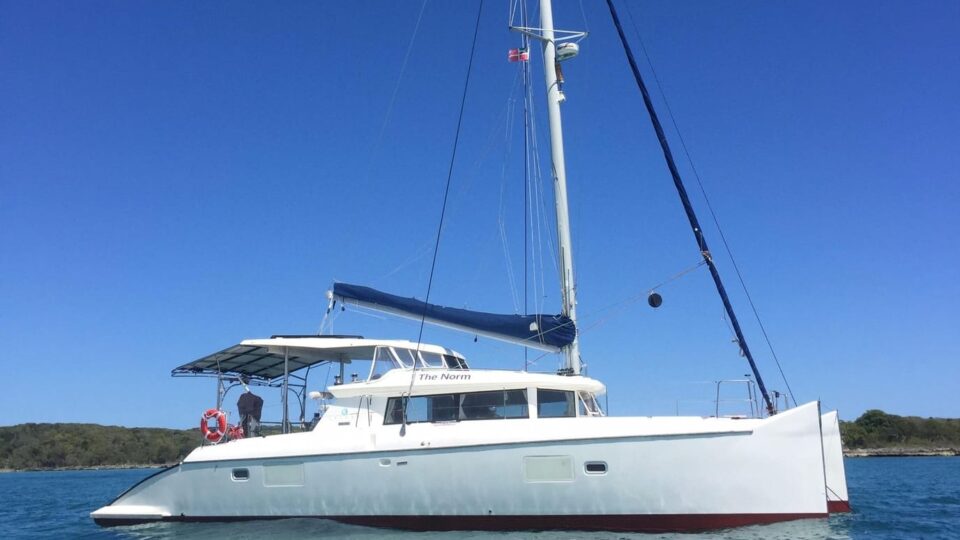
10 Best Catamaran Brands
Shopping for a new catamaran can be intimidating, even as consumers have more resources than ever to help them research from the comfort of their own home before they even contact a yacht broker. The great news is that there are a lot of great catamaran brands on the market right now. For us consumers, the catamaran market has evolved rapidly from what it was only just a few short years ago when monohulls were favored. On the flip-side, this can make it even more challenging to figure out which catamaran brands are the very best.
If you are a beginner in cruising catamarans, this article will help you learn the best brands that are out there with the best reputation amongst boaters. This article will help you get started in the world of catamarans, and I am trying to make it as beginner-friendly as possible. The catamaran brands on this list are mainly production boat companies, but some of them do offer custom designs. However, the added benefit of most of these brands is that there are many options on the used market. You will always be able to shop around for a good deal no matter where you are in the world.
Here are some of the best catamaran brands on the market today:
Lagoon – Groupe Beneteau
Lagoon is a French boatbuilder with an excellent reputation and sells the largest number of catamarans per year. The brand started back in 1984 and was one of the first catamaran brands to really convince people of the concept of multihulls. The philosophy of the Lagoon brand is good design, high-quality construction, and a decent cruising performance under sail. In other words, a Lagoon is the dream of every fan of sailing that looks for a catamaran that can provide everything, whether that is a fun toy for summer sailing trips or a year-round liveaboard yacht. What Lagoon did right, and the reason it has proven to be so popular is that it listened to its customers. That is why every new Lagoon catamaran has more space, more efficient layouts, and is always more comfortable than their previous version. There is no wonder why they have so many repeat customers.
Lagoon makes 9 sailing catamaran models and 2 powercat models, ranging in length from 40 to 78 feet. It also used to make shorted boats like the Lagoon 380 at 37 feet, but unfortunately, it was discontinued. You can find a Lagoon on the used market starting at $150,000 (like a 2002-2007 Lagoon 380) and as high as $5 million USD for their top of the line fully spec’d Lagoon Seventy 7, which comes with a jacuzzi on deck.
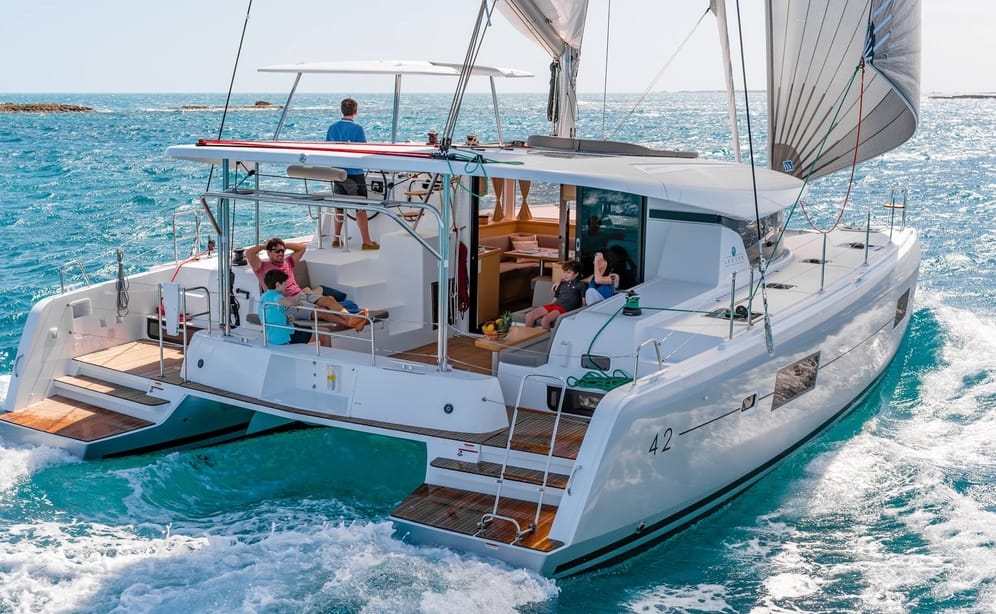
>>Also Read: Best Sailboat Brands
Fountaine Pajot
Fountaine-Pajot is a French maritime construction brand that is specializing in catamarans. The company was established in 1976, but it launched its first sailing catamaran in 1983 and its first powercat in 1998. This brand is now famous for building both sailing and power catamarans that have a beautiful and innovative design, superior handling, excellent seaworthiness, and cruising comfort. Also, Fountaine Pajot was one of the first catamaran brands that was manufacturing their boats with environmental protection in mind. So, all of their models have options to include renewable energy sources. Their ECO-Cruising and SMART-Cruising options considerably reduce their yachts’ carbon footprint and provide the necessary clean energy for their sailboats.
Fountaine-Pajot makes both sailing catamarans and powercats, ranging in length from 40 to 67 feet. It also used to make shorted boats like the Lagoon 380 at 37 feet, but unfortunately, it was discontinued. You can find a Lagoon on the used market starting at $100,000-150,000 (like a 1990-2005 Fountaine Pajot Athena 38) and as high as $3.5 million USD for their top of the line fully spec’d Fountaine Pajot Alegria 67, which comes with a jacuzzi on the front deck.

Leopard is a boatbuilder located in South Africa and produces some of the best and most luxurious catamarans. You will find Fountain Pajor catamarans for sale also under the name “Robertson & Caine” because some Leopard cats are built by Robertson & Caine company. Leopards are mainly designed to be luxurious, big, and comfortable, but that usually comes at a cost, both in price tag and sailing speed and maneuverability.
Leopard Catamarans was established in 2000 their partnership with South African builder Robertson and Caine. This company was manufacturing custom-designed catamarans for the global yacht charter company The Moorings. While Leopard was focusing on sailing catamarans in the beginning, in 2007, they started making powercats as well.
Leopard is always designing their boats to have the optimal balance between interior space and performance, sheltered helm cockpit designed for offshore cruising and single-handed sailing, large lounge areas, optimal comfort, and ease of maintenance.
Nowadays, Leopard is making sailing catamarans between 42 and 58 feet and powercats between 50 and 53 feet. You can find a Leopard on the used market starting at $180,000 (like a Leopard 38) in good condition and as high as $2 million USD for their top of the line fully spec’d Leopard 58; however, they are not as luxurious as some of the other brand’s top-of-the-line models.
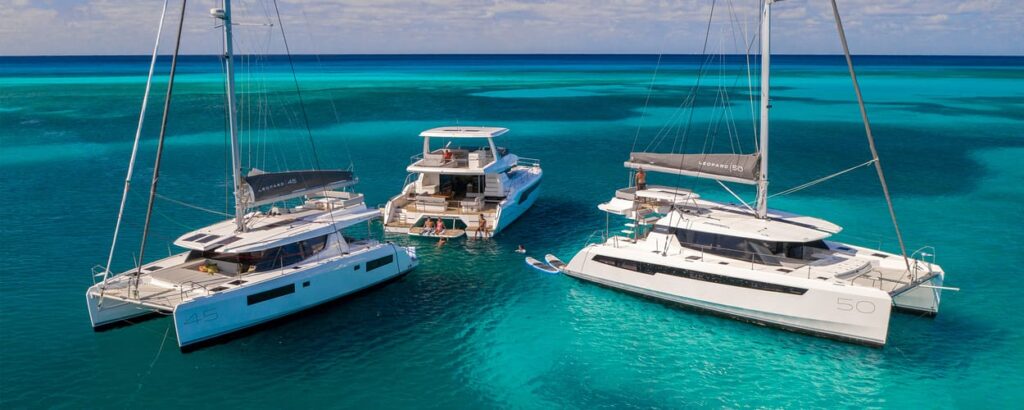
>>Also Read: 10 Best Catamarans Under 200k
Catana catamarans are a little bit more performance-oriented. They have features that make them sail faster and be more easily maneuverable than some of the other catamaran brands on the list. Many of their boats come with a feature called daggerboard that will help you sail faster upwind, something that most catamarans struggle with. Catana Group was originally called Poncin Yachts and has been building catamarans in France since 2001. It is famous for producing catamarans for owners who most often want to go bluewater sailing around the world comfortably and safely with a high-performance boat. This is not a famous brand, but it grows in popularity very fast. Year by year, I have noticed more and more Catana catamarans in the marinas I visit.
Catana Catamarans are built using foam sandwich vacuum infusion technology combined with carbon and aramid fiber. This combination guarantees the strength of the hull, significant weight savings, and because of this fact, higher speed.
Catana offers new boats from 42 to 70 feet. In the past, they were building boats as long as 90 feet. You can find a Catana on from the early 2000s’ on the used market for as low as $250,000, and as high as $4 million USD for a top of the line full spec’d brand new one.
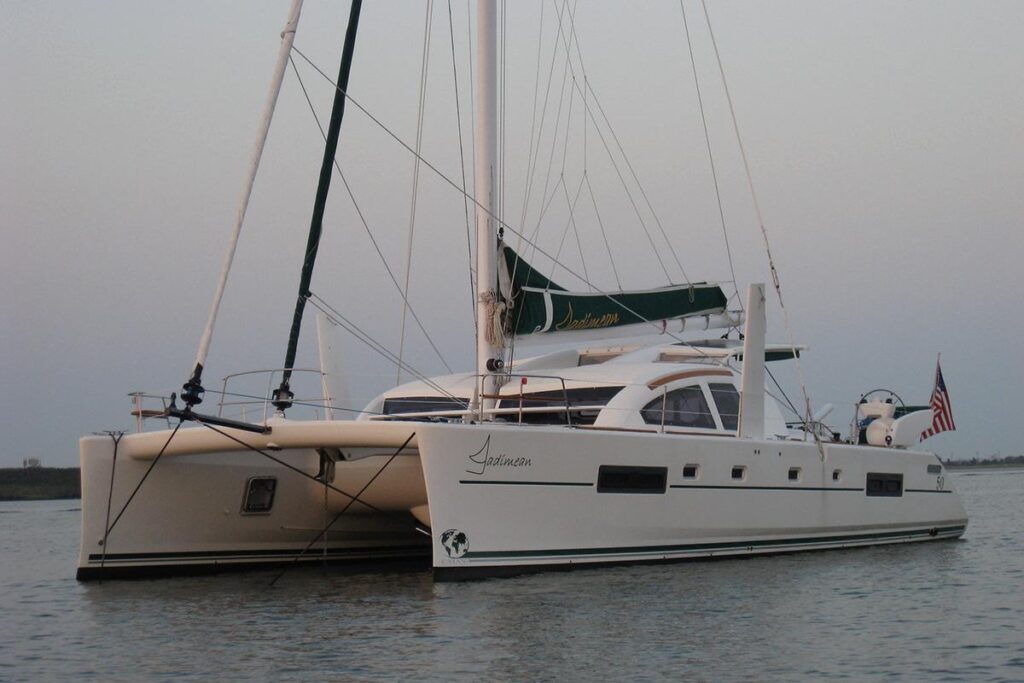
Nautitech is another catamaran brand located in France; I guess there is a pattern here. They have built a reputation for designing catamarans that are robust, seaworthy, and capable of putting sailing back into the heart of the liveaboard experience without compromising on comfort. Anyone familiar with catamarans can quickly appreciate the innovative nature of a Nautitech cat design. The brand was also the first one to introduce the concept of liveaboard living, which combines the saloon and cockpit into one spacious, functional living area.
Nautitech offers new boats from 40 to 57 feet. You can find a Nautitech on from the early 2000s’ on the used market (Like the Nautitech 40) for as low as $180,000. However, a new top-of-the-line Nautitech 54 can be spec’d up to $1.5 million USD; though, they are not as luxurious as some of the other brand’s top-of-the-line models.

The brand was founded in 1985 in France. Privilège Catamarans offer unparalleled expertise, know-how, and experience that facilitates the construction of some of the best catamarans on the market today. They can provide luxurious liveaboard life beyond coastal borders. Its elegant hull design ensures superb stability and comfort making then one of the best catamaran brands in the world right now. Every catamaran is custom-built according to the owner’s preferences and handcrafted with great craftsmanship and the finest materials.
The company specializes in the design and manufacture of some of the best, and luxurious bluewater catamarans on the water. Every new Privilege cat is built after multiple consultations between the shipyard and the owner. You can decide to either keep the catamaran in its pure and elegant look and also keep the cost as low as possible or to change it to your personal preferences and make it as high-end as you can afford.
Privilège makes both sailing catamarans and powercats, ranging in length from 51 to 75 feet. It also used to make shorted boats like the Privilege 435 at 43 feet, but unfortunately, they are now focusing on larger yachts. You can find a Privilege from the early 2000s’ on the used market starting at $300,000 (like the Privilege 435) but can easily surpass $5 million USD for their top of the line fully spec’d Privilege 745 or 740.
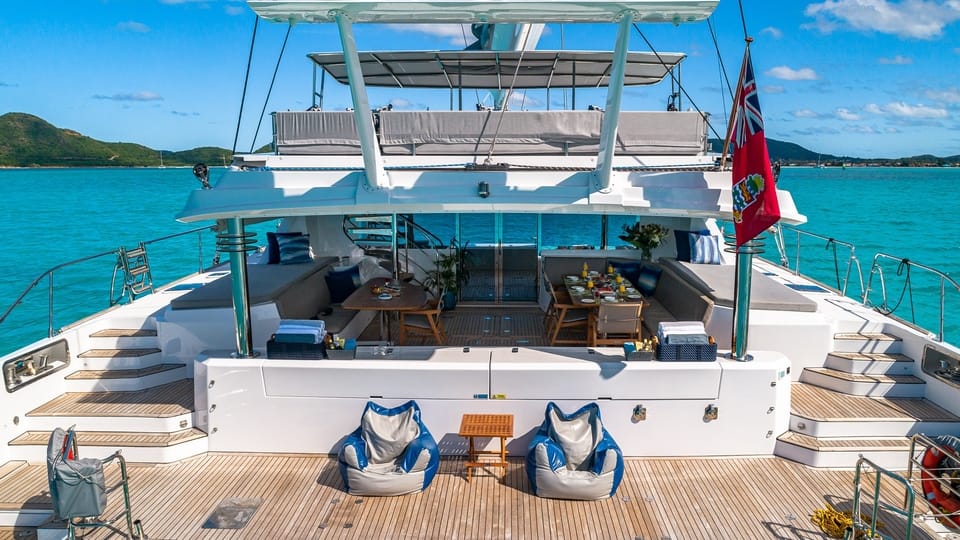
>>Also Read: Best Small Sailboats To Sail Around The World
Gemini
Gemini is one of the few catamaran brands that make its boats in the US. It is a subsidiary of Performance Cruising Inc., and they have been making catamarans since 1981. Honestly, Gemini catamarans might not be the most good-looking and luxurious, but they are affordable and sail well. For that reason, they definitely deserve a spot on the list with the best catamaran brands.
You can find a used Gemini cat in good condition in good condition from the early 1990s, starting at around 50k and a newer model for as high as 500k. Overall this is a very affordable brand, and you will definitely enjoy one without breaking the bank.
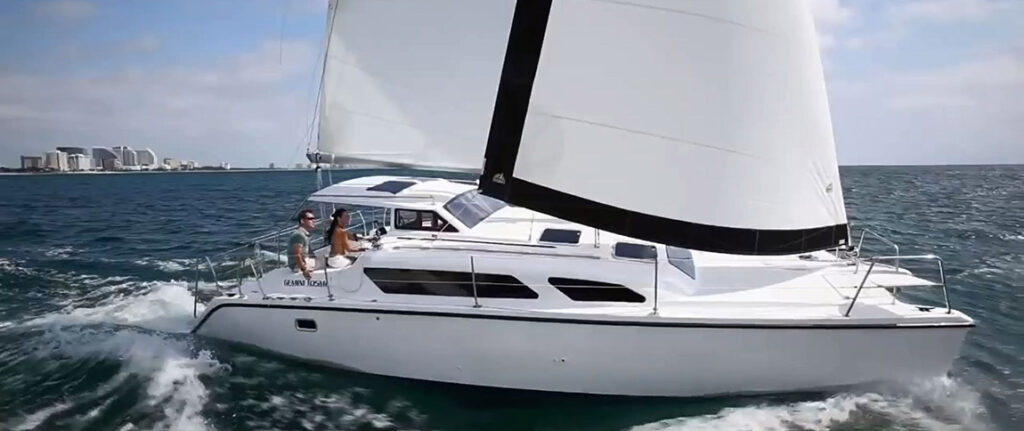
Seawind
Seawind Catamarans is a catamaran designer and builder located in Australia, producing high-end performance cruising sail catamarans since 1982. They have produced some of the world’s best and award-winning designs.
The Seawind brand is especially good for people looking for a catamaran that is not overly luxurious or expensive and is probably looking for a more reasonably sized yacht; however, they do offer a couple of larger, more luxurious models as well.
Seawind offers new boats from 35 to 52 feet. You can find one on from the early 2000s’ on the used market for as low as $150,000, like a Seawind 1000. However, a new top-of-the-line Seawind 1600 can be spec’d up to around $1 million USD.
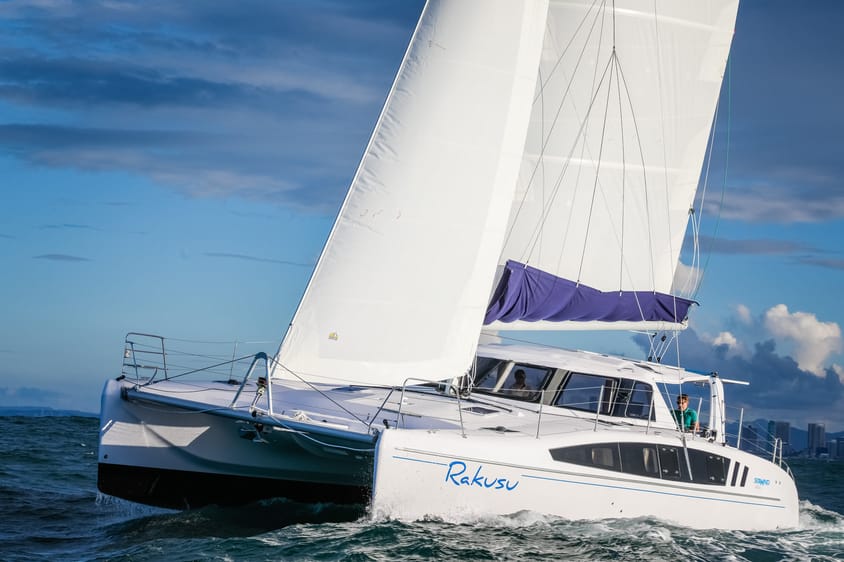
Sunreef Yachts
Sunreef is the world’s leading manufacturer of luxury sailing and power multihulls. Each catamaran, motor yacht, and superyacht they make is a custom vessel. The company was established in 2002 in Gdansk, Poland but a Frenchman and was the first brand to build a 74-foot bluewater cruising catamaran.
This brand has pulled all the stops when it comes to luxury and comfort. Whether you are looking for a family-friendly liveaboard cat, a luxurious private floating villa, a dazzling party boat, or a fishing expedition superyacht fantasy, their designers will turn your vision into reality. Just be prepared to pay the price.
Sunreef makes both large sailing catamarans and powercats, ranging in length from 50 to 150 feet! You can find a Sunreef from the early the Mid-2000s on the used market starting at $700,000 (like the Sunreef 62) but can easily surpass $15 million USD for Sunreef 102. They also have the Sunreef MM460 CAT on their catalog, which is one of the largest catamarans even created. However, unfortunately, I was not able to get even an approximate price quote on it. If I had to guess, I would say at least $50 million to have one built.

>>Also Read: Best Sailboats Under 100k
Bali Catamarans is another brand of the well-known Catana shipyard. And it is also the newest brand on the list established in 2014. Catana catamarans are the golden standard when it comes to high-speed cats. However, in 2014, they decided to start a production brand of fast, light, and easily maneuverable cruising catamarans. The Bali Catamarans collection has a unique design mainly; it has no mesh “trampoline” in the front cockpit. It features an open-space interior, a huge refrigerator in the inner saloon, and many other uncommon features.
Bali offers new boats from 39 to 50 feet. You can find a Bali on from 2014-2015 on the used market for as low as $300k (like the Bali 4.0). However, a new top-of-the-line Bali 5.7 can spec’d up to over a $2 million USD.

Final Thoughts
In order to compile the best list of catamarans, I took into account the built quality, comfort seaworthiness but also the number of yachts for sale on the used market. In my point of view, I shouldn’t have put a custom catamaran builder on this list because you wouldn’t be able to find one for sale anyway. For most of these brands, there are many boats for sale on the used market in pretty good condition and at reasonable prices.
Peter is the editor of Better Sailing. He has sailed for countless hours and has maintained his own boats and sailboats for years. After years of trial and error, he decided to start this website to share the knowledge.
Related Posts

The Ultimate Guide to Choosing the Best Fishing Line for Trolling

Lagoon Catamaran Review: Are Lagoon Catamarans Good?

Best Inboard Boat Engine Brands

Are O’Day Sailboats Good? A Closer Look at a Classic Brand
- Buyer's Guide
- Destinations
- Maintenance
- Sailing Info
Hit enter to search or ESC to close.
Catamarans: A Complete Guide to Multihull Boats
Catamarans have been a part of sailing history for centuries and continue to be popular for their stability, spaciousness, and performance. Developed by various cultures around the world, the principles of catamaran design have evolved over time to become optimized for both pleasure cruising and racing. This complete guide will help you understand the essentials of catamarans, their unique characteristics, and how to choose the right one for your needs.

From the basic concepts of multihull design, performance, and handling, we will explore the advantages and benefits of a catamaran in terms of safety and comfort on board.
Along the way, we will discuss maintenance considerations, distinctive catamaran brands and models, and how a catamaran lifestyle can compare to more traditional sailing options .
Finally, we will provide learning resources and frequently asked questions tailored to both seasoned sailors and newcomers to the world of catamarans.
Key Takeaways
- Catamarans are known for their stability, spaciousness, and performance
- This guide covers aspects like design, handling, safety, and choosing the right catamaran
- Resources and frequently asked questions provide additional insights for potential catamaran owners
Understanding Catamarans
Design Characteristics
Catamarans are known for their unique design, which features two parallel hulls connected by a deck. This design provides several advantages over traditional monohull boats, such as stability and speed.
With their wide beam, catamarans have a reduced risk of capsizing and can access shallow waters due to their shallow drafts 1 .
One of the notable aspects of a catamaran is its twin hulls, which offer increased living space and comfort compared to a monohull. Additionally, catamarans are often favored by recreational and competitive sailors for their excellent maneuverability 2 .
The materials used for constructing catamarans range from wood to fiberglass, and even aluminum for high-performance vessels. Aluminum catamarans are known for their strength, lightweight structure, and resistance to corrosion 3 .
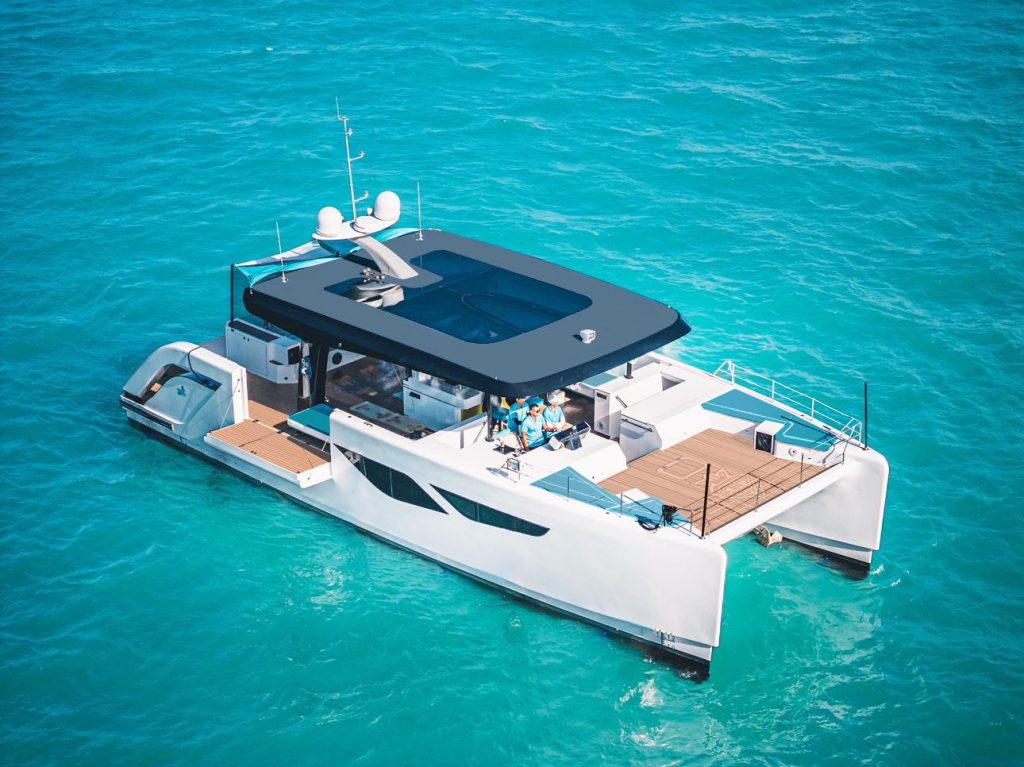
Hulls and Construction
The hulls in a catamaran are crucial to its stability and performance. These hulls help distribute the weight evenly across the water surface, minimizing drag and allowing for smoother sailing.
In general, the hulls can be categorized into two types:
- Symmetrical Hulls : The hull shape is similar on both sides, which enhances balance and stability in various sailing conditions.
- Asymmetrical Hulls : One side of the hull is designed differently than the other, which can be advantageous when sailing upwind.
The construction materials used in building catamaran hulls also play a vital role in the boat's performance and durability. Common materials include:
- Fiberglass : A popular choice due to its lightweight, strength, and ease of maintenance.
- Wood : Traditional material that offers a classic look, but requires more maintenance than fiberglass or aluminum.
- Aluminum : Lightweight and strong, aluminum is an excellent choice for high-performance catamarans 4 .
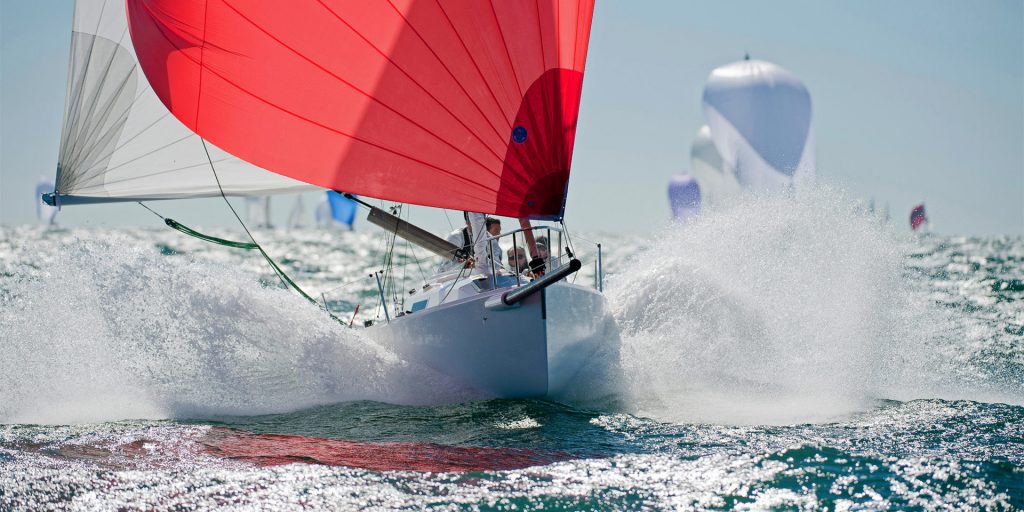
Multihulls vs Monohulls
There's often a debate between the benefits of multihull boats, such as catamarans or trimarans, and monohull boats. Here are some key differences between the two:
- Stability : Due to their wide beam and reduced heeling, catamarans offer improved stability compared to monohulls. This makes them an attractive option for those who want to avoid seasickness or feel more comfortable on the water 5 .
- Speed : Multihull boats are known for their speed, which results from their ability to minimize drag and maintain a level sail.
- Living Space : Catamarans and other multihulls generally have more living space, as both the hulls and the connecting deck can be utilized for accommodation and storage.
- Maneuverability : While monohulls are known for their agility and ability to point close to the wind, catamarans can still offer exceptional maneuverability when properly sailed 6 .
Performance and Handling
Speed and Efficiency
Power catamarans have gained popularity for offering a unique combination of speed, efficiency, and stability. Their dual-hull design allows for less water resistance, which directly translates to higher speeds and better fuel efficiency compared to traditional monohull boats.
In addition, the wide beam provided by the two hulls ensures a stable ride even at higher speeds. This makes power catamarans ideal for cruising, fishing, and watersports ( Boating Beast ).
Sailing Dynamics
When it comes to sailing catamarans , the performance is affected by factors such as keel, rudders, mast, and sails.
Their wide beam and dual-hull design provide inherent stability and reduced heeling effect, making them less likely to capsize compared to monohulls.
I should also note that catamarans have a shallow draft, which gives them the ability to access shallow waters that may be off-limits to other boats ( Navigating the Waters ).
In my experience, the lighter weight of a catamaran and its aerodynamic design can contribute to remarkable sailing performance under different wind conditions.
The larger sail area relative to hull weight allows them to harness more wind power, further enhancing their speed and agility on the water.
Maneuvering and Docking
Maneuvering and docking a power catamaran involves understanding its unique handling characteristics.
The presence of two engines in separate hulls allows for more precise control in confined spaces such as marinas.
The maneuverability of these boats is typically improved by the use of dual rudders that are located close to each powered hull for efficient steering ( BoatUS ).
When docking under power, I find it helpful to carefully assess the wind and current conditions beforehand.
This is because catamarans can be more sensitive to windage due to their larger surface area above the waterline.
By understanding how these forces may affect the boat, I can make adjustments to my approach and successfully dock the catamaran without any incidents.
Safety and Comfort on Board
Safety Features
Safety is a top priority when sailing any type of vessel, including catamarans. A well-built catamaran offers several features aimed at ensuring the safety of those onboard.
First, catamarans have inherent stability due to their wide beam and twin hull design . This makes them less prone to capsizing than monohull boats. This stability allows me to confidently navigate various water conditions .
In addition to stability, catamarans are designed with positive buoyancy, making them almost unsinkable . Of course, safety equipment such as lifejackets, flares, and first aid kits should always be onboard and well-maintained.
Furthermore, you should also stay updated on weather conditions, avoid sailing in high-risk areas, and learn your boat's safe sail limits.
Living Spaces and Comfort
When it comes to living spaces, I value comfort and practicality as essential features for my time on the water. Catamarans offer a unique advantage in this regard, as their dual hulls create spacious living areas.
Most catamarans are designed with separate cabins in each hull, allowing for privacy and comfort when sleeping. Additionally, these boats typically feature shallow drafts , which means I can access shallow waters and anchor close to shore.
The main living area, or salon, is situated on the bridge deck between the hulls. It usually includes a seating area, a dining table, and a galley (kitchen). Large windows provide ample natural light and panoramic views, making the space feel open and bright. Some catamarans even have the option for an additional living area on the upper deck where you can enjoy the sun and breeze.
One aspect of catamaran living I truly appreciate is the ample storage available. Each cabin typically has built-in storage spaces for clothes, gear, and personal items. There are also designated areas for equipment such as spare sails, tools, and water toys. This makes it easy for me to keep my belongings organized and make the most of my time on the water.
Maintaining a Catamaran
Routine Maintenance
In order to keep my catamaran in the best possible shape, I make sure to perform routine maintenance tasks. These tasks are essential to extend the life of the components and ensure smooth sailing:
- Cleaning : Regularly cleaning the deck, hulls, and sails prevents buildup of dirt, algae, and other debris that could affect performance.
- Inspection : Periodically inspecting my catamaran allows me to detect any potential issues before they become significant problems. I pay close attention to the rigging, sails, and lines on my boat.
- Lubrication : Keeping all moving parts lubricated is vital to prevent friction and wear on components such as winches and pulleys.
- Antifouling : Applying antifouling paint to the hulls of my catamaran helps prevent the growth of marine organisms that can damage the boat and reduce its speed. Make sure to do this at least once a year.
Dealing with Wear and Tear
Despite my best efforts to keep my catamaran well-maintained, wear and tear is inevitable. Here's how I deal with common issues that could arise from regular use:
- Repairs : When I notice signs of wear on sails, lines, or rigging components, I make it a priority to repair or replace them promptly. Neglecting these issues can lead to more significant problems and affect the boat's performance.
- Hull maintenance : If I find dents, scratches, or stiff rudders on my catamaran's hulls, I address them immediately. Repairing any damage not only ensures smooth sailing but also prevents further issues from developing.
- Sail care : Over time, my sails can become stretched, torn, or damaged due to exposure to sun, wind, and saltwater. Regularly inspecting them for signs of wear and making any necessary repairs or replacements helps maintain optimal performance.
- Rust and corrosion prevention : Since my catamaran is made of various metal components, I need to protect them from rust and corrosion. I routinely check for signs of corrosion and apply anti-corrosive treatments when needed.
Catamaran Brands and Models
High-Performance Models
In recent years, there has been a growing interest in high-performance catamarans. I have seen a variety of brands and models that have impressed me with their performance capabilities. One notable brand is Fountaine Pajot , which has a long history of producing a range of sailing catamarans and power catamarans. Some of their popular models include the Tanna 47 and the Bali 4.4 .
Another high-performance catamaran I've come across is the Leopard 40 . Known for their speed and exceptional handling in various conditions, the Leopard brand started with sailing catamarans and has since expanded to include power catamarans. Their models range from 40 to 53 feet long, offering both power and luxury for those looking for a thrilling experience on the water.
Cruising Catamarans
When it comes to cruising catamarans, the Lagoon brand is synonymous with luxury and comfort. With a range of sailing catamarans from 40 to 70 feet long, Lagoon offers spacious catamarans for extended bluewater cruising. Their 60- and 70-foot power catamarans are equally impressive, providing ample living space and smooth sailing experiences.
I've also found the Aquila 42 PC to be a remarkable cruising catamaran. With a focus on design and innovation, Aquila has produced catamarans perfect for exploring the open sea with friends and family. Their spacious, stable designs allow for a more enjoyable and serene journey, ensuring you arrive at your destination comfortably.
The Catamaran Lifestyle
Anchoring and Cruising
I find catamarans to be a fantastic choice for cruising and anchoring , which is a critical part of living the catamaran lifestyle . Catamarans have several advantages when it comes to anchoring and cruising, such as:
- Stability : Due to their wide beam and twin hulls, catamarans remain stable during anchoring, which reduces the risk of seasickness.
- Shallow draft : Thanks to their shallow draft , catamarans can anchor close to shore, enabling better access to protected coves and more beautiful beaches.
- Speed : Despite their large size for cruising vessels , catamarans are generally faster than monohulls. This is a result of their slim hulls and reduced water resistance.
When it comes to anchoring, catamarans can make use of their shallow draft to anchor in locations that other boats cannot. This allows for a greater range of cruising spots, which makes the overall experience much more enjoyable and unique.
Living on a Catamaran Full-time
For many catamaran enthusiasts, the dream of living full-time on a catamaran is entirely possible. While not without challenges, there are several factors that make living aboard a catamaran an enjoyable experience:
- Spacious living areas : Catamarans generally have more living area compared to monohulls, providing ample space for the whole crew.
- Privacy : The separate hulls allow for private cabins, ensuring that everyone on board has their space.
- Stability : As mentioned earlier, catamarans are stable vessels, making living on them more comfortable than monohulls.
Choosing Your Catamaran
Comparing Models and Features
When I start to look for the perfect catamaran, the first thing I focus on is comparing various models and features .
I determine the key factors that are essential for my needs, such as size, passenger comfort, and performance. By doing so, I can identify which catamaran models are most suitable for me.
For example, if I plan to sail with a large group, I would look for a catamaran that offers ample space both inside and out.
To help me with my comparisons, I usually create a table or list of the different models and their features:
| Model | Size | Comfort | Performance |
|---|---|---|---|
| A | 40ft | Spacious | High |
| B | 35ft | Average | Average |
| C | 45ft | Luxury | High |
This visual aid makes it easier for me to sort the options and prioritize my considerations, such as price, yacht type, and brand.
New vs. Second-Hand
Another critical aspect of choosing a catamaran is deciding between a new or second-hand boat.
Both options have their pros and cons, and ultimately it depends on my preferences and budget.
If I can afford a new catamaran, I get the advantage of the latest design , features, and technology. Plus, I typically receive better warranty coverage and support from the manufacturer.
However, new catamarans are more expensive and can have long wait times due to high demand.
On the other hand, purchasing a second-hand catamaran can save me a significant amount of money, and I might find a high-quality boat with low mileage or well-maintained by the previous owner.
However, this option carries more risks, as I need to be knowledgeable about potential maintenance issues and conduct a thorough inspection before purchase.
Learning Resources
Books and Manuals
When it comes to learning about catamarans, there are plenty of books and manuals available.
One of the highly recommended books is Multihull Voyaging by Thomas Firth Jones. This book provides a comprehensive understanding of multihulls, including catamarans, and is an essential guide for any beginner sailor.
Another great book to check out is Catamarans: The Complete Guide for Cruising Sailors by Gregor Tarjan.
With a foreword by Charles K. Chiodi, publisher of Multihulls Magazine, this book covers all aspects of cruising catamarans. It includes detailed information on design, construction, and maintenance, as well as tips and tricks for sailing a catamaran.
Here are a few more books that I find valuable:
- The Catamaran Book by Tim Bartlett, an excellent resource for both beginners and experienced sailors
- Catamaran Sailing: From Start to Finish by Phil Berman and Lenny Rudow, a comprehensive guide to both catamaran racing and cruising
Online Content and Photography
In addition to books, you can find plenty of online content and photography about catamarans.
Websites like Sailaway Blog and Boating Guide offer tips, techniques, and how-to articles for sailing catamarans.
Many of these sites also include stunning photography, showcasing these beautiful vessels in action.
For those who prefer Kindle or e-books, many of these resources are available in digital format.
This makes it easier for you to access them anytime, anywhere, allowing you to keep learning and improving your catamaran sailing skills.
To further enhance your knowledge, you can also join online forums and communities dedicated to catamarans.
These platforms provide invaluable advice and first-hand experiences shared by fellow sailors, as well as recommendations for additional learning resources.
Frequently Asked Questions
What factors should be considered when choosing a catamaran for full-time living?
When choosing a catamaran for full-time living, consider its space and layout , as it will become your home.
Look for a design with a comfortable living area , ample storage, and sufficient berths for the number of people living aboard.
Also, consider fuel efficiency , ease of maintenance, and the catamaran's cruising range .
Lastly, the overall cost of ownership , including insurance and mooring fees, should be considered.
How do catamarans perform in rough sea conditions?
In general, catamarans are known for their stability, which is primarily due to their wide beams. This makes them less prone to capsizing when compared to monohulls.
However, their performance in rough sea conditions will depend on the specific model and design of the catamaran. Some may perform better in certain conditions than others, so researching and selecting the right design is essential.
What are the key differences between sailing a catamaran and a monohull?
One of the main differences between catamarans and monohulls is stability.
Catamarans have a wider beam , which makes them more stable and minimizes the risk of capsizing.
They also have shallower drafts, which allow them to access more shallow waters compared to monohulls.
Additionally, catamarans often have larger living spaces, making them more comfortable and suitable for cruising and full-time living.
What are the advantages of catamarans for long-distance cruising?
Catamarans offer several advantages for long-distance cruising.
Their wide, stable design provides a comfortable ride and reduces the risk of seasickness.
They can also attain higher speeds due to their reduced drag and generally sail faster than monohulls on certain points of sail.
The shallow draft allows them to explore more coastal areas and anchor closer to shore. Lastly, their spacious interiors make them ideal for extended cruises and living aboard.
How does one assess the value of a used catamaran on the market?
Assessing the value of a used catamaran requires thorough research and inspection.
Start by comparing the age, model, and condition of the catamaran to similar listings on the market.
Take note of any upgrades or additions made to the boat, as these can affect the price.
It's essential to inspect the boat in person or hire a professional surveyor to ensure there are no hidden issues that could affect its value.
What essential features should be looked for in a catamaran intended for ocean voyages?
For ocean voyages, look for a catamaran with a strong, well-built hull designed to handle rough conditions.
Safety features such as liferafts, adequate flotation, and sturdy deck hardware are crucial.
A reliable engine and well-maintained rigging and sails are also essential.
In terms of living space, opt for a catamaran with a comfortable, spacious interior and ample storage.
Last but not least, good navigation and communication systems are necessary for long-distance ocean voyages.
Related Articles
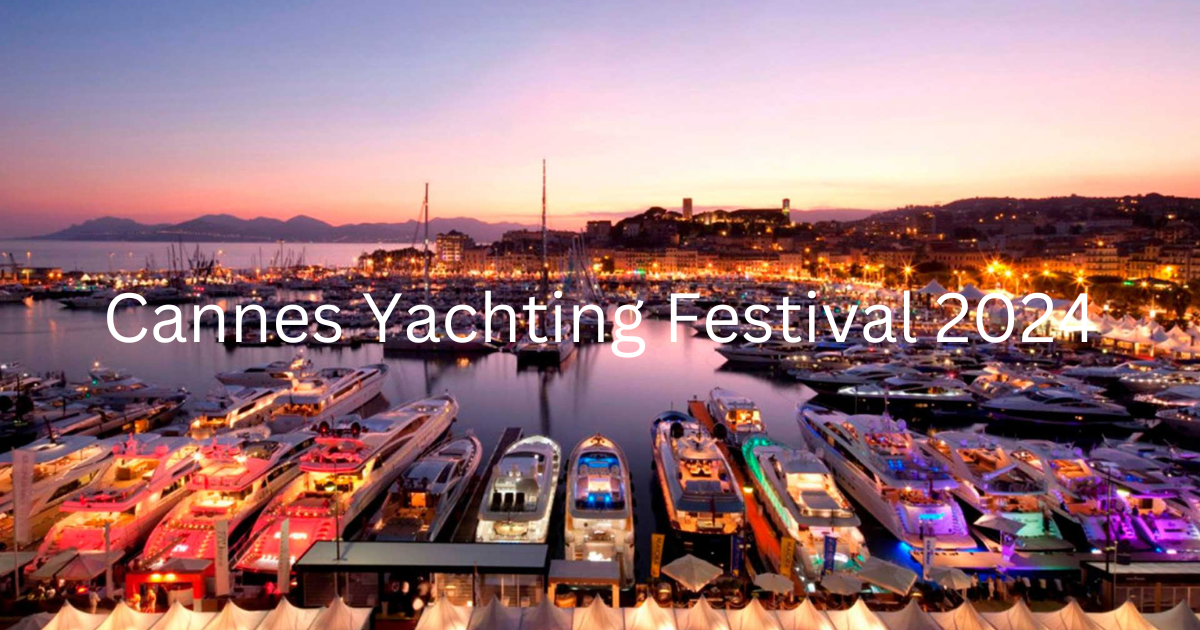
New Boats at Cannes Boat Show 2024: Cutting-Edge Vessels Unveiled

Safe Harbor Marinas Membership & Guide: Your Essential 2023 Handbook

West Palm Beach Boat Show 2024: Insider's Guide and Highlights

Voyaging To The Past
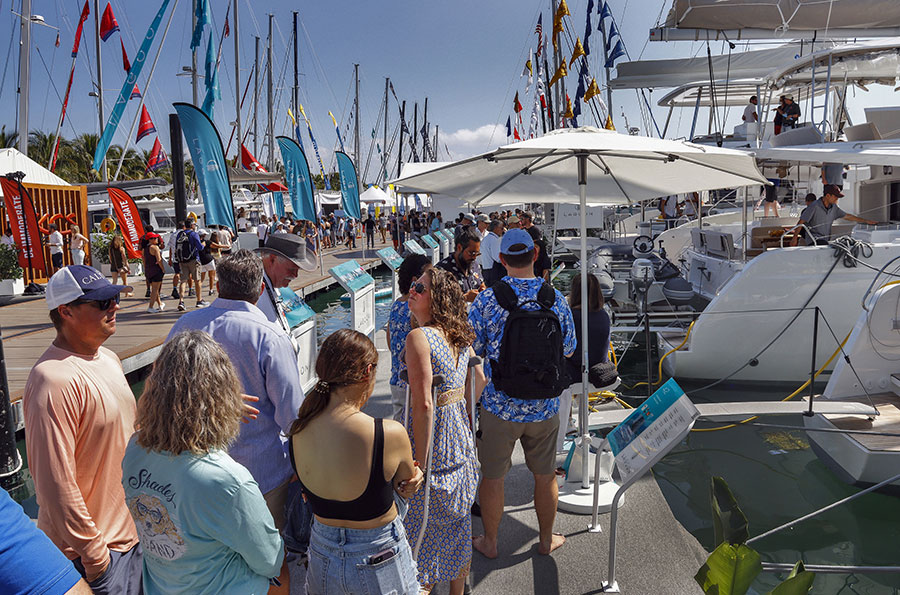
Boat Shows - A Complete List: Comprehensive Guide to All Events
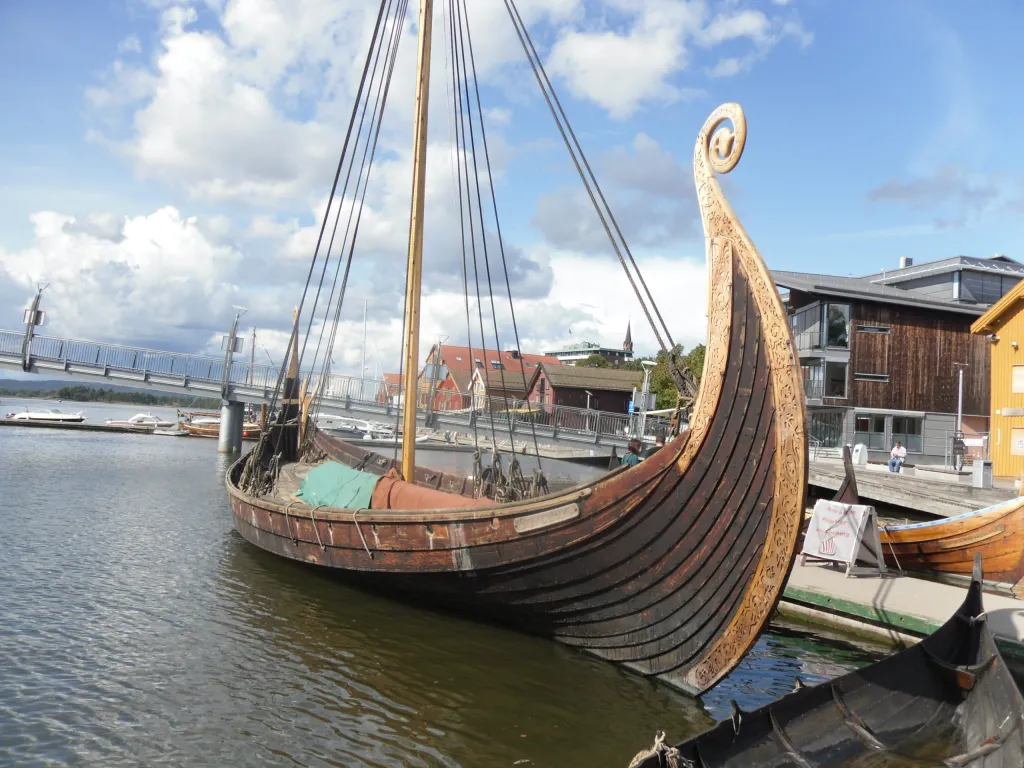
Oseberg Viking Ship: Unveiling the Splendor of Norse Maritime Heritage
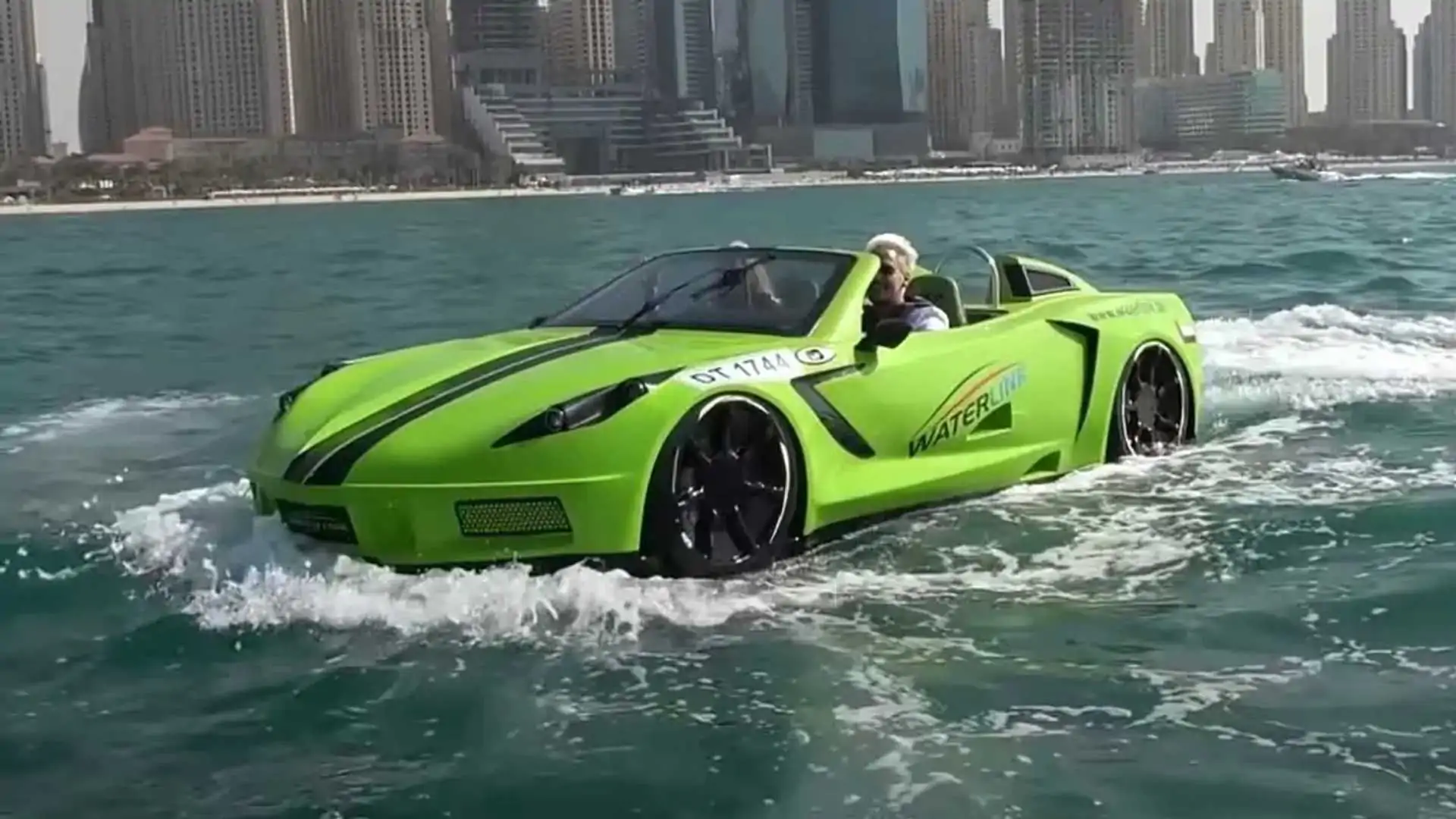
Corvette Boat: A Comprehensive Guide for Enthusiasts
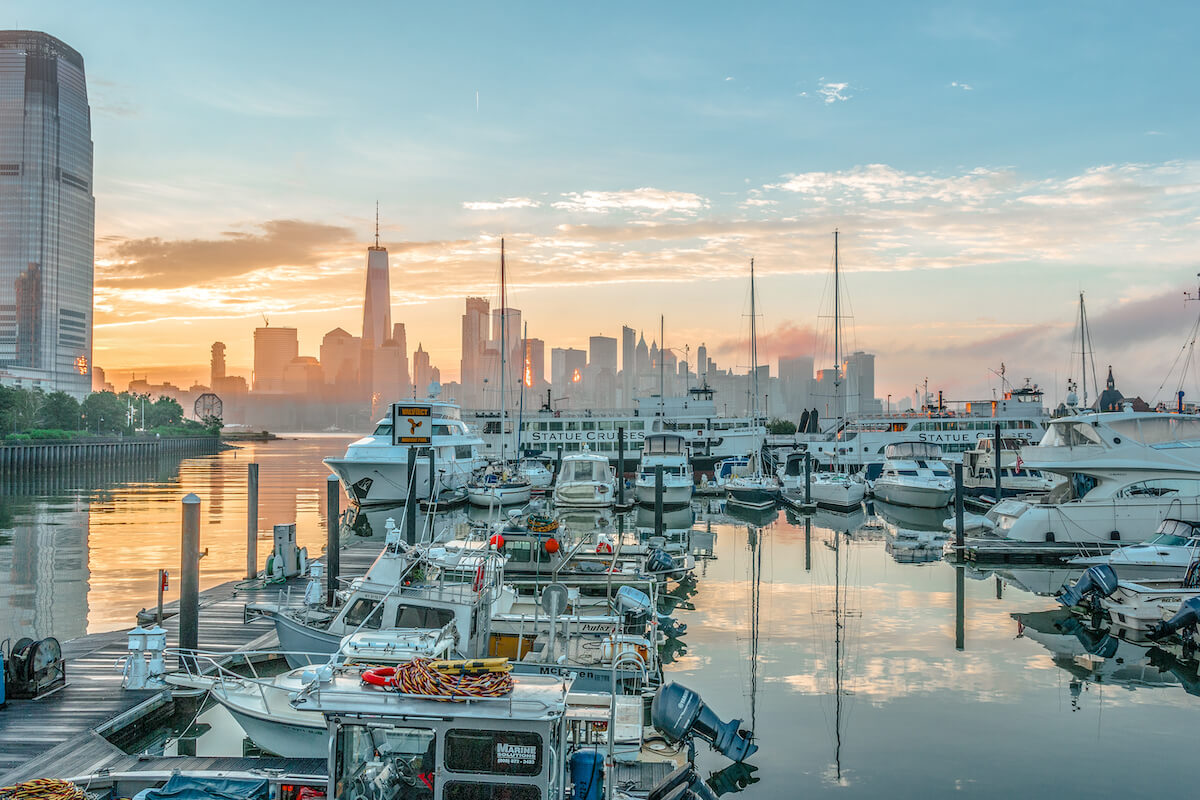
Types of Boats: Comprehensive Guide for Enthusiasts
10 Best Catamarans in 2024

We gave our Sailing writers one job: Find the best and most popular catamarans and review them.
Our review team always considers durability, price, quality, and value in their reviews.

A catamaran is a sailboat that has a multi-hull design. It gives it more stability because it’s wider and that creates more livable space for more people.
Read about the best multihull boats in this article and learn which one is best for your voyages.
The biggest advantages of a multihull are:
- Multihulls are usually faster than monohulls, especially on downwind runs, reaches and broad reaches. You can travel further per day and outrun inclement weather
- They are more stable than a monohull. Sailing flat definitely has its advantages
- It is less tiring sailing a multihull
- More space!
- For cruising the draft is less than a monohull which means you can go into shallower water safely
Top 5 Catamarans in 2024
All the catamarans we've tested.
Lagoon Catamarans

Where to buy:
Where to buy lagoon 40:.
Lagoon has always enjoyed a sweet spot in the 38 to 40-foot catamaran market. The Lagoon 380 became one of the most popular cats ever, with nearly 1,000 hulls being produced over a 20-year run. The L400 and L39 attempted to tweak that popular design, but neither caught on to the extent the 380 did.
The new Lagoon 40 is turning heads for many reasons. The Lagoon 380 is officially off the Lagoon website, so it might finally be time for the torch to be handed to a new cat. And the 40 has just the right mix of modern features, small size, and affordability that many cruisers and families seek.
Here’s a go-anywhere boat that looks good, sails easily, and keeps you comfortable.
- Naval Architects: Van Peteghem-Lauriot Prevost (VPLP Design)
- Built: CNB Yards, Bordeaux, France
- Exterior Designer: Patrick le Quément
- Interior Designer: Nauta Design
- Length Overall: 11.74 m/ 38 feet, 6 inches
- Beam: 6.76 m/ 22 feet, 2 inches
- Draft: 1.35 m/ 4 feet, 5 inches
- Mast Clearance: 18.42 m/ 60 feet, 5 inches
- Sail Area: 80 square meters/ 861 square feet
- Engines: 2 x 29 hp Yanmar 3YM30 (upgradable to 45 hp)
- Fuel: 2 x 200 liters/ 56 gallons
- Fresh Water: 300 liters/ 76 gallons
- CE Certifications: A10/B12/C16/D20
Things we like:
Things we don't like:.
Leopard Catamarans

Where to buy Leopard 42:
The Leopard 42 is the company’s replacement for the 40. It integrates several design elements that were proven on the new 50 and 45-foot models, including an upper lounge area atop the coachroof. The design also has the unique forward salon door that opens for direct access to the foredeck and a sun pad lounging area.
Like all Leopard catamarans, the 42 is not only comfortable to stay on, but it’s also fun to sail. All sailing controls lead to the compact helm. Everything can be handled from this one control station. The full-roach main and overlapping genoa provide plenty of power, and optional electric winches make sail handling a snap.
The Leopard 42 share company in the market for 42-foot cats with some very attractive boats–the Lagoon 42, the Bali 4.2, and the FP Astrea, to name a few.
- Year Launched: 2021 (There have been several designs to carry the "Leopard 42" name)
- Designer: Alex Simonis
- Builder: Robertson and Caine, Cape Town, South Africa
- Length Overall: 41 feet, 7 inches/12.67 meters
- Beam: 23 feet, 1 inch/7.04 meters
- Draft: 4 feet, 7 inches/1.4 meters
- Mast Height: 67 feet, 10 inches/20.68 meters
- Power: 2x Yanmar 45 hp diesel engines
- Fuel: 158 gallons/600 liters
- Water: 174 gallons/660 liters
- Holding: 44 gallons/ 166 liters
- Upwind Total Sail Area: 1,217 square feet/113.1 square meters
Catamarans-Fountaine-Pajot.com
Fountain Pajot 80 Catamaran Superyacht

Where to buy Fountain Pajot 80 Catamaran Superyacht:
Fountaine Pajot, one of the foremost builders of sailing catamarans, unveiled their biggest “ Super Catamaran ” ever: the Thira 80.
The release comes on the tail of an ever-increasing trend in the catamaran market—the bigger-the- better era . With Sunreef, Lagoon, and Gunboat all making boats in the 70 to 80-foot range, these companies clearly see a market for the catamaran superyacht.
Boats this size are easily comparable to a motor yacht of more than 125 feet long. The very wide beam provides cavernous interiors for more livable space. And they have plenty of room for the toys of the trade—tenders, jet skis, paddleboards, and more.
While sailing is always preferable, its 175 to 300-horsepower engines are more than capable of moving it on calm days. And it’s hard to beat the ride and comfort of a catamaran at sea, with its extra stability and lack of heeling in the wind.
So, is bigger really better? Let’s dive in and tour the new Fountaine Pajot 80 and all that she has to offer.
- Length: 78.7 feet/23.98 meters
- Beam: 36.4 feet/11.09 meters
- Draft: 6.9 feet/2.10 meters
- Displacement: 66.0 tons (approximate)
- Sail area Main: 2,153 sqft/200 sqm Genoa 1,507 sqft/140 sqm
- Power options: 2x 175-hp, 270-hp, or 300-hp
Kinetic Catamarans
Kinetic KC54

Where to buy Kinetic KC54:
The Kinetic may be fresh on the scene of the Super Cats but it is on the cutting edge of the finest fast craft in terms of performance and latest technology while also having features, impeccable finishes and the amenities of stylish cruising.
This has been awarded the Cruising World Best Large Multihull 50ft and Above Boat of the Year 2022 as well as the Special Recognition Award – for Overall Excellence 2022 by Sailing Magazine. Said Gerry Douglas of Sailing Magazine: ‘This was the Tesla of sailboats…in terms of design and execution and technology, it hit all three of those marks. This boat is built without compromise’.
These catamarans are all-carbon construction, an aggressively lightweight construction and set up for short-handed sailing. Mast is coachroof mounted and there are options for centreboards and daggerboard. There are three steering stations (two outside aft on each hull, one inside right behind the working cockpit) to suit weather conditions and personal preference.
- Length: 54 ft 2 in
- Beam: 27 ft 7 in
- Draft: Dagger Boards down 10.2 ft
- Standard Rudder up 4.5 ft
- Capacity: 3 or 4 double berths (6-8 persons)
- Motor: 2 x Yanmar 4JH80 - 80hp Diesel SD80
- Fuel Capacity: 264 gal
- Mast height: 85.3 ft (above water)
- Mainsail area: 1,102 sqft
- Fresh Water tank: 264 gal
Xquisite Yachts
Xquisite X5 Plus

Where to buy Xquisite X5 Plus:
2022 saw the Xquisite X5 named the Cruising World magazine’s Best Cruising Catamaran of the year – yet again (it won the Best Multihull over 50ft award in 2017) .
As Ed Sherman said: ‘There are 40,000 man-hours invested in this boat. And you can see it.’ To the bolts that are torqued to the 2 weeks spent with each new owner training them on systems – this is a strong product, well designed by Rudolf Jonker and built by Phoenix Marine incorporating all of Tamas Hamor’s ideas and experience. This really is a well thought out 53 ft cruising sailboat and is another South African-built catamaran loaded with important details, not only the visible ones.
The goal for Xquisite is to supply fully equipped catamarans for long-term live-aboard cruising with comprehensive lifetime service assistance for the owners.
There are so many features from the gutters to catch rain-water on the coachroof to footswitches for the electric winches at the helm. Solid handrails all around the deck for maximum security to the below deck running-rigging network! In terms of the design and construction much thought has gone into weight saving. There is no faulting the systems installations.
All lines lead to the helm through below deck channels that are easily accessible with winches well thought out. The helm is slightly raised to port under a bimini with a sliding fully-battened canvas roof that is easily raised and lowered. There is an overall ambiance of space and light in the berths and galley which opens onto the cockpit.
Sailing performance was impressive with its powerful rig – however a heavy, low-slung cruising cat with keels instead of boards to get to your destination in comfort and style.
See our complete list of the best catamarans here .
- Length: 53 ft
- Beam: 26 ft 2in
- Draft: 4 ft 4’
- Capacity: 3 double berths (6 persons)
- Motor: 2 x 80 HP Yanmar
- Fuel Capacity: 208 gal
- Mast height: 78 ft 7’ (above waterline)
- Mainsail area: 1,130 sqft
- Fresh Water tank: 227 gal
McConaghy Boats
McConaghy MC60

Where to buy McConaghy MC60:
The MC60 is the fastest and most luxurious flybridge catamaran. ‘Think next-gen fighter jet meets a New York style luxury loft apartment.’
McConagy boats was founded by John McConaghy in 1967 and in 2000 Mark Evans & Jono Morris embraced the opportunity to take over the country. They partnered with Tiger Group Investments and have grown from strength to strength – building the world’s fastest racing yachts , submarines, components for Formula One racing and developing solutions for architects, scientists and others. They have a proven track record on complex composite products which are lightweight, corrosion resistant, have design flexibility, durability and high strength.
In the MC60, designed and engineered with safety as priority, this performance sailing meets stylish living with only finest wood veneers and luxurious materials throughout – the wide saloon which offers a versatile but spacious living area, large windows and retractable glass doors aft, a galley well positioned best suited to socialising. The attention is to detail and innovation even in the storage solutions so that living space is maximised with semi-customisation of interiors too. She is the perfect blend of sophistication and high tech.
Sailing is in utmost luxury, effortlessly and safely due to meticulous control of weight. She is much lighter than other similar length cats and can approach cruising speeds close to true wind. A professional crew are required. For sailing there are dual helm positions on the streamlined flybridge for best sight lines. The precise hull forms achieve optimum strength to weight ratio with careful use of carbon which means that under full sail she points upwind like a monohull. The M60 has push button centerboards that raise on impact automatically – certainly one of the safest offshore performance catamarans .
- Length: 60 ft 04 in
- Beam: 28 ft 2 in
- Draft: 4 ft 7 in with centreboards up
- 12 ft 4 in with centreboards down
- Capacity: 2 double berths & 1 - 2 twin (6 - 8 persons)
- Motor: 2 x 57 HP
- Fuel Capacity: 123.19 gal
- Mast height: 92.85 ft
- Mainsail area: 2,034 sqft
- Fresh Water tank: 123.19 gal
Sunreef Yachts

Where to buy Sunreef 80:
Winner in the 2019 Oceanway China Yachts Award, the 2019 Yacht and Aviation Awards and claiming Best of Show Award in the 2020 Miami International Boat Show this mighty fine catamaran justly deserves all and more. It is an all-round sailing leisure yacht for exclusive getaways, charter and transocean adventures and is set up for professional crew.
The Sunreef is built in Poland under management of Founder and CEO Francis Lapp who has been producing large vessels from 50-165 ft since 2002 and knows well what semi-custom cruising is all about.
The Sunreef 80 fuses contemporary design with its layout flowing easily one into another area in ultimate luxury. Custom finishes ensure that you have found your ultimate catamaran – the vast central lounging space with panoramic view opens both onto the bow and cockpit. The cleverly designed bridge deck and superstructure facilitates the superior comfort onboard.
The spacious 54sqm flybridge is the epitome of leisure – a jacuzzi, wet bar, barbecue and large sunpads with the main boom well clear overhead ! It also houses all the navigation. Plenty of relaxation and pleasure space.
The sail controls are well laid out for the twin helms with carbon masts built by Sunreef themselves. The rig is built for power on this well equipped and luxury sailing vessel.
The tall bow has a fine entry aimed at reducing drag while the hulls are designed to reduce drag too while having super volume to accommodate the luxurious cabins are airy and impeccable in style. The master cabin is located midships starboard and is an opulent space while the other cabins each have queen sized beds, spacious en-suites and unquestionable privacy.
- Length: 80 ft
- Beam: 37 ft 7 in
- Draft: 7 ft 218 in
- Capacity: 4 - 5 double berths plus optional crew of 3 (8 - 10 persons plus crew max of 3)
- Motor: 2 x 280 HP John Deeres
- Fuel Capacity: 634.01 to 1585.03 gal
- Mast height: 2185 ft
- Mainsail area: 2152.78 sqft
- Fresh Water tank: 422.68 gal
HH Catamarans
HH50 cruiser

Where to buy HH50 cruiser:
The HH50 is a performance cruiser for the blue water with simple to use but intelligent systems, carbon construction and to top it all luxurious and spacious interior. She offers to best of all worlds – easy to manage sailing vessel which is robustly built, fully equipped and stylishly comfortable for your adventure.
The sailing systems and deck layout are designed for short-handed sailing with dual helm stations each giving the helmsman total sail control from either side and having excellent visibility. The C daggerboards are curved and are fully retractable. Push button mainsheet and self-tacking jib are standard. Equal-to-Wind speed is normal, this is a performance sailing vessel.
The large saloon has a good sized galley and when at anchor the sail handling area converts easily to a comfortable forward facing seating area. The aft cockpit has an integrated wet bar and barbeque – perfect for al fresco entertaining or dining. Luxury queen size beds await in the cabins.
- Length: 51 ft 8 in
- Beam: 24 ft 41 in
- Draft: 5 ft 43 in Board down
- 10 ft 83 in Board up
- Capacity: 2 double berths and 1-2 single (4 - 6 persons)
- Motor: 2 x Yanmar 40HP
- Fuel Capacity: 131.98 gal
- Mast height: 75 ft 36 in
- Mainsail area: 873.28 sqft
- Fresh Water tank: 87.99 gal
Excess Catamarans

Where to buy Excess 11:
This gem earned the title of Cruising World’s Boat of the Year 2021 impressing the judges with its allocation of space all the while offering superior sailing performance. All at a great price.
Using compact space effectively – effectively and seamlessly assimilating working and social areas in a thoughtful, pleasant, workable and innovative way. This is a sure winner for the Excess 11.
The Excess 11 is one of the smallest catamarans as well as the only large-scale production boat of this size, with comfort, space and thrilling sailing. She is comfortable in her simplicity and light style. It is very capable for long passages and meets the needs for life on board, built on the experience of previous models and designs.
Even with her smaller size she offers comfort on deck with a large open cockpit and twin helm stations.
Complete Excess 11 standard features list please email via website
- Length: 37 ft 5 in
- Beam: 21 ft 7 in
- Draft: 3 ft 9 in
- Capacity: 3 - 4 double berths (6 - 8 persons)
- Motor: 2 x 29HP
- Fuel Capacity: 106 gal
- Mast height: 56 ft 8 in
- Mainsail area: 592 sqft
- Fresh Water tank: 79 gal
Bali Catamarans
BALI Catspace

Where to buy BALI Catspace:
The BALI Catspace is the most successful catamaran in her class with the Catspace being the smallest of the BALI range, combining all the latest innovations in cruising. It was nominated for the Cruising World’s best boat of the year: Catamaran under 50 ft, 2022.
The Catspace was conceived by Olivier Poncin & designed by Lasta Design – combining all the latest innovations in cruising into a really neat vessel.
The sailing quality is not to be faulted for a catamaran of this size, the deck which is efficient for sailing allows smooth movement from the aft platform to the forward cockpit with lounge and sunbathing area. There is, in addition a full-comfort flybridge which has a safe relaxation area and a helm station which is designed for single/short handed use.
The 4 cabins each have private heads and the ability to open up the back end of the cats to create the indoor/outdoor platform is well planned and highly effective.
Complete Catspace standard features list
- Length: 40 ft 39 in
- Beam: 21 ft 59 in
- Draft: 3 ft 91 in Boards up
- Motor: 2 x 20HP up to 2 x 40HP
- Fuel Capacity: 107.78 gal
- Mast height: 58 ft 56 in
- Mainsail area: 1,087 sqft
- Fresh Water tank: 167 gal

Big ‘blue water’ Sailing
Blue water sailing refers to the open sea. Non-blue or pond sailing refers to inland waters and coastal areas.
The difference in specific design of a blue water or non-blue water vessel is for the ship captain’s visibility as well as based on the hazards of the area they are to be used. A bluewater (offshore) catamaran is designed for voyages in very rough seas. They are usually 40ft or longer, designed to be very stable, carry heavy loads and very safe. Ocean sailing has different dangers to coastal water with different challenges – sailing through storms, longer distances, more maneuvering space, night sailing – and more gear, better technology, skills and sturdier vessels are needed.
When sailing in confined waters it is important to have more reactive steerage, less maneuvering time, you do not need to store multiday provisions as you are more reliant on daytime sailing, do not need so much speed so have smaller sails and lower horsepower engines and perhaps the intention if for pleasure alone so one of the major considerations will be the layout of the vessel.
For most sailors the choice of size is between 40-50 feet which is manageable for 2 persons with lots of room to spread out and entertain or have friends on board and that is easy to dock both in terms of space and cost.

First questions to ask yourself
First up consider these 5 points before you decide on your multihull model, length and manufacturer.
Will you be using your sailing vessel for coastal or blue water adventures? What is your primary objective and then: is this for family pleasure or entertaining or Charter?
For sailing
Must it be suited for single-handed sailing? What proficiency of sailing do I have/need? Degree of technology required? Equipment required?
Functional Use
How many berths do I need? How much privacy? Elegance, comfort and style – what is required? Space for ‘toys’? If for charter or private use with crew – extra berths.
Your total budget must include the initial cost of the vessel plus survey, transport, upgrading of equipment, insurance, etc – there is a lot to consider. Would a second hand vessel be a consideration? What is the smallest I can go?
Annual Costs
What will my ongoing budget be for Insurance, berthing, maintenance, repairs, haul out fees, etc? This excludes any travel costs
Where do I want to berth my vessel? Or living aboard?
It is said that BOAT is an acronym for: Break Out Another Thousand!

Review of Our Favorite 15 Multihulls 2024
With cutting edge technology and the strive for sail performance this was no easy task – there are many deserving vessels who deserve to be in the Top Reviews such as Privilege 510, Outremer 51, Knysna 500SE and the St Francis 50. There are also other models by manufacturers we have selected that have proven themselves over the years that may be a better size for you.
Here’s our listing!
Related Reviews
Read full review
Final Thoughts
Multihull vessels have a lot of the potential for creature comforts that motor yachts have without the constant thrumming of the engines. But they still require a modicum or rudimentary understanding of sailing.
There’s also a bit of maintenance required, but this is something–like having kids–that you figure out along the way.
Another popular boating segment is the power catamaran. Like their sailing counterparts, power catamaran boats have great living space, but without the need to understand sailing principles. Either way, both multihull markets look to be growing in popularity over the next many years.
The resale market for multihull ships also looks promising, so getting one, trying it out for a couple of seasons and selling it again is a possibility without losing too much on the purchase price.
Before you sign the cheque….
So you’ve located some a catamaran for sale that looks promising. It’s one of the models on the list here and you’re wondering if its in the best shape relative to the price. Here’s what you do:
Take time out to go and view it in person. Book yourself an experience aboard and head over to your closest marina and speak to owners (this may well help you create your shortlist too). Consider these points before purchasing:
- Pre-book buyer’s sea trials for your shortlist
- Select the perfect sailing vessel for you (and if it’s for your family make sure they agree too!)
- Used – get a certified hull survey, safety comes first
- Get annual insurance quotes
- Calculate dockage – purchase or rent a slip or dock
- Calculate monthly upkeep and maintenance
- Calculate extra costs like navigational devices & fittings
- Draft your own checklist
- Draft & sign off sale & purchase contracts
- Draft & sign off a Memorandum of Agreement (MOA)
- Ensure you are satisfied 100%
- Execute payment and take transfer of ownership
- Register and insure your vessel
Check all necessary Stock is aboard – Sail away!
Pre-Departure Checklist
Some ideas for you –
- Always pre-check the weather and wind conditions prior to any excursion on the water
- Always know the tide table in your head, so you know what the ocean is doing at all times, incoming or outgoing tide, and what is the tidal range if you are in an ocean estuary or channel.
- Check you have fuel, water, food and all the basics before loading passengers aboard, and follow these easy steps to ensure safety is first at all times.
- Plan your upcoming voyage, does it feature high swells, rocky shores, and cold water
- Check Safety equipment, making sure you have enough life jackets for all sea-farers
- Check sails, sheets and lines. All sailing gear
- Check your engines – Open fuel lines, check oil and spark plugs
- Check fuel tank levels and have extra fuel aboard for an emergency
- Start the motor, make sure water is coming out to cool the motor
- Test both forward and reverse gears on the engine before guests board
- Check that you have a working and full battery communications radio, with all correct channels programmed, and that all the vessel lights and electrics are in working order
- Check for first aid kits, manual hand pump, paddles, lifejackets , additional lines, fresh drinking water and food for passengers plus some spare in case your voyage is longer than expected, necessary repair tools & kit and flags
- Strap any equipment and gear down safely before you start to motor
- If you have passengers boarding, ensure you give a proper safety briefing and point out where all the safety gear is on the vessel. Children should be included in the briefing and be secured properly before departure
Catamarans versus Trimarans
Trimarans have limited space in slimmer hull designs generally. This makes Catamarans with their comfortable open leisure space both above and below deck far preferred for leisure sailing.
On the plus side for Trimarans are their speed and seaworthiness.
How Safe are Multihull Boats at Sea?
Probably a close second in terms of questions asked. On a twin hull design the buoyancy is on the outer edges of the boat and their is greater stability and less rolling when drifting or trolling compared to a monohull.
Catamarans are safe in rough seas because of their wide stance which makes them stable with increased motion comfort and excess buoyancy due to lack of ballast. They are easy to maneuver and with high speeds that may help them outrun storms with skilled crew who know the vessel. A trimaran is the safest of multihulls with the 3 hulls, centering of its weight and anti-drift plan. The righting torque between a catamaran and trimaran is significantly different.
An important consideration is this – if your catamaran is anything longer than 45ft, unless specifically modified for single handed sailing, then it probably cannot be sailed alone. At some stage in your journey you may well have to sail alone – can it be done?
As Blue Water Sailing Vessels
Catamarans are more stable and fast and depending on conditions some can distance more than 200 miles in a day.
Cats usually sail faster than monohulls (standard) due to the weight of them and displacement, especially on a run or broad reach when the sails are perpendicular to the wind. There are many variables to consider.

Solo Sailing a Multihull
Most small and medium-sized cruising catamarans can be sailed single-handedly. The skill of the sailor with high tech equipment such as electric winches and powered sail control, layout (such as all lines to the cockpit, roller furling mainsail, autopilot, etc) and safety precautions make it an adventure not to be missed.
If your catamaran is longer than 45ft, unless specifically modified for single-handed sailing, you will not be able to safely sail it alone. Consider:
- What the minimum length of the vessel would suit your needs to handle on your own
- Layout planning is essential
- Space you need
- The bigger the boat means larger sails which will be harder to raise and repair
- The bigger the boat means more power and speed – be comfortable with your vessel
- Update your sailing skills
Finding the Right Size
It is a very personal choice but at the very least the advice would be to buy the smallest catamaran you think would meet your needs – this is because you have many other costs to consider and the bigger the vessel the more the costs of upkeep, dockage, space for crew.
A perfect size for blue water sailing (including around the world) is around 40 ft, small enough to be sailed by one person but big enough to provide safety and speed. The smallest size to consider to cross the ocean safely and in some comfort by consensus is around 30ft. Any smaller and you will possibly have the following problems as dealing with large seas the size of your vessel does count :
- A smaller vessel is always pitching and yawing and this impacts the crew negatively over a long period of time or in crisis situations
- Low bridge deck clearance due to the small size of the vessel
- when sailing upwind the waves are projected with speed and force into the decks understand (between the pontoons) creating bridge deck slamming. This vibration and noise impacts the crew and is very tiring – sailing downwind to prevent this may not be where you want to go
- Not having enough space for all the supplies and equipment needed for a long passage
- Alongside the problem of weight to be carried is the problem of distribution of this weight over the length of the vessel safely
Multihulls best for ponds, slow rivers and calm bodies of inland water benefit from having flat hulls to provide shallow draft with great deck space manufactured from aluminium or fibreglass. Make sure you take extra food and water and all safety supplies just in case of an emergency!
The question everyone wants to know – how much does it cost to live onboard?
There are many variables depending on your lifestyle, where you intend to cruise or berth and how much you want to travel aboard. A good estimate would be between US$2000-US$5000 per month for a family of 4, a little less for a couple/single person plus the maintenance cost of your boat which is on average 5-10% of the cost of the boat. The maintenance of your boat varies depending of equipment, age, condition and size.
What do I need to consider differently to live on-board rather than racing ?
Racing vessels are designed for speed and exhilaration and safe fun.
Living on-board requires space and comfort – space for storage, large-sized comfortable berths, living space, entertaining space, home-space! You need to know your long term goals and what your personal needs are – do you need a dedicated work area or desk space/permanent interconnectivity for work?
Generally cruising catamarans have wider hulls which give you more space as well as creating more drag which slows your boat down and is more costly on fuel.
Many used charter boats are seen as great purchases for living on-board, however make sure that they are suited for blue water sailing and not only for coastal water.
Here’s a list of the Top 15 best Multihulls reviewed in this article:
- Leopard Catamarans – 41 ft 7 in – Leopard 42
- Balance Yachts – 48 ft 26 in – Balance 482
- Kinetic Catamarans – 54 ft 2 in – Kinetic KC54
- Xquisite Yachts – 53 ft – Xquisite X5
- McConaughey – 60 ft 1 in – MC60
- Sunreef Yachts – 80 ft – Sunreef 80
- Leopard Catamarans – 50 ft 6 in – Leopard 50
- Voyage Yachts – 57 ft 42 in – Voyage 590
- Seawind – 52 ft 8 in – Seawind 1600
- HH Catamarans – 52 ft – HH50
- Fountaine Pajot – 39 ft 14 in – Isla 40
- Lagoon-Beneteau Group – 38 ft 5 in – Lagoon 40
- Excess Catamarans – 37 ft 2 in – Excess 11
- Maverick Yachts of SA – 44 ft – Maverick 440
- Chantier CATANA – 37 ft 5 in – Catspace
Frequently asked questions about Catamarans
This varies greatly, often defined used or new by the design, size, year and finish. Quality vessels are built to last and retain market-related value if undamaged.
On average a 45-foot catamaran can range from US$250,000-US$1,000,000.
The fully loaded Isla 40 costs around US$527,000. The Balance 42 sail away price fully cruise equipped is US$1,450,000 while the Kinetic 54’s price tag approaches US$3,000,000. The modern styled Sunreef 80 costs around $6.2 million.
We think that the Seawind 1600 is, for its size and quality, a superb priced performance product at US$900,000.
One of the major benefits for a cruising vessel is to be able to enter shallower seas – catamarans have a shallower draft than monohulls and therefore a great appeal to folk for whom this is a major consideration. Most lagoons are only 6-8 feet deep in the South Pacific. The Caribbean and other areas where you have reefs to navigate and shallow sandbanks to cross to enter overnight anchor stops draft is a very important consideration. Always remember to read your tide tables and swell.
A catamaran is lighter on the water and therefore takes less energy to move, however they have 2 engines which drives up fuel costs. They are more fuel-efficient on flat water (compared to equal horsepower and number of engines) but in heavy weather the monohull’s hull design causes less resistance and therefore higher efficiency.
With lighter weight and high buoyancy generally they have low water drag by comparison to the displacement of a monohull of the same length.
The trampoline serves many purposes – primarily to allow water to quickly pass through, allowing the bow to rise and so preventing the vessel from flipping and they are ideal for pleasure purposes.
To sail around the world the vessel needs to be equipped for offshore cruising and have a heavy load capacity.
The bigger Modern blue water cats are built with this in mind – supplies, crew, technology and gear.
A bigger boat has many advantages such as speed (not only to travel longer distance in shorter time but also to outrun potential bad weather) and comfort space, space for crew and friends, storage space for supplies and fun equipment, etc.
It is important to balance price against comforts, maintenance and repair costs as well as any potential income from your vessel (chartering, Air BNB, hosting courses on-board, etc) – generally here the bigger your vessel the higher the potential for greater income.
The larger your vessel the higher your expenses are in all ways – from Insurance to berthing, maintenance, haul out fees and equipment.
On this page
Table of content:, breadcrumbs.
- / Catamarans
Continue reading

Monterey 224FS

VIVOHOME Vinyl Boat Fender

Orion Safety 865

Everglades 243cc Bay
Gallery of catamarans review.

Three sailboats racing in the Indian Ocean

- Waterproof Backpacks
- Duffel Bags
- Hiking Backpacks
- Waterproof Gear
- Teepee Tents
- Camping Chairs
- Heated Socks
- Marine Binoculars
- Night Vision Goggles
- Windbreaker Jackets
- Collapsible and Folding Wagons
- Portable Power Stations

- Dive Computer
- Scuba Diving BCD
- Scuba Regulators
- Freediving Fins
- Diving Wetsuits
- Women’s Wetsuits
- Scuba Diving Drysuits
- Rebreathers
- Scuba Diving Masks
- Snorkel Masks
- Full Face Diving Mask
- Full Face Snorkel Masks
- Prescription Dive Masks
- Prescription Snorkel Masks
- Snorkeling Gear
- Kids Wetsuits
- Seiko Dive Watches
- Best Underwater Cameras
- Waterproof Cameras
- Underwater Scooters
- Best Dive Knife
- Dive Lights
- Underwater Metal Detector
- Reef Safe Sunscreen
- Scuba Tanks
- Dive Destinations
- Liveaboards

- Paddle boards (SUP)
- Best Touring Paddle Boards
- Best Beginner Paddle Boards
- Motorized paddle boards
- Electric SUP Pumps
- Paddles For Paddle Boarding

- Beach Chairs
- Beach Umbrellas
- Beach Wagons
- Beach Tents
- Beach Canopy
- Beach Towels
- Beach Blankets
- Water Shoes
- Water Socks
- Boogie Boards

- Swimming Goggles
- Swimming Fins
- Swimming Earplugs
- Women’s Swim Shorts
- Getting into Sailing
- Life Jackets
- Marine Flares
- Waterproof Marine Radios
- Pontoon Boat Accessories
- Sailing Gloves
- Boat Fenders

- Inflatable Kayak
- Folding Kayaks
- Tandem Kayaks
- Sit On Top Kayaks
- Sea Touring Kayaks
- Ocean Kayak
- Pedal Kayaks
- Fishing Kayaks
- Kayak Life Vests
- Kayak Shoes
- Kayak Paddles
- Kayak Trailers
- Kayak Anchors
- How to Choose a Kayak – A Beginner’s Guide
- How To Choose a Kayak Paddle? [What You Need to Know]
- Kayaking Gear for Beginners
- What to Wear Kayaking
- Kayak Safety

- All Mountain Snowboards
- Snowboard Boots
- Snowboard Bindings
- Snowboard Helmets
- Snowboard Jackets
- Atomic Skis
- Blizzard Skis
- Ski Resorts in the US

- Travel Backpacks
- Weekender Bags
- Packing Cubes
- Suitcases and Travel Luggages
- The Best All-inclusive Resorts in the World

- Men’s Yoga Pants
- Yoga Shorts
- Yoga Mat Bags
- Yoga Blocks
- Laptop Backpack
- Mini Backpacks
- Mesh Backpacks
- Clear Backpacks
- Fanny Packs
- Water Bottles

- Waterproof Jacket
- Waterproof Pants
- Waterproof Watches
- Waterproof Headphones
- Snorkel Fins
- Best Snorkels
- Best Dive Sites in the World
- Best Dive Resorts in the World
- Central & South America
- North America
- Southeast Asia
- Indian Ocean
- Asia Pacific
- Middle East & Red Sea
- All Liveaboards
- Liveaboards in Australia
- Liveaboards in Fiji
- Liveaboards in Micronesia
- Liveaboards in Myanmar (Burma)
- Liveaboards in the Maldives
- Liveaboards in the Philippines
- Liveaboards in Egypt
- Liveaboards in Costa Rica
- Liveaboards in Belize
- Liveaboards in Mexico
- Liveaboards in the Galapagos Islands
- Aggressor Liveaboards
- Liveaboard in Thailand
- Liveaboards in Indonesia
- The Best Starboard Paddle Boards: A Brand Guide
- Bluefin Paddle Boards: A Brand Guide
- Isle Paddle Boards: A Brand Guide
- Red Paddle Co. Ride 10’6
- ROC Paddle Boards: A Brand Guide
- The Best iRocker Paddle Boards: A Brand Guide
- Blackfin Paddle Boards
- Pontoon Boats
- Bowrider Boats
- Motor Yachts
- Cabin Cruiser Boats
- Inflatable Boats
- Electric Surfboard
- Efoil Board
- Jet Body Boards
- All-Mountain Skis
- Ski Bindings
- Ski Poles for Downhill & Touring
- Ski Goggles
- Ski Gloves and Mittens
- Ski Jackets
- Ski and Snowboarding Pants and Bibs
- Ski Helmets
- Best Resorts in North America
- Whistler Blackcomb Ski Resort
- Copper Mountain Ski Resort
- Mammoth Mountain Ski Resort Area Review
- Jackson Hole Ski Resort
- Telluride Ski Resort
- Aspen Ski Resort
- Crested Butte Ski Resort
- Kirkwood Ski Resort
- Alta Ski Resor
- Park City Ski Resort
- Winter Park Resort
- Breckenridge Ski Resort
- Vail Ski Resort
- Snowmass Ski Resort
- Heavenly Ski Resort
- Taos Ski Valley
- Palisades Tahoe Ski Resort
- Ski Santa Fe
- Angel Fire Ski Resort
- Sun Valley Ski resort
- All-Inclusive Resorts in Aruba
- All-Inclusive Resorts in Cabo
- All-inclusive resort in Cancun
- All-Inclusive Resorts In Costa Rica
- All-Inclusive Resorts in Cozumel
- All-Inclusive Resorts in Hawaii
- All-Inclusive Resorts in Mexico
- All-Inclusive Puerto Rico Resorts
- All-Inclusive Resorts in Tulum
- All-Inclusive Resorts in Turks and Caicos
- Best Diving in the Caribbean
- Diving in Guadeloupe
- Diving in Aruba
- Diving in Antigua and Barbuda
- Diving in the Bahamas
- Diving in Barbados
- Diving in Bonaire
- Diving in the British Virgin Islands
- Diving in Cayman Islands
- Diving in Cuba
- Diving in Curacao
- Diving in Dominican Republic
- Diving in Grenada
- Diving in Jamaica
- Diving in Martinique
- Diving in Puerto Rico
- Diving in St. Maarten
- Diving in St. Lucia
- Diving in Tobago
- Diving in the Turks and Caicos
- Diving in Belize
- Diving in Costa Rica
- Diving in the Galapagos Islands
- Diving in Mexico
- Diving in Roatan Honduras
- Diving in California
- Diving in Florida
- Diving in North Carolina
- Best Diving in Southeast Asia
- Diving in Thailand
- Diving in the Philippines
- Diving in Indonesia
- Diving in Vietnam
- Diving in Cambodia
- Diving in the Maldives
- Diving in Australia
- Diving in Japan
- Diving in Fiji
- Best Diving in Europe
- Diving in Mallorca
- Diving in Malta
- Diving In Denmark
- Diving in Egypt
- All Liveaboards in Thailand
- Liveaboards in the Similan Islands
- All Liveaboards in Indonesia
- Liveaboards in Komodo
- Women’s Life Vest
- All-Inclusive Resorts in Playa del Carmen
- All Diving in Mexico
- Diving in Cozumel
- Diving In Similan Islands – Khao Lak Area
- Diving in Malapascua
- All the Diving in Indonesia
- Diving in Bali
- Diving in Gili Islands
- Diving in Komodo
- Diving in Sulawesi
- Diving in Raja Ampat
- All Diving in Australia
- Diving In Brothers Islands
Paddle boarding
Everyday Life
- BOAT OF THE YEAR
- Newsletters
- Sailboat Reviews
- Boating Safety
- Sails and Rigging
- Maintenance
- Sailing Totem
- Sailor & Galley
- Living Aboard
- Destinations
- Gear & Electronics
- Charter Resources
- Ultimate Boating Giveaway

2022 Boat of the Year: Best Performance Catamaran
- By Cruising World Editors
- December 15, 2021
During and in the four days immediately following the US Sailboat show in Annapolis, Maryland, the Cruising World judges inspected and sailed on 27 boats vying for recognition. Learn more about the boats in our 2022 Boat of the Year »
OK, confession time. When the roster of nominees for the 2022 Boat of the Year awards was released, the contest’s team and judging panel couldn’t help themselves, and quietly put three check marks, little symbols of anticipation, alongside a trio of boats: the untamed cats that would vie for the title of best performer in their class. After all, both Balance and Seawind had entered the winner’s circle in previous BOTY competitions, and it was clear they’d have a serious contender for the throne in yet another player from cat-crazy South Africa, the Kinetic KC54. How’d it go? Let’s just say, nobody was disappointed. The conditions on Chesapeake Bay were ideal for putting the three nominees through their paces, and the trio of scalded cats all acquitted themselves superbly.
For 2022, if anything, the trend for flybridge catamarans is on a major upswing. New cats for 2022 from both Lagoon and Fountaine Pajot continued down that design path, putting an emphasis on living accommodations, not performance. But not aboard the latest Seawind 1600 , a brand originally built in Australia that is now produced in Vietnam. And that suits judge Tim Murphy just fine. “This boat was very dialed in,” he said, “and one place Seawind has always been innovative is with their helms. This one was really great; it was -outboard and aft with great visibility, sort of half-protected where you could step in and out. There was also good access to the boom and mainsail, which you don’t always see on cats. The deck layout was excellent, particularly the forward trampolines. Some cats have lacings with large openings where you can twist an ankle, but these were nice and tight.”
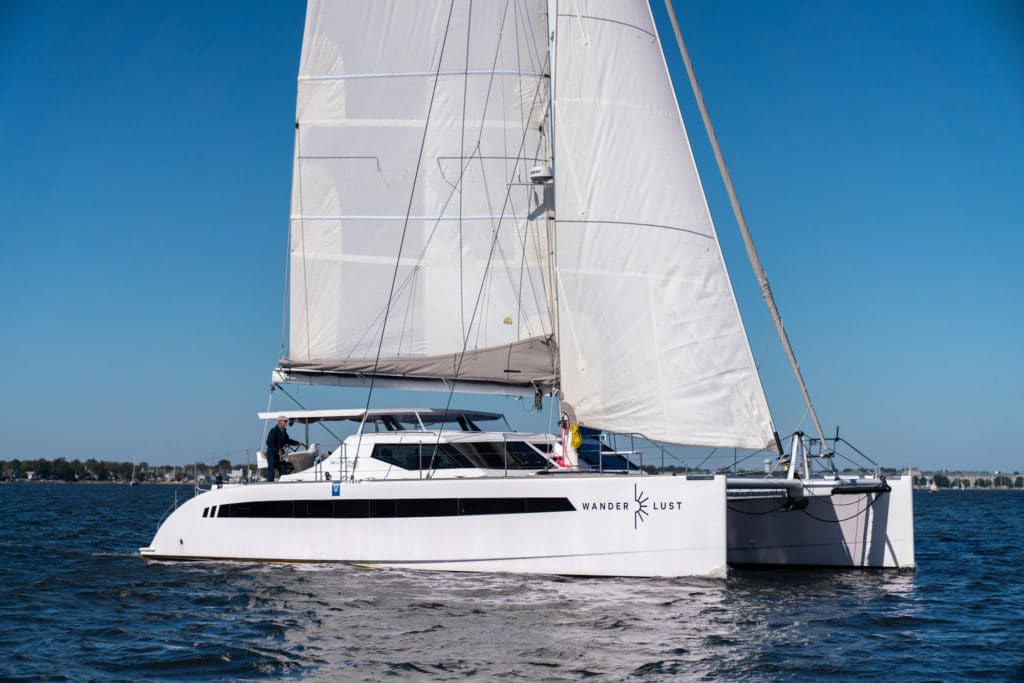
“Compared to other Seawinds that I’ve seen, I was just blown away with it in terms of what it could do and how it performed,” said Ed Sherman. “It’s a fairly conservative boat in terms of technology compared to some of the other boats in the same category, which depending on a potential buyer’s state of mind, could be either a good thing or a bad one. I loved the centralized winch aft which is where all the sail-handling takes place. It’s pretty brilliant for a short-handed crew, and it’s all in a very safe and easy-to-access location that a cruising couple can deal with without scaring the heck out of themselves.”
The Kinetic KC54 is a fresh entry in the cat universe, and we’ll let Tim Murphy get right to the point: “This is a fairly new company that was started within the past couple of years. My breath was absolutely taken away by this boat; it was spectacular. I think it was the best-built boat in the entire fleet. It’s an all-carbon boat, with a foam core, epoxy resin, all infused–fantastic. The whole boat felt integrated. You didn’t feel like there was a conflict between the forces in terms of accommodation versus performance.” With a price tag approaching $3 million, it perhaps should not be astonishing. That was a major factor in evaluating the boat, and while it did not win its class, the experts panel did present it with a Judges’ Special Recognition prize to honor the boat’s overall excellence.
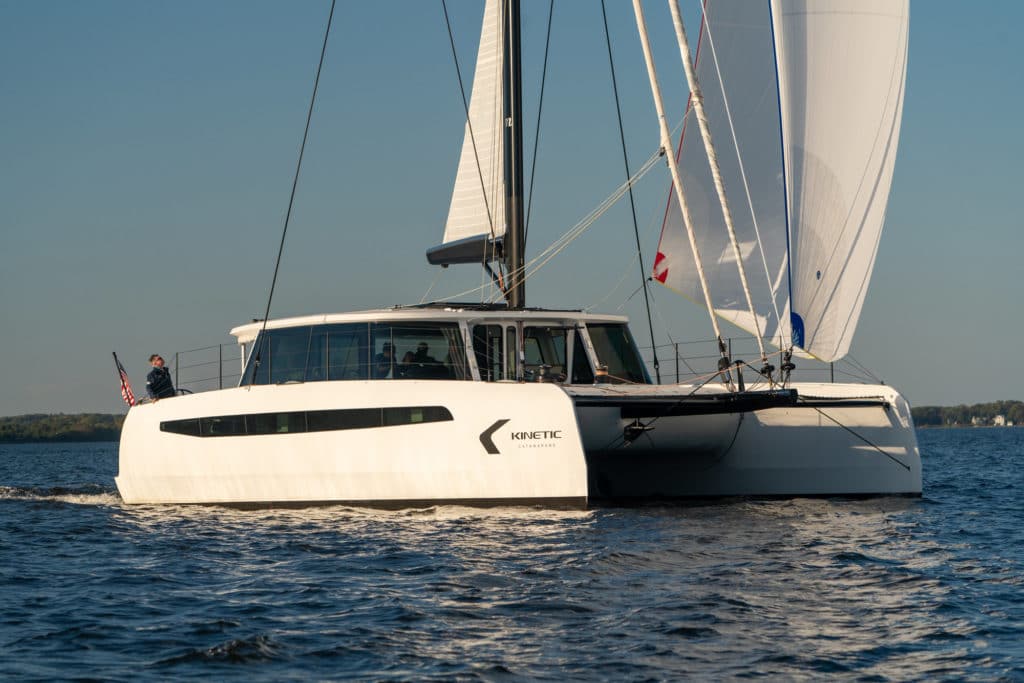
“It was my personal favorite in this year’s contest,” said Sherman. The materials that were used are absolutely the highest quality available in our industry at this point, and it’s a very high-tech boat in terms of systems.” Gerry Douglas was also duly impressed: “This was the Tesla of sailboats. I think that that was their model. In terms of design and execution and technology, it hit all three of those marks. This boat is built without compromise, and what it cost was not an issue, they just wanted to do the best they could in every aspect of the boat. The construction was impeccable, the fit and finish was amazing. There are some very clever design things in the boat, but it all really worked seamlessly.”
With that level of competition, the Balance 482 had a tall order to overcome to win its class. And it did. “The sailing performance was excellent,” said Douglas. “The boat felt really good. The steering was terrific. The structure of the boat throughout was exemplary. Storage is really good. Visibility was good. Ventilation was great. There was even a rain collection system on the cabin top, which is the only one of the boats we looked at had that. It was very well concealed because the gutters formed a handhold going forward. The solar panel installation was also well done. The panels were encapsulated into a fiberglass tray that elevated the deck so the panels wouldn’t overheat. Very clever.”
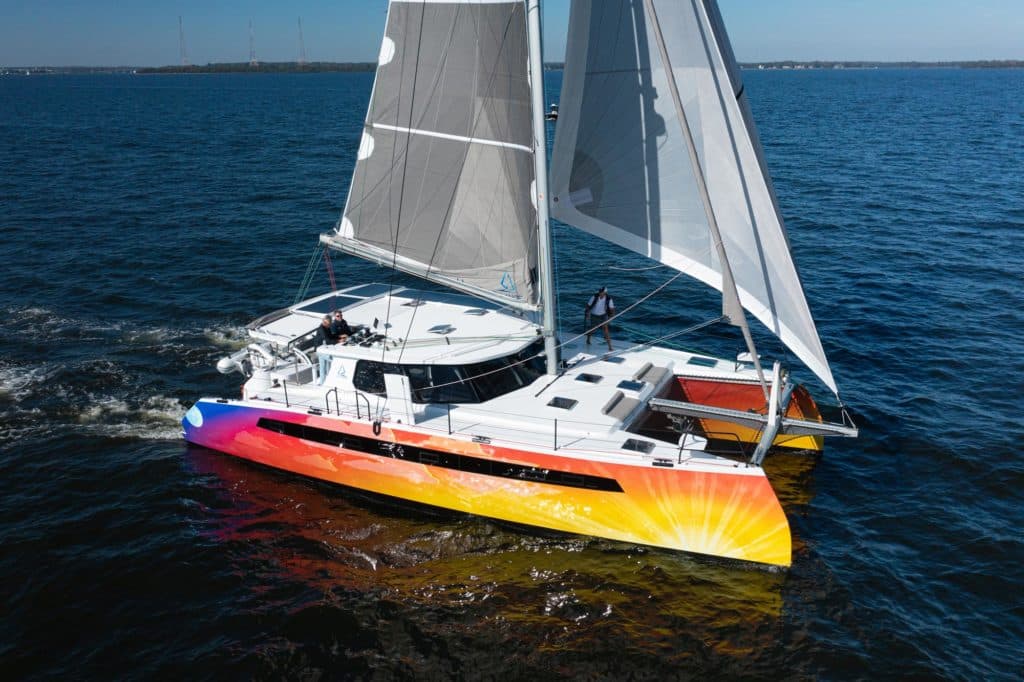
The driving force behind Balance cats is Phil Berman, a world champ at racing beach cats who brought that passion to developing and marketing fully found cruisers. Judge Murphy knows him well: “Phil comes from a very strong view of wanting to see boats that have solid sailing performance. He’s also a strong proponent of daggerboard boats, which tends to be quick shorthand for the dividing line between cats that are more about payload versus cats that are about performance, but not so much where you’re going to fly a hull or break a rudder. There’s a balance within a boat that really performs that you can still live aboard.” A winning balance, it turns out, with the Balance 482 securing its position as the Best Performance Cruiser for 2022.
- More: balance catamarans , Boat of the Year , Boat of the Year 2022 , catamaran , Kinetic Catamarans , print 2022 jan , Sailboats , seawind catamarans
- More Sailboats

New on the Docks: Leopard 46

Sailboat Review: Dufour 41

Pre-Owned: 1988 Hylas 47

Catalina Introduces the 6 Series
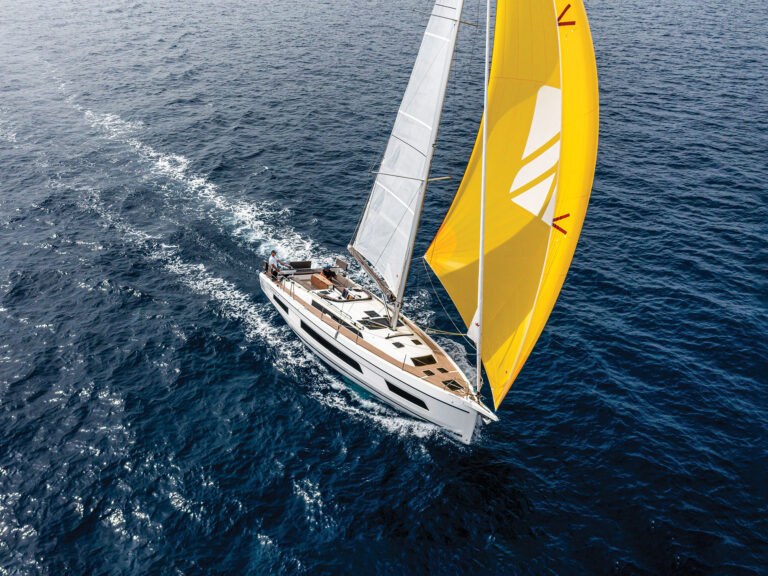
Surviving the Storm: A Sailor’s Tale of Hurricane Lee
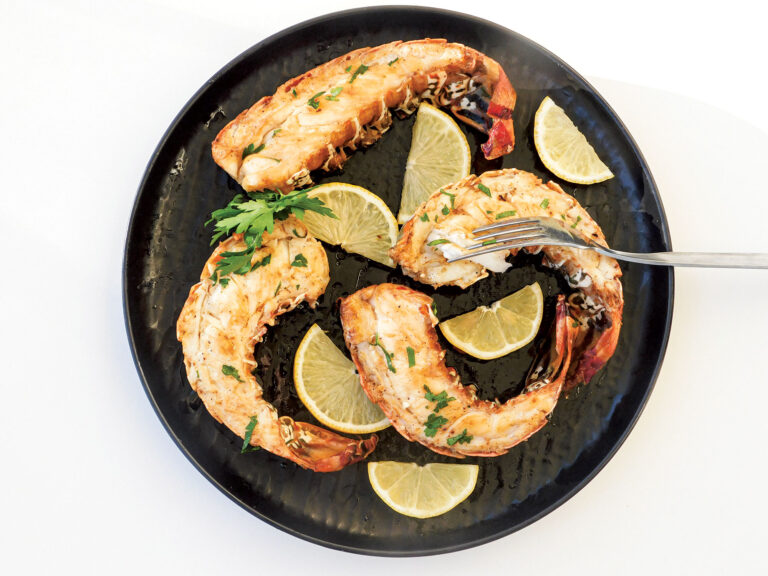
Storm-Tossed, Lobster-Blessed: A Culinary Cruising Tale
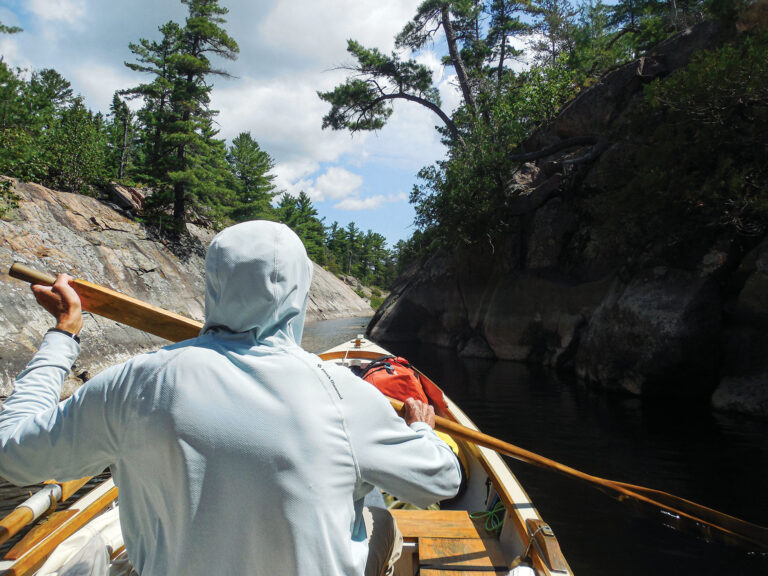
Minimalist Cruising: Georgian Bay by Dinghy
- Digital Edition
- Customer Service
- Privacy Policy
- Terms of Use
- Email Newsletters
- Cruising World
- Sailing World
- Salt Water Sportsman
- Sport Fishing
- Wakeboarding
The Top Sailboat Manufacturers (According to Sailors)
Whether you are buying or chartering a boat, or whether you simply want to stay informed, you might be asking the question: who are the top sailboat manufacturers? As is the case with most 'who's the best' questions, the answer isn't simple. So this article takes a stroll among the crowds and asks - “who's your favorite?” .
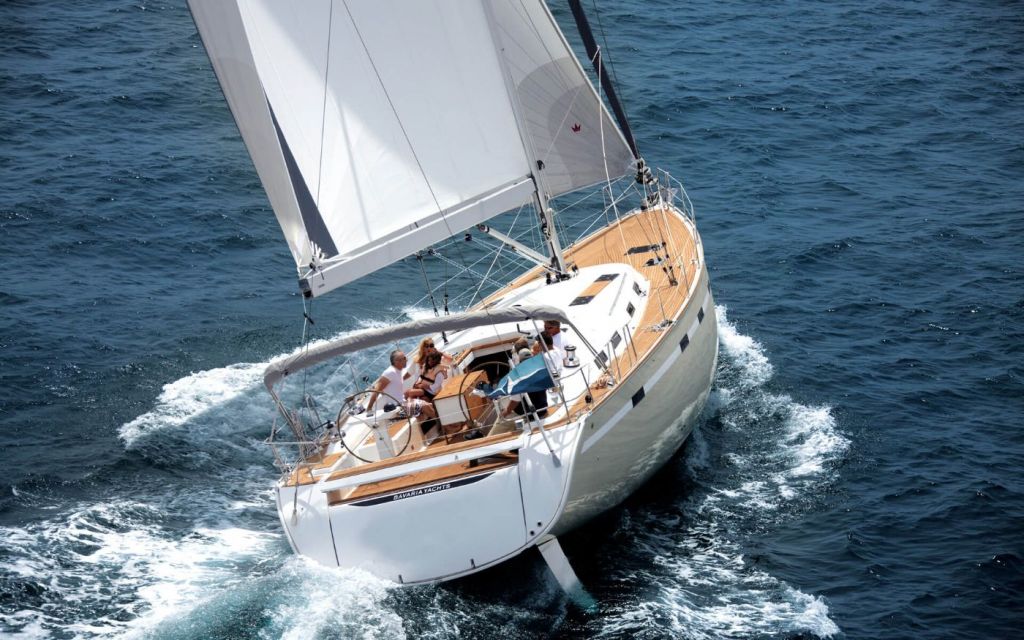
What are the top sailboat manufacturers?
Groupe beneteau.
This is the ultimate all-star list. Now let’s see why.
First of all - I want to make this lineup relatively short. There are tens of names that bounce around when you ask about favorite manufacturers, and if I had made this a long list, in the end, it wouldn’t represent the famous all-stars that really stand out in the eyes of the people. If you want a longer, less detailed list, check out our article about 50 popular sailboat brands . This time though, we are looking only at the manufacturer champions of the ‘popular choice’ contest.
“This is a loaded question!”, the internet forums yell, “there are thousands of options!”, they cry, enraged, “it’s not about the boat, but about the crew!” they scream. But we don’t give up and continue, determined to find out who you all like the most.
Cover Image : Bavaria Cruiser 55 - Copyright BavariaYachtbau under CC BY-SA 4.0
I know, I know, I hear you. Let’s start with the cons of these boats to quench the thirst of the bloodthirsty critics. Yes, Wallys are very costly, they go all the way up to tens of millions of dollars and so won’t be more than a bedroom poster for most of the readers.
That’s about it when it comes to the negatives, though. The reason they made it on this list despite their price tag is that they are pioneers in many aspects. Visually they are beyond gorgeous, and their price allows for exquisite build quality. The cost of these hi-end racer/cruisers means they aren’t particularly user friendly since most users won’t be able to use them, but just as Rolls Royce belongs on the list of the best cars, Wally belongs on the list of the best boats. They are the brainchild of Luca Bassani, founder and chief of the brand, a stylish Italian man who knows what’s right.
And it is this poster worthiness that gained them popularity among the crowds. A video of a simple Atlantic crossing on a 100 foot Wally has millions of views not necessarily because that particular journey would be exciting, in fact, it is quite an uneventful one, but because it is on a boat that makes the design junkies salivate. The Wally designs alone were the reason these boats made it into Hollywood feature films and series, and if you look at one, you’ll understand why. This is what happens when extravaganza meets good taste and has all the money in the world to realize the idea.
What do they make in terms of sailboats? Superyachts around 100 ft long, each focused on sporty cruising, design, and comfort. They only make custom sailboats, no factory models here. Buying a used one is a safe situation, they hold up even after a long time both in terms of quality, performance as well as design. During their existence, Wally only made a handful of boats, so if you ever stumble upon one, take a selfie. It is like meeting a celebrity.
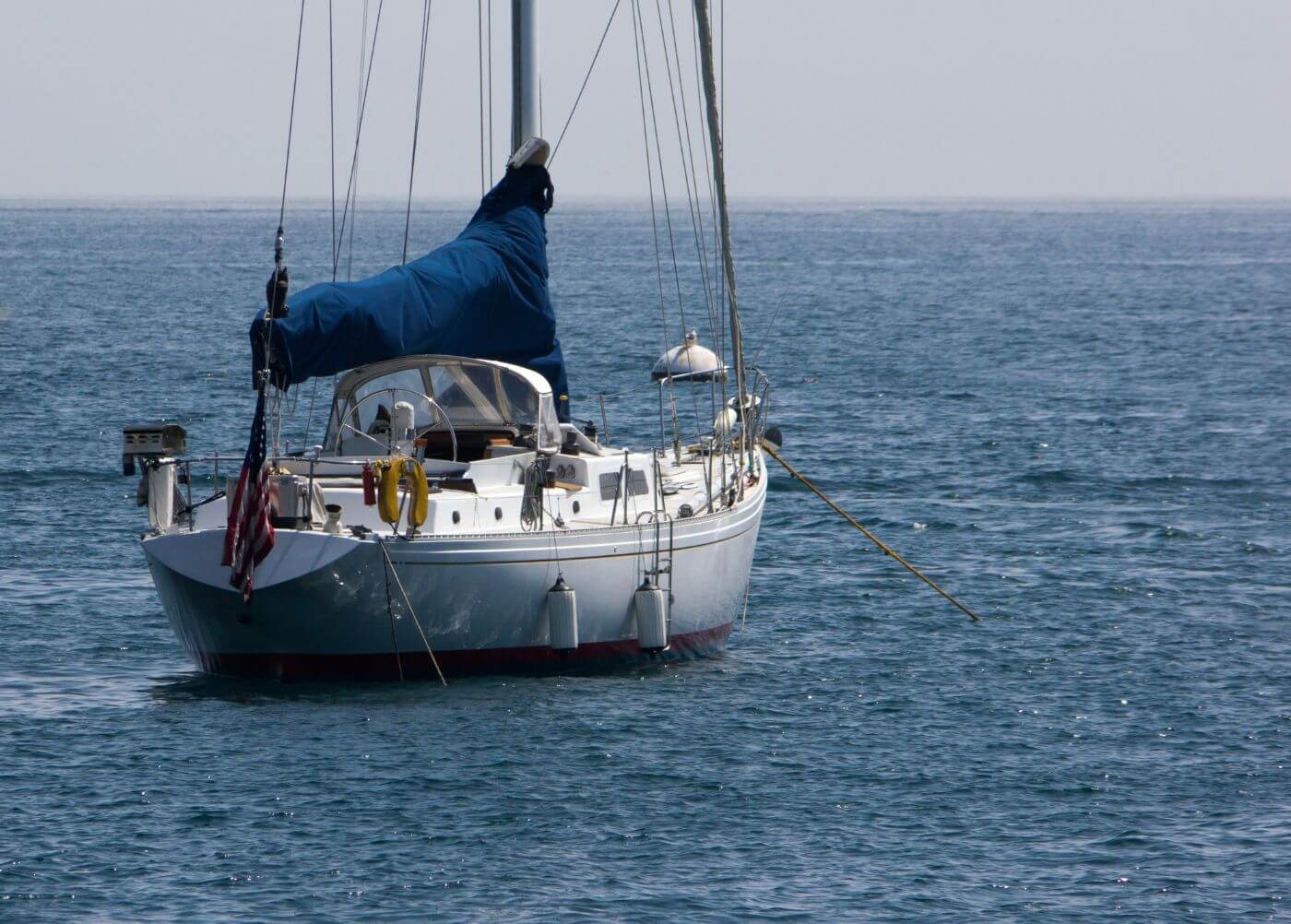
To level the scales, let’s now jump at the opposite side of the spectrum and have a look at Catalina, the people pleaser. If Wally was the Rolls Royce of the boating world, Catalina is the Ford, making, as they say, “honest, sturdy boats that hold up to real-world conditions, perform well and cost less to maintain”. The mission of this company then seems to be to make boats as practical as possible for the common folk. That means: a practical interior layout, practical handling, and last but definitely not least, a practical price.
And this strategy has worked out well - according to experiences of hundreds of thousands of sailors, Catalinas stand up to their reputation of a boat that’s got your back. It is one of the largest boat producers in the world, with over sixty thousand of its boats sailing the world. Boat manufacturers oftentimes go through quite a lot of rough patches, that turn into bankruptcy for many, it isn’t an easy business to be in, but Catalina has been on a roll for decades. And this success has come with its perks - the business stability allowed for some impressive manufacturing facilities, which helps mass production, which in turn helps drive the price down. So with Catalina, you’ll likely be getting more bang for your buck than from their competition.
They make boats ranging from tiny daysailers all the way to 50-foot seaworthy vessels. What made them the most famous though are their mid-sized cruisers - the staple of the classical American sailing fan. Whether you like it or not, slow and steady is the name of the game when it comes to mainstream, and that is precisely what Catalina understands so well. They don’t take large risks. Their models are long-running with slight tweaks and facelifts, concepts that don’t surprise or insult, but offer stability. This conservativeness has been what some sailors hold against Catalinas, which is easy to understand when looking at many other brands that offer more in terms of fanciness, but this is the Catalina way, and it has worked out splendidly for them.
The long years of experience make for a great manufacturer that makes boats which won’t be the fastest, won’t be the prettiest or the boldest in terms of design or technological innovation, but they will do precisely what they are made to do - their job.
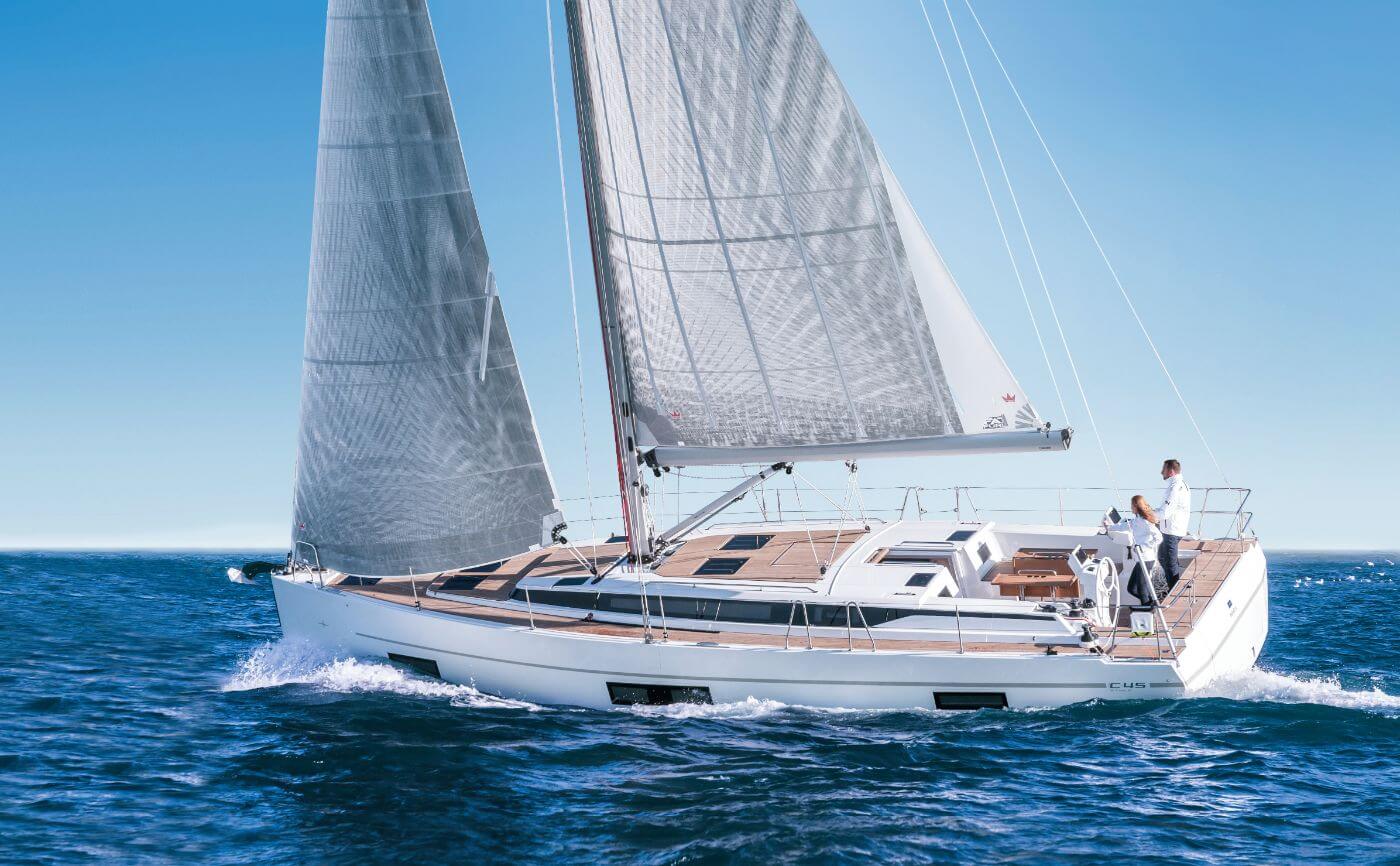
Bavaria is to Europe what Catalina is to the United States. Affordable, practical, nothing special, but does what it’s supposed to. It is the main diet of many Mediterranean sailors. To stay with the cars equivalent, just because I like it so much, if Catalinas were the Ford, Bavarias would be the Volkswagen. They are generally cheaper than Catalinas but don’t see that as an indicator, sailors can’t seem to find one or the other significantly worse or better in build quality. There are of course a few voices rooting for one or the other, but that can be assigned to fandom rather than to actual benefits. The price difference is there partly due to a different manufacturing process, the Bavaria factories are more efficient (they are German after all), and the production is more streamlined, allowing cutting costs without cutting corners.
Reliability, ease of use, and affordability are aspects that lead the design decisions here - which is what makes them so prevalent in charter companies. Even a nonexperienced sailor can get on a Bavaria and operate it with relative ease. But as I’ve been told by the boss of an unnamed charter company, after five or so years, you will start to feel the lower price tag as their reliability starts to go down unless money is put into repairs. With an older Bavaria, you will feel its age more than with other manufacturers. As one owner puts it, they tend to get “quite exhausted”.
So in case you belong among the Bavaria fans and have your eye on a used one, keep the above sentences in mind and when shopping, make sure you understand the ‘health’ of the boat in question. Moreover, be aware of the difference between a boat that was used by a handful of sailors over the years versus one that was chartered to more people than you could count. In other words, you wouldn’t want to buy a few-year-old rental car because who knows what the poor thing had to suffer, - especially since you can bet that many of the clients weren’t particularly good sailors due to generous sailing license policies in Croatia, which allows virtually anybody to ‘become a sailor’ within hours for a friendly fee.
What can you expect when you get on one? Good things - the manufacturers know what their products are used for, and that is why Bavarias are designed as easy comfortable cruisers. Everything you need to have within reach will be within reach, to the point of you having something to hold on almost all the time wherever you go through the boat - Bavaria knows well that many of its users won’t have their ‘sea legs’ and act accordingly. Even smaller models have generous amounts of space because it is the smaller models that are charter kings - Bavaria gives a lot of attention to them. The layouts will be comfy, so Bavarias make good boats for longer voyages - pair that with reliability and price and you will understand why the vox populi speaks so fondly of them.
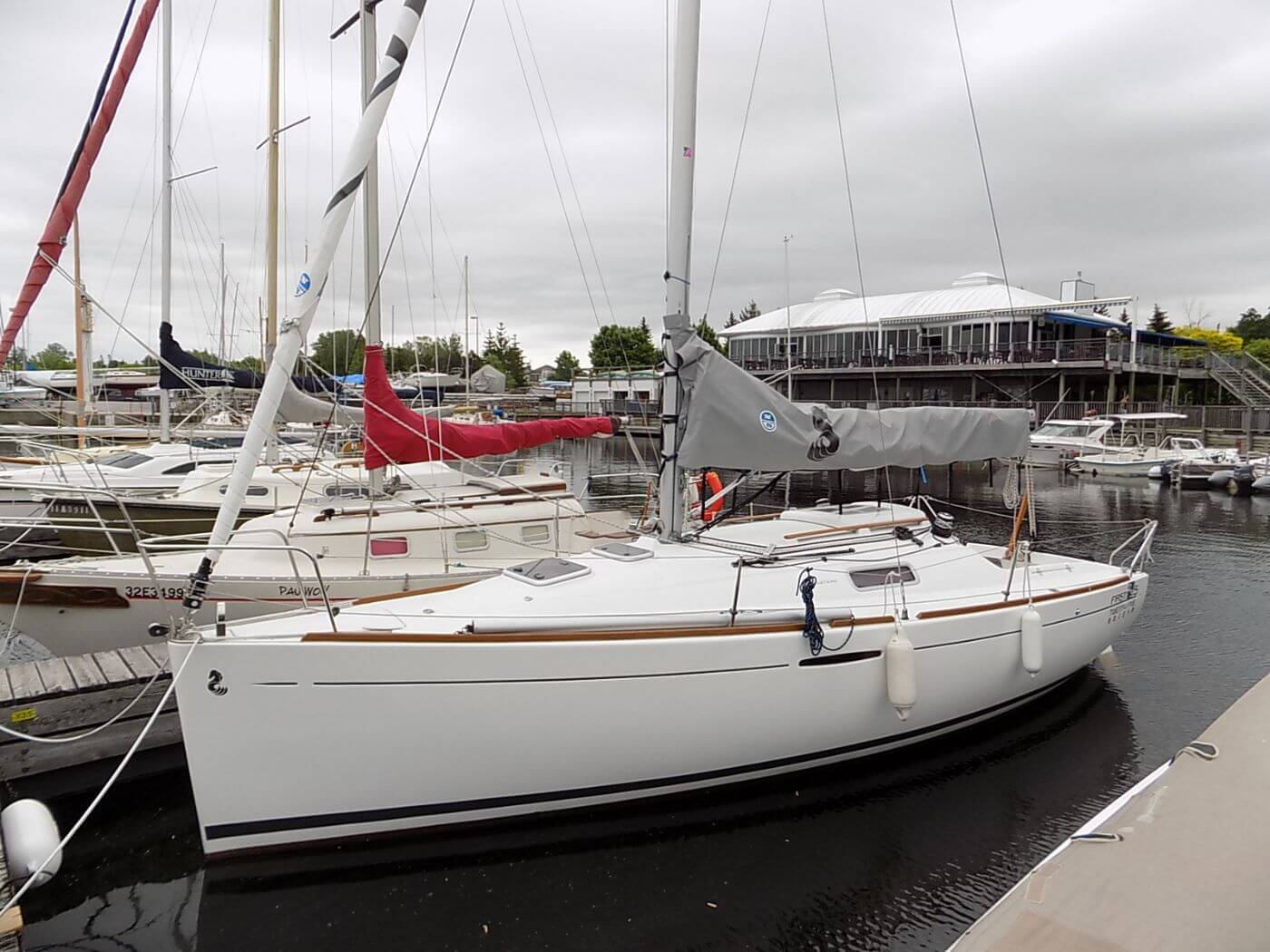
The reason I am mentioning the name of the parent company here is that they own both Beneteau and Jeanneau, brands that are distinguishable on the surface, but if you look close enough, you will find them pretty similar, down to the fact that they are produced in the same factory. So since both Beneteau and Jeanneau are very popular sailor’s choices, both deserve a place on this list, but dedicating a subchapter to each would feel like making a duplicate.
By the way, Groupe Beneteau also owns Lagoon, a renowned catamaran maker, Prestige, luxury yacht manufacturer, Monte Carlo Yachts, CNB Yacht builder, the semi-custom sailboat maker, Four Winns, Glastron, Scarab, Wellcraft, Excess, and Delphia… some of these make motor yachts only, but if you combine fans of all of these, you get a sizable crowd. This company has figured out what people of various tastes want and serves quite a few of these niches.
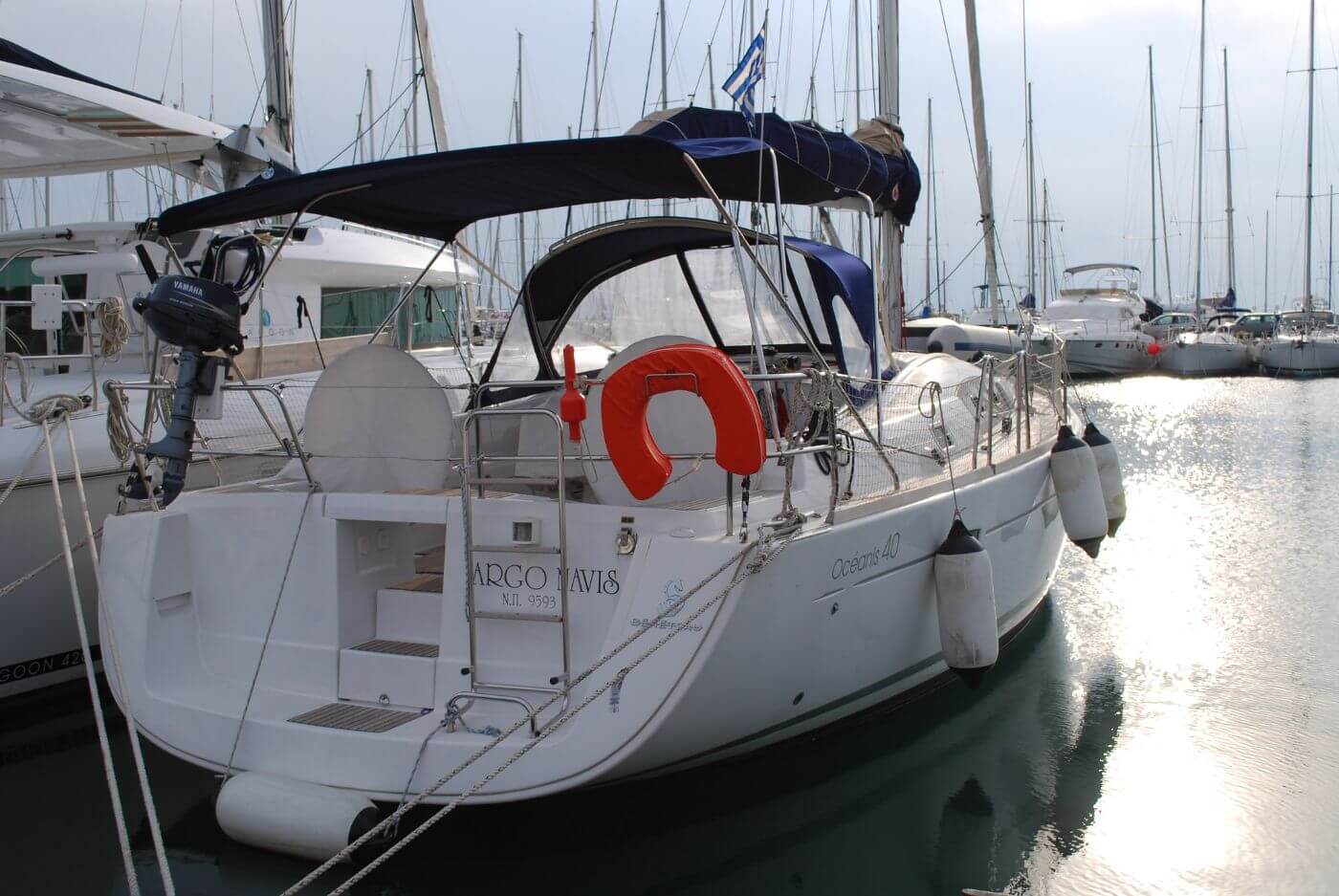
Business aside, let’s see how this French company managed to find its way into the hearts of so many. Well, first of all, they are French. So chic style is to be expected. And with this, fans come. Image wise (and design-wise to a bit) Jeanneau is the sporty one that sails better, while Beneteau aims at the family comfort market. But on both, you will feel loved by the designer. They are made to make you feel good when you use them, and they’ll spoil you with luxury that fits within the specific price tag.
Comfort is a big deal here. On Jeanneaus for instance, you will sometimes find quite unique layouts, often different from the traditional ones, to really pamper the sailors - such as their two master bedroom setup, with the stern one being under the cockpit. A lot of them come with the 360 docking system, which allows you to move the boat around with a joystick and makes maneuvering in marinas so easy you feel like you are cheating. Or consider their decision to make the hull finer to cut through the water better, resulting in less movement - something that helps with comfort. All of this comes for a price but less so than you would expect since the buying power of the enormous Groupe Beneteau helps with shaving off dollars where smaller manufacturers couldn’t. This is, for instance, the reason why they can afford to use wood on their crafts to an extent you wouldn’t expect from a production boat for that price - again, buying volume allows for this even without you necessarily having to pay the expected premium.
Of course, you will mostly find them in Europe, where they are plentiful in marinas, though the aforementioned Bavarias dominate as far as numbers go. But that is mostly because of charters, since last year, over 80 percent of chartered boats were Bavarias. As personal boats, products of Groupe Beneteau belong among the top choices.
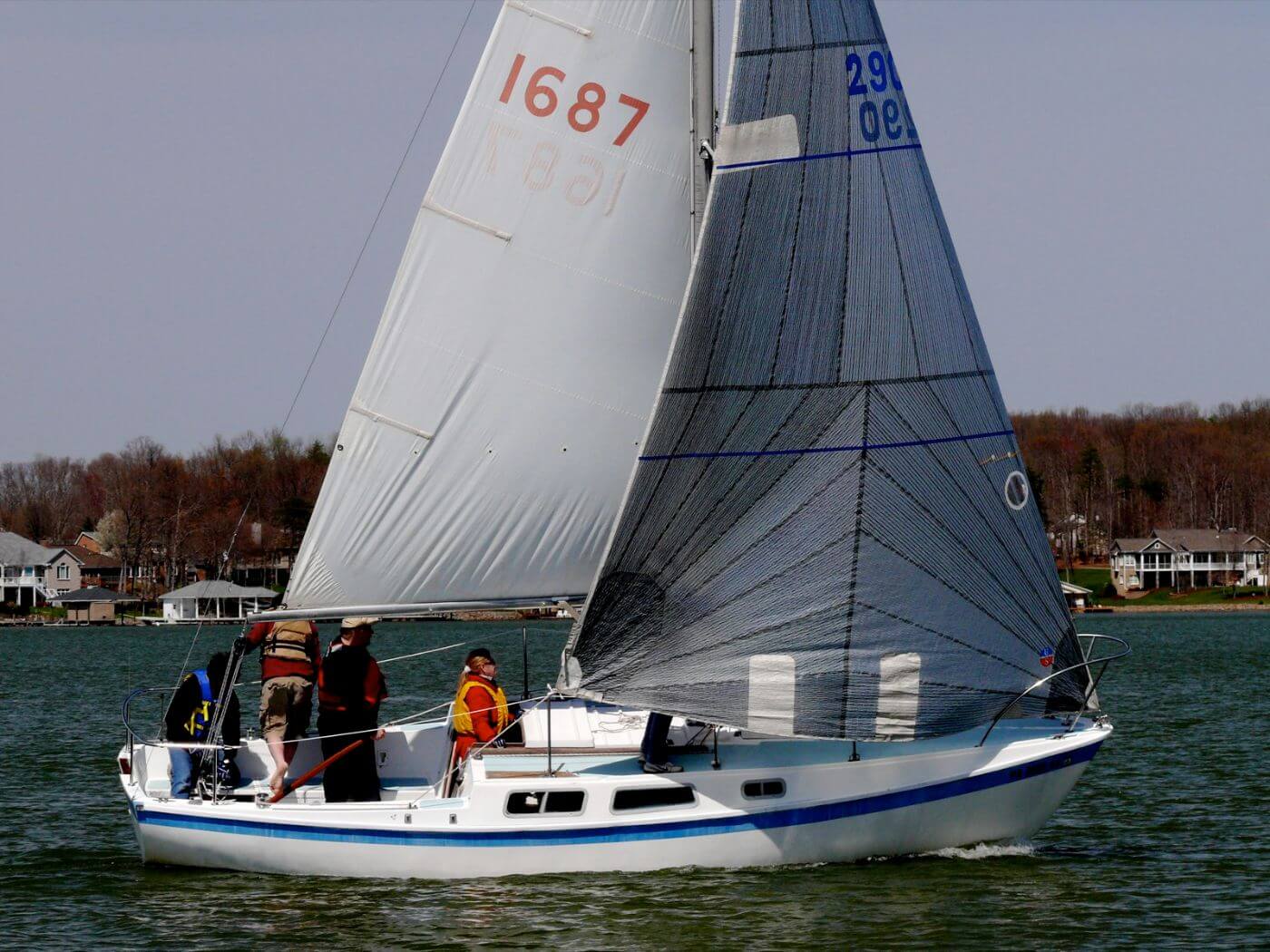
Now, this is a bit of a tricky one. The manufacturer doesn’t exist anymore, in fact, it produced boats from 1960 to 1989, making it over thirty years old, but despite that, the Cal models are still a favorite and worthy member of the cruising as well as performance world.
During the company’s existence, almost twenty thousand boats were built, partially because they were one of the first brands to mass-produce fiberglass sailboats. That, along with Cal models winning impressively in races, helped them to make a name for themselves, a name that still sounds to this day.
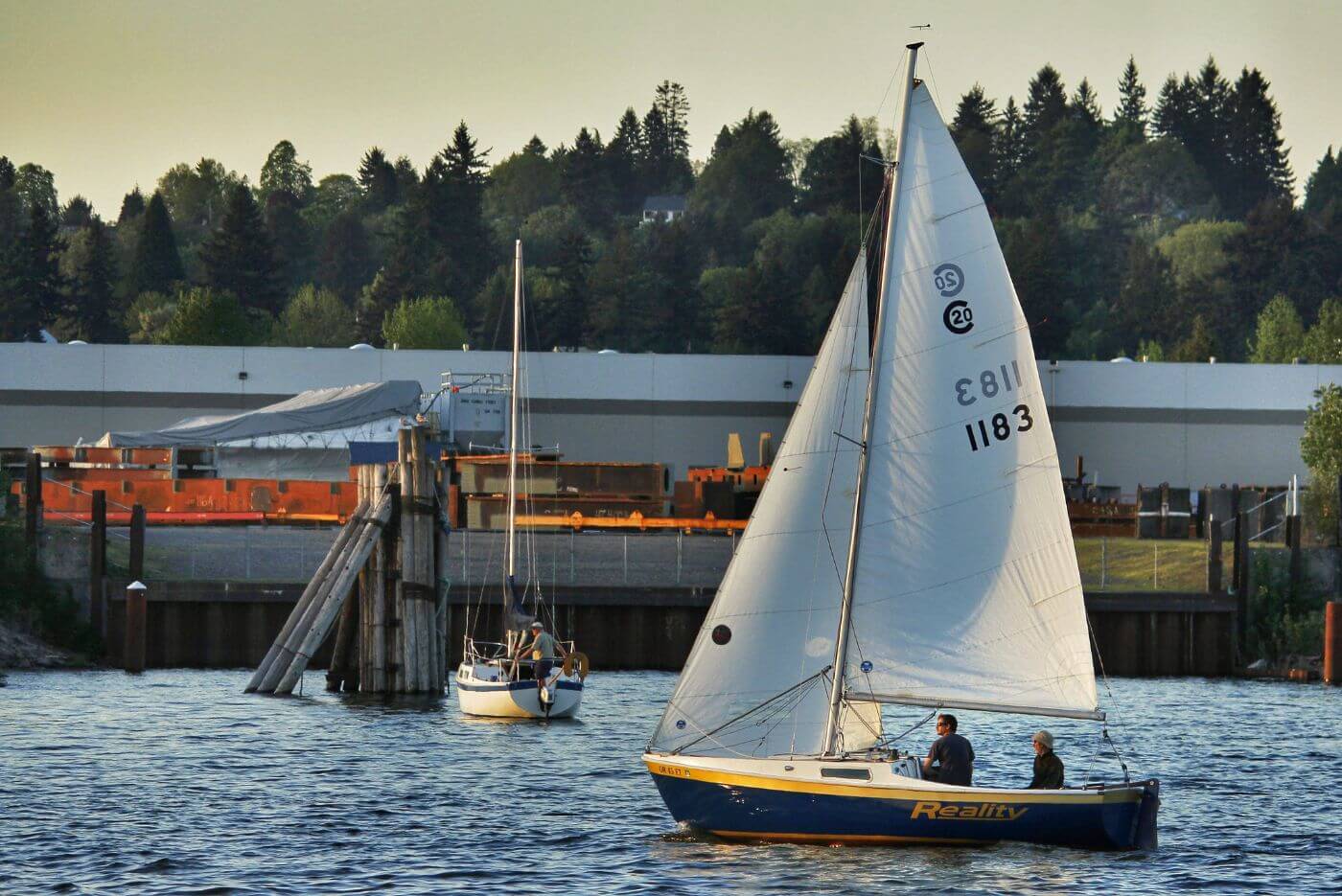
Why is it on this list? Partially because of its prevalence on the seas, partially because of its prevalence in internet forums and pub talks. Cal sailboats are loved by their owners mostly for their responsiveness when under sail, good build quality, (even though many say the interior could have been done way better) as well as reliability even after long years of use. Many of the design features have indeed been improved since, so if thirty years ago you could dominate races with Cals, today you won’t be on the lightest and most up to date boat around anymore. But you won’t be sailing a cruiser either. The boat might not be a pureblood racer, but it was built with racing in mind. Which might give the more sporty ones of your peace of mind that no Bavaria or any traditional cruiser will provide.
Quite a few owners say though that the success from the sixties gained Cal a name that you will pay for when buying one. If you are one of those who want to make sure they are paying for physical value rather than reputation, this might be a dealbreaker for you. There is a certain portion of slight arrogance that comes with racing success, one that shows in later models. But given the brand’s popularity, this is not too big of a deal.
So if cruising is your goal, if long crossings are what you desire, if you simply want a boat that was built with honesty and can take you basically anywhere you want, Cals are a safe bet. You’ll be joining a big, happy and an old family. And an affordable one at that.
In conclusion
To sum it all up, it seems that practicality, affordability, and reliability are the main factors that influence whether a sailboat manufacturer will become popular among sailors or not. As well as extravagant design and beauty, but that’s another story.
There have been many shipyards throughout the ages, some long-lasting, some surviving but a couple of years. Each tried to come up with an angle to sell well. Sometimes it was quirky design, and sometimes it was an intriguing feature, sometimes it was the use of new technology. Sometimes it worked out quite well, other times it did not. But in the end what sailors seem to want is a boat that will not fail them when they need it the most, a boat that is well built enough to cross oceans, because that gives one a sense of freedom and a boat that is built with the user-friendliness in mind. Simply, a boat that is your good friend.
A road to a sailor’s heart is simple, after all.
Daniel O'Connell
Really good article. I was enlightened.
Dan O’Connell
Leave a comment
Build Your Perfect Boat
Live the experience with leopard catamarans, a range waiting to be discovered.
- Sailing Range
Set sail to new horizons aboard a Leopard Catamaran. Sea-trialed and tested off the coast of South Africa, Leopard Catamarans are known the world over for extraordinary craftsmanship and optimal performance.
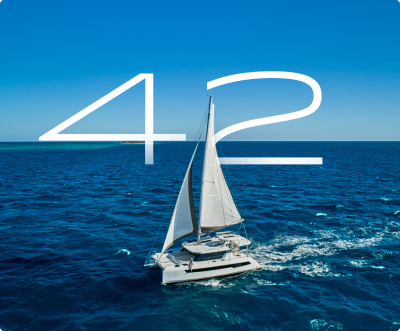
- Power Range
Set sail to new horizons from the power and beauty of Leopard Catamarans. Sea-trialed and tested off the coast of South Africa, Leopard Catamarans are known the world over for extraordinary craftsmanship and optimal performance.
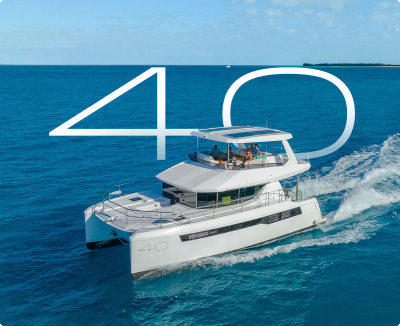
With Leopard Catamarans you can create a tailored boat.
WHY LEOPARD CATAMARANS
The robertson & caine factory.
Evolving from 50 years of customer feedback, Leopard Catamarans has pooled their expertise with builders Robertson and Caine and Naval Architects Simonis Voogd to design today’s Leopard range: spacious, robust, performance-driven blue water cruising catamarans. Our 30-year relationship with Robertson and Caine is an exclusive partnership, offering the best possible value to our customers.
Leopard catamarans are the only catamaran brand certified both in Europe and the Americas (NMMA Certified — ABYC Standards & CE Certified – CE Standards). As the worldwide distributor, we’re proud to say that over 2,900+ Leopard cats have now been delivered worldwide.
NEWS & EVENTS
Our latest stories.

Ask a Leopard Owner: Natalie + Moritz
September 6, 2024.

Sailing the BVI on a Leopard 50: A Vacation Itinerary
August 7, 2024.

The Leopard Family: How to Find Your Community
July 26, 2024.

United States Sailboat Show
August 27, 2024.

Fort Lauderdale International Boat Show
August 20, 2024.

St. Petersburg Power & Sail Show
August 19, 2024.
Our newsletter will provide you with the latest news, special offers, previews and shows
Product updates and announcements. No spam.
Evolving from 50 years of customer feedback, Leopard Catamarans has pooled their expertise with builders Robertson and Caine to design today’s Leopard range: spacious, robust, performance-driven blue water cruising catamarans.
- News & Events
- Our catamarans
- Leopard 40PC
- Leopard 46PC
- Leopard 53PC
- Download Brochure
- Terms of Privacy
- Owner Warranty Claim Form
©2024 Leopard Catamarans. All Rights Reserved
Choose Language

Best Liveaboard Catamaran Sailboats

Catamarans are an excellent choice for living on the water. Modern catamarans are more spacious than monohulls and provide all the comforts of home.
In this article, we'll cover five of the best liveaboard catamarans available on the new and used market today. We'll also cover how to choose the best and most comfortable catamaran to live aboard.
The best liveaboard catamarans are the Manta 42, the Nautitech 44, the Voyage 44, the Privilege 435, the Elba 35, and the Lagoon 380. These vessels are seaworthy, comfortable, and ideal for long-term living.
We sourced the technical specifications of these vessels from maritime records and directly from sailboat manufacturers. We also considered the opinions of sailors who live aboard these vessels and others.
Table of contents
Living on a Catamaran
Living on a catamaran has both advantages and disadvantages when compared to living on a monohull sailboat. That said, most of the challenges of living aboard a catamaran are mitigated on larger and higher-quality vessels.
Catamarans feature two hulls placed side-by-side and connected by a deck. As a result, the cabins are split between the two hulls, and you may have to go outside to get to the other cabin. Thankfully, most modern cruising catamarans have a center cockpit that connects the two hulls and often features living spaces.
Some vessels have facilities (such as the galley and table) in one cabin and sleeping areas in the other. However, some catamarans have sleeping and cooking facilities in both hulls. The configuration you choose depends on how many people attended live aboard and what layout you prefer.
Catamarans offer superior stability and motion comfort, which is a big advantage when living aboard. Overall, conditions under sail and in the harbor are likely much better aboard a properly-proportioned catamaran.
How to Choose a Liveaboard Catamaran
What qualities make a catamaran ideal for living aboard, and how do you choose the best boat? Attributes such as size and interior layout are the most important, but others such as fit and finish and seakeeping abilities should also be considered.
The best liveaboard catamarans range in size between 30 and 50 feet, width 40 feet being the comfortable average. In general, vessels smaller than 30 feet simply lack the space to include a practical interior layout.
Interior Layout
Interior layout is largely a matter of personal opinion. The most popular liveaboard catamaran features a spacious center cockpit with access to both hulls. Master bedrooms are often found in the stern and the bow of each hull, with heads in between and a galley in the center cockpit. Some catamarans feature one or more additional settees, along with storage in all areas.
Tech and Convenience
The majority of monohull sailboats were produced between the 1960s in the 1980s. This isn't the case for catamarans, as their popularity is more recent. As a result, you're likely to find considerably more modern amenities aboard. Everything from autopilot systems to bathtubs are available aboard newer catamarans.
How Much does a Liveaboard Catamaran Cost?
Catamaran prices vary widely based on age, length, and overall quality. Older vessels cost anywhere between $30,000 and $100,000. Newer and more comfortable liveaboard catamarans generally start above the $100,000 mark and extend up to $500,000 or more.
Best Catamarans to Live On
We chose the following six liveaboard catamarans based on size, interior amenities, handling, and price. These vessels are popular amongst liveaboard sailors and make exceptionally comfortable floating homes both in port and at sea.
1. Manta 42
{{boat-info="/boats/manta-42"}}
The first vessel on our list is an exceptional cruising catamaran that's also a comfortable place to live. The Manta 42 can be found on the used market, and it features great handling and a spacious cabin.
Unlike most catamarans, which are built overseas, the Manta 42 was produced entirely in the United States. The Florida-based company produced these vessels in the 1990s and 2000s, and they proved extremely popular with offshore cruisers.
The Manta 42 is known for its stability, hull strength, and speed. However, its cabin layout is also smart and livable. Most Manta 42s feature an asymmetrical cabin layout. The cabin has two heads located in convenient places; one on the port side across from a master berth and one on the starboard side, which is easily accessible from the cockpit. It features three berthing areas and one large sitting area, with seating and storage throughout.
The Manta 42 also has exceptional storage capacity. The vessel stores 125 gallons of fuel and a whopping 100 gallons of freshwater. It also has generous gray and black water tanks to service both heads and the galley sinks.
Overall, the Manta 42 is an excellent choice for cruising liveaboards. It's a fast, nimble, and safe vessel with ample headroom and space throughout the cabin.
Quick Facts:
- 42-foot overall length
- Large master cabins
- Built for long-term living and cruising
- High storage capacity for fuel and water
- High hull strength
- American-built
- Production ceased in the 2000s, so equipment may not be up-to-date
2. Nautitech 44
{{boat-info="/boats/nautitech-44"}}
The Nautitech 44 is the obvious choice for the number two spot on our list. This well-known cruising catamaran has a unique Center cockpit design which makes it stylish and functional.
The futuristic cockpit of the Nautitech 44 allows the crew to enjoy ample ventilation even in wet conditions. This makes it ideal for living abroad in tropical climates where rain and heat often accompany each other.
Nautitech, which is a French company, continues to produce this model due to its popularity and excellent seakeeping abilities. Prices almost always exceed $100,000, both new and used, making it one of the costlier models on the list. For the price, you get a fine interior fit and finish along with the latest comforts and conveniences.
The Nautitech 44 is available in several cabin layouts. The most popular configuration features an expansive center cockpit with below-deck living spaces, along with three berthing areas and a galley. Additionally, most of these vessels feature a large master head and several smaller heads in each of the hulls. Access to each hull through the center cockpit is easy, and the headroom is excellent.
The Nautitech 44 is a fast boat, and it's great for offshore cruising. However, hull width was sacrificed for speed and handling. This means that the hulls are slightly narrower than some of the competition. That said, it doesn't seem to bother most Nautitech owners.
- 44-foot overall length
- Large center cabin
- All-weather control cockpit
- Great ventilation
- Ample room in the hulls
- Wide hallways
- Spacious heads
- Excellent seakeeping abilities
- Expensive on the used market
- No open cockpit
3. Voyage 44
{{boat-info="/boats/voyage-44"}}
Here's a popular and spacious catamaran with some unique characteristics that make it ideal for living aboard. The Voyage 44 is a wide and stable multihull sailboat with a large center cockpit and an attractive interior layout.
The cabin of the Voyage 44 is modern and airy, taking advantage of light colors and thoughtfully designed furniture to make the most out of limited space. This is conducive to a pleasant living environment that's also easy to clean. The center cockpit also features a large, full galley.
The center cockpit stands out, as the voyage 44s exceptionally wide beam gives it plenty of room for tables, sitting areas, and other amenities. The windows let in plenty of light, in the cabin is completely weatherproof.
Below decks, the Voyage 44 features up to six separate heads and several sleeping areas. The master head, located in the bow, is one of the largest available on sailboats of this size range. The vessel features up to eight individuals sleeping areas, which is remarkable for a 44-foot boat.
The Voyage 44 is an excellent liveaboard catamaran due to its wide beam and extremely spacious living accommodations. Out of all the boats on this list, the Voyage 44 is likely the best value overall as it's relatively affordable. The Voyage 44 may be the perfect long-term liveaboard catamaran under 50 feet in length.
- Unusually wide beam
- Full master head with two showers
- Very high speeds
- Sturdy construction
- Very large center cabin
- Eight sleeping areas
- May be too wide for some marina slips
4. Privilege 435
{{boat-info="/boats/privilege-435"}}
The Alliaura Marine Privilege 435 is a simple and elegant catamaran with a comfortable interior, smart design, ingrate offshore handling characteristics. This speedy vessel is constructed with some of the finest materials available, and the overall fit and finish are excellent. Behind the center cabin, the Privilege 435 features a strong fiberglass canopy to protect the crew from spray and son.
The majority of Privilege 435s on the market were built recently, so you can expect the latest navigation and safety equipment. Additionally, the vessel is efficient and includes amenities such as multiple heads, modern utilities, and easy access to the hulls through the center cabin.
The vessel features four separate bedrooms and enough bathrooms and showers for each person (or couple). The center Cabin is wide and features comfortable seating areas, along with a full galley with a stove and a fridge. Stepping inside the Privilege 435 is like stepping inside of a vacation house, and it feels purpose-built for long-term living.
The vessel is available in relatively high numbers, though its popularity means you're likely to pay top dollar. On the used market, the vessel sells for between $250,000 to $350,000 on average. This puts it on the upper edge of our price range. But for the price, you got a long-lasting and desirable catamaran that's ready to live aboard almost immediately.
The Privilege 435 is ideal for cruising liveaboards with families or sailors who need space for guests. The interior is very comfortable and aesthetically pleasing. It has several great spaces for entertaining multiple people. On short-to-medium voyages, the Privilege 435 should be adequate for up to eight or more adults.
- 43-foot overall length
- Full-size berthing areas
- Large center galley and sitting area
- Spacious interior
- Large showers
- Great offshore handling
- Expensive, even on the used market
{{boat-info="/boats/fountaine-pajot-elba-45"}}
The Fountain Pajot Elba 45 is a modern and luxurious cruising catamaran with a high freeboard and all the living amenities you'd expect. It's a high-caliber vessel that sails as good as it looks, and it's still produced by the original manufacturer in Europe.
The Elba 45 has one of the largest center cabins of any catamaran in its size range. It features a large settee, a full galley, and access to both hulls. The cabin layout is flexible, and you can order one of several different designs. One of the most popular is the classic 'mirror' layout, where each hull has two master berthing areas, a V-berth in the bow, and two separate heads.
However, other versions are available with attached bathing facilities and additional room for storage, cooking, and other activities. One of the unique features of the Elba 45 is the addition of a V-berth bow. This berth connects directly to the master Beds, which makes for a unique but flexible sleeping arrangement.
If purchased new, the Elba 45 will set you back around $430,000 to $450,000. For the price, you get the latest technology and the finest interior and exterior materials. This is important in the long run as the best liveaboard catamarans should be built to last.
The fit and finish of this vessel are ideal for those looking for a luxurious living environment. Its accommodations are closer to that of a luxury yacht than a sailboat. As a result, the Elba 45 is a great place to live long-term and entertain guests.
- 45-foot overall length
- Multiple layouts available
- Luxury fit-and-finish
- Four cabins
- Six full-size berths
- Luxurious amenities
- Additional V-berths in bow
- Highest build quality
- Upper end of the price range
6. Lagoon 380
{{boat-info="/boats/lagoon-380"}}
The majority of suitable liveaboard catamarans are over 40 feet in length. This is because it's difficult to fit comfortable accommodations in a smaller vessel. However, the Lagoon 380 is a notable exception. This 39-foot catamaran is one of the most comfortable vessels in its class, and it features a spacious interior and excellent design.
The Lagoon 380 is a newer vessel that features modern conveniences and adheres to high safety standards. Modern manufacturing techniques make this vessel stronger and easier to maintain than its older counterparts. Additionally, owners praise its sailing characteristics in both rough and calm weather.
The spacious center cabin features a full galley and sitting area with a notably wide walking room in between. It also boasts excellent visibility, which also increases the amount of natural light in the living areas. Additionally, the center cabin features easy access to the hulls, and the mirror layout provides comfortable accommodations for eight adults.
The interior space aboard the Lagoon 380 is almost indistinguishable from catamarans between 44 and 50 feet in length. The primary difference is that, instead of the traditional two heads per hull, the Lagoon 380 only features one. That said, the heads include a large shower and plenty of room to move around.
The Lagoon 380 is the perfect solution for sailors looking for big boat accommodations in a small package. Due to its shorter length, the Lagoon 380 avoids additional fees for docking and servicing vessels over 40 feet overall.
- 39-foot overall length
- Full galley
- Under 40 feet in length
- High construction quality
- Customizable options
- Great handling
- Fewer bathrooms than some similar vessels
Related Articles

Daniel Wade
I've personally had thousands of questions about sailing and sailboats over the years. As I learn and experience sailing, and the community, I share the answers that work and make sense to me, here on Life of Sailing.
by this author
Best Sailboats
Most Recent

What Does "Sailing By The Lee" Mean?
October 3, 2023

The Best Sailing Schools And Programs: Reviews & Ratings
September 26, 2023
Important Legal Info
Lifeofsailing.com is a participant in the Amazon Services LLC Associates Program, an affiliate advertising program designed to provide a means for sites to earn advertising fees by advertising and linking to Amazon. This site also participates in other affiliate programs and is compensated for referring traffic and business to these companies.
Similar Posts

Affordable Sailboats You Can Build at Home
September 13, 2023

Best Small Sailboats With Standing Headroom
December 28, 2023

Best Bluewater Sailboats Under $50K
Popular posts.

Can a Novice Sail Around the World?
Elizabeth O'Malley
June 15, 2022

4 Best Electric Outboard Motors

How Long Did It Take The Vikings To Sail To England?

10 Best Sailboat Brands (And Why)
December 20, 2023

7 Best Places To Liveaboard A Sailboat

9 Best Trailerable Sailboats
Get the best sailing content.
Top Rated Posts
© 2024 Life of Sailing Email: [email protected] Address: 11816 Inwood Rd #3024 Dallas, TX 75244 Disclaimer Privacy Policy

6 Best Performance Cruising Catamarans (Buyer’s Guide)
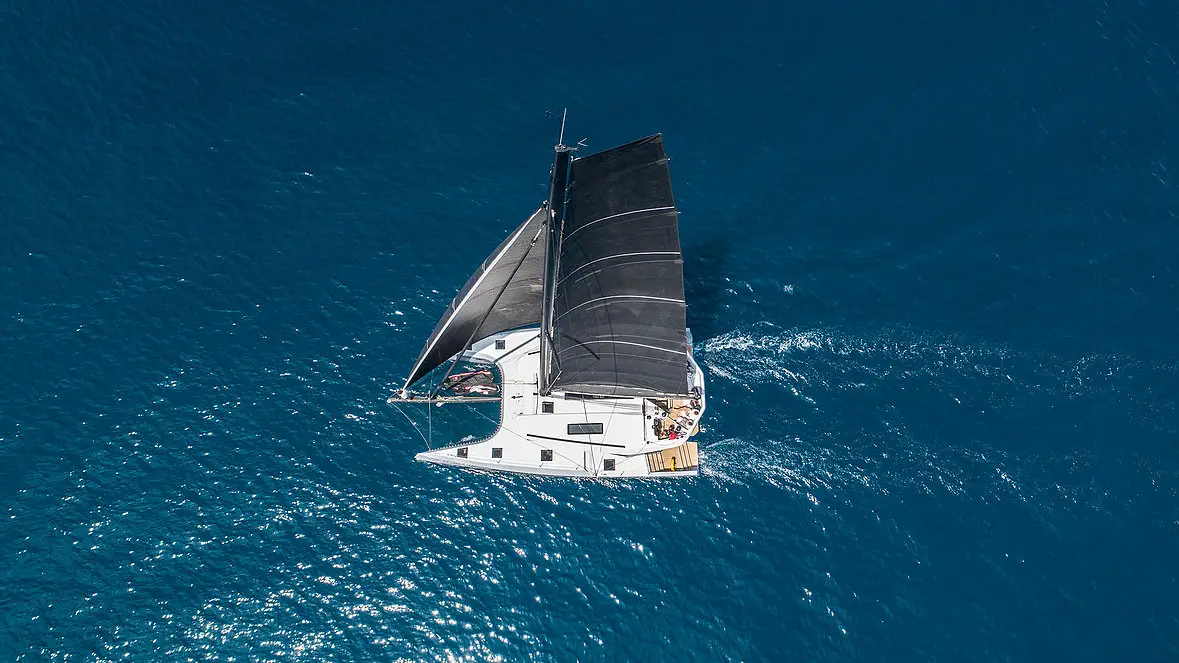
As an Amazon Associate, we earn from qualifying purchases. We may also earn commissions if you purchase products from other retailers after clicking on a link from our site.
Performance cruising catamarans are impressive-looking vessels that focus on speed above comfort. These fast boats are ideal for racing and long cruising vacations. But with the numerous brands and models on the market, how do you know which is the best one?
The best high-speed performance cruising catamarans are the Outremer 4x, McConaghy MC50, Nautitech 44, Gunboat 62, Balance 526, and Marsaudon Composites ORC50. All these boats deliver outstanding speeds and are light in weight, relatively comfortable, and incredibly safe.
This article will explore the brands and models that I believe have the best combination of performance and comfort . We’ll look at their speeds and what makes them cruise so fast. We’ll also examine the factors to consider when shopping for a performance cruising cat.
Table of Contents
How Fast Are Performance Cruising Catamarans?
Cruising catamarans are generally faster than monohulls of similar lengths. This means most well-built and well-balanced cats will arrive at their destination much sooner, and the cruise is much more comfortable. Performance cruising cats like the Nautitech include deep daggerboards and rudders, narrow waterline beams, hull chines, and big sail plans that allow for faster sailing than a standard cruising cat.
| CATAMARAN | SPEED (Knots) |
|---|---|
| Outremer 4X | 20 |
| McConaghy 52 | 22 |
| Nautitech 44 | 17 |
| ORC 50 | 23 |
| Balance 526 | 20 |
| Gunboat 62 | 20 |
| Privilege Signature 510 (For reference) | 13 |
| Fountaine Pajot Astréa 42 (For reference) | 10 |
Outremer 4X
Outremer Catamarans are well-known for their high speeds. These exciting cats sport brilliant designs, narrow bows, and large rigs. Built in Southern France, the vessels are strong and long-lasting since their structures feature materials such as carbon, glass, and vinyl ester.
The Outremer 4x is a stable and comfortable high-speeding cruising catamaran that performs ocean crossings and confronts any weather with remarkable ease. Named the European Boat of the Year in 2017, this 48-foot (14.6 m) bluewater cruiser sails faster than wind speed and attains maximum cruising speeds of 20 knots.
The 4x is an upgrade of the extremely popular Outremer 45, thus retaining Outremer’s core values of speed, safety, and comfort. It’s built for maximum performance and enjoyment, with the lightweight, carbon fiber structure allowing for additional speed under sail .
Featuring comfort typical of much larger vessels, the Outremer 4X features 4 double cabins, hot water showers, a full kitchen, spacious storage, and excellent ventilation. There’s also an expansive deck, an unobstructed cockpit, and large trampoline areas. Most importantly, your safety is assured through the cat’s unique features including a robust structure, offshore design, stability, and unrivaled speed potential.
The 4x’s cutting-edge design makes it ideal for competitive racing or blue water cruising, and it does both without compromising your comfort, safety, or onboard livability. However, to sail at maximum speed, the boat must remain lightweight, requiring your interior to be fitted out quite minimally. The other downside is the high price tag; the Outremer 4X commands a price between $912,322 and $1,202,945 .
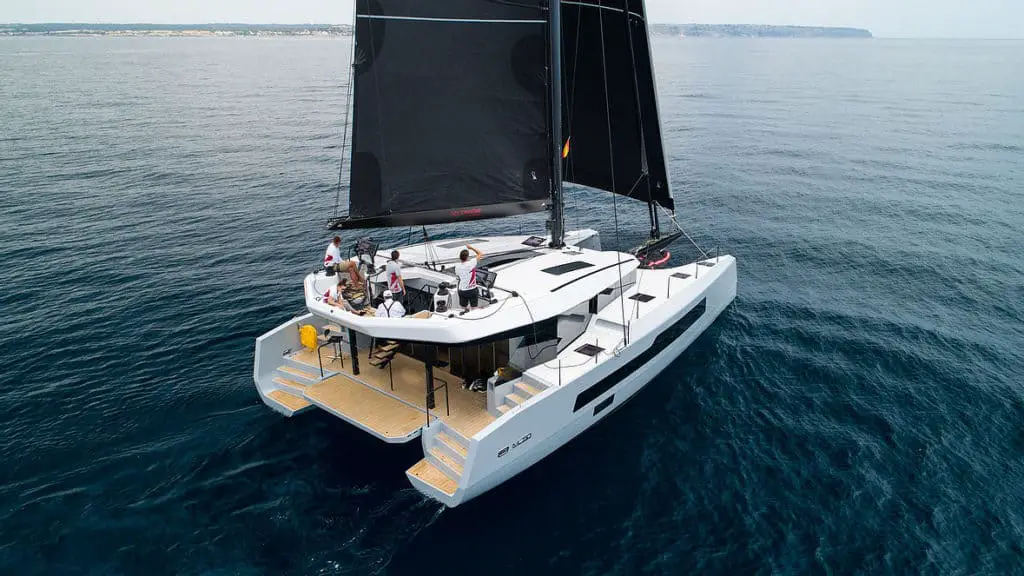
McConaghy MC52
The McConaghy MC52 is a performance luxury cruising cat reflective of McConaghy’s 50 years of experience in building high-tech composite projects. The luxurious boat features a flybridge, retracting centerboards, optimized hulls, and an open space bridgedeck combining the salon with the cockpit. You can also customize the boat to your specifications.
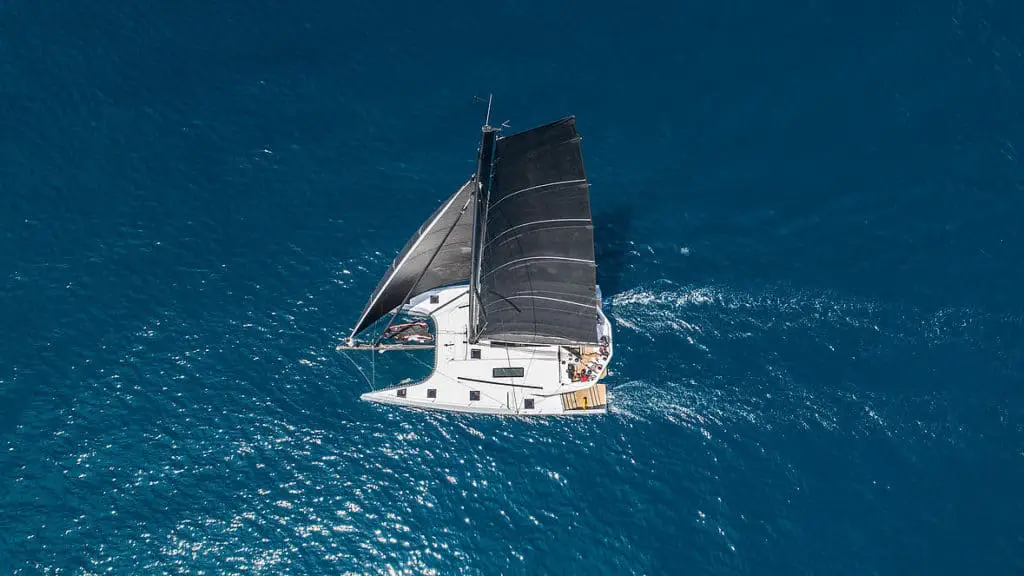
This hi-tech cat comes with sizeable sliding salon windows and frameless doors that provide fantastic views. Its wave-piercing bows can cut through waves, thus helping to increase performance by minimizing pitch resistance, while still retaining a smooth ride. Also, the saloon offers spacious dining space for up to 8 people, and the galley area is more like a penthouse.
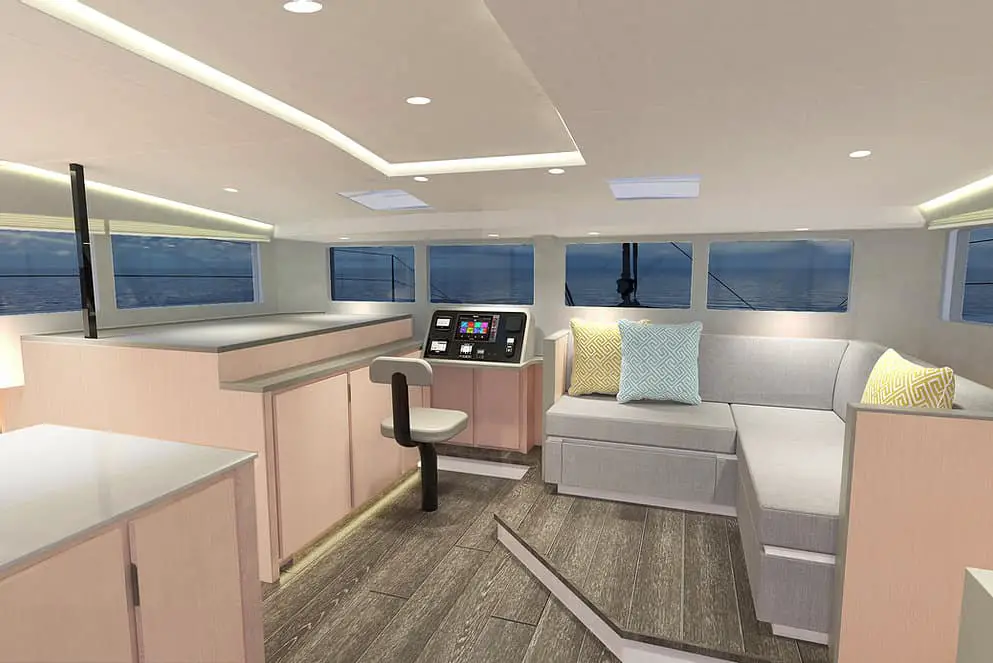
The manufacturer’s background in building high-end racing yachts has resulted in an incredibly strong and lightweight vessel capable of reaching 22 knots (40.7 km/h or 25.29 mph). The main downside to this boat is the boom placement on the mast, which is much higher than other high-performance cats. This makes accessing the mainsail somewhat challenging. It also increases the MC50’s center of gravity and center of effort.
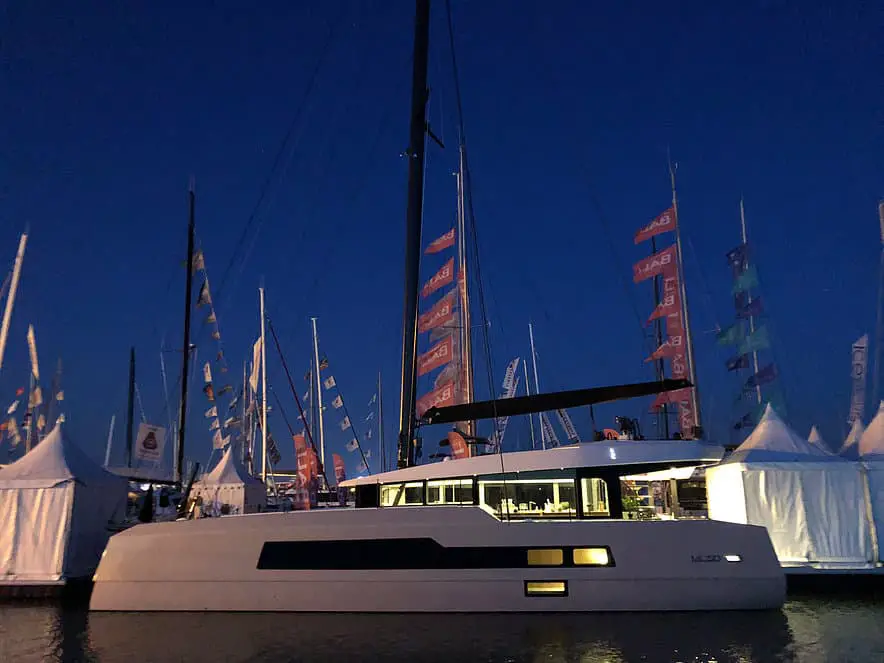
You can get the MC52 for about $1.6 million.
Nautitech 44
The Nautitech 44 easily blends comfort and fun to deliver an impressive sailing performance, whether you take short trips or long ocean crossings. The boat offers a good balance under sail, and it features helming stations on each hull. Plus, there’s an integrated hardtop bimini complete with sunroof opening. Slim hulls translate to higher speeds, with the vessel reaching up to 17 knots (31.4 km/h or 19.51 mph).
The well-laid-out interior boasts a functional design, ample storage space, plus all the equipment you require for ocean cruising, such as a fridge, watermaker, and solar.
Nautitech 44’s twin helms give you the real sailing experience with a fantastic view of the sails and great visibility when maneuvering into port. However, you might not appreciate being stuck in the aft helm position without protection in lousy weather or during hot days.
Nevertheless, the boat’s responsiveness makes sailing more pleasurable. Plus, it’s affordable; the price is between $236,000 and $334,000.
Marsaudon Composites ORC50
Marsaudon Composites vessels are ideal for both racing and cruising. The sporty-looking ORC 50 comes with large inverted bows, an angular coachroof, a high freeboard, and a sturdy rotating carbon mast. In addition, the vessel is light which allows it to accelerate quickly, while the angular coachroof offers lots of space and excellent visibility.
The ORC50 can attain 23+ knots (42.5+ km/h or 26.41+ mph) and is among the fastest high-performance livable multihulls. It’s capable of doing more than 350 miles (563.27 km) per day.
The downside to the ORC50 is it’s a bit technical to sail, thus requiring a skilled sailor. Furthermore, its immense power and speed can be intimidating to less experienced sailors. Solely designed for speed, the ORC50’s interior is simple, less roomy, and somewhat spartan; hence the boat might not be all that comfy. Still, it’ll get you where you want to go pretty fast, and it’s an excellent value for money at approximately $787,751.25.
Gunboat 62
The Gunboat 62 is a true high-speed catamaran capable of sailing at 20 knots (37 km/h or 23 mph) over true wind speeds and known to notch up speeds of 36+ knots (66.7+ km/h or 41.45 mph) on a surf. The initial 3 Gunboat 62 boats featured epoxy, E-glass, and carbon fiber construction, but the fourth vessel was all carbon, sported a taller rig and a more expansive sail area.
These structural features made the Gunboat 62s extremely light, and they formed the original luxury high-performance cruising cats.
This multihull sailboat boasts a carbon mast, round hull sections for a minimized wetted surface area, high-aspect rudders, and retractable daggerboards. The steering station offers 360-degree visibility and sports overhead hatches that you can use to monitor the mainsail trim. The boat also contains 3 private cabins with queen berths, 2 spacious heads with showers, an aft cockpit, galley, and lounge.
On the downside, Gunboats are pricey cats; hence they’re also expensive to maintain. The Gunboat 62 isn’t that spacious either as it’s more focused on speed, but it’s extremely comfortable, plus there’s plenty of space for hanging out. You can buy this catamaran starting from $2 million .
Balance 526
Built with a combination of carbon fiber, E-glass, epoxy, closed-cell foam, and composite bulkheads, this boat is strong, light, and can withstand terrible weather. The retractable daggerboards allow for good upwind performance. All high load areas contain carbon fiber, while furniture and cabinets feature cored sandwich construction, producing the lightest yet most robust catamaran.
A Balance 526 will reach speeds of up to 20knots without stressing the rig too much.
The boat is available in various layouts and comfortably accommodates 6 people. The spacious aft cockpit and saloon provide panoramic visibility. And since Balance 526 can handle the extra weight, you get performance plus all the creature comforts you desire.
Still, Balance 526’s pricing is on the higher end, beginning at $1,440,000 . Also, the slender hulls result in less space down below. Nevertheless, the boat lives up to its name, achieving the perfect balance between superb performance and comfort.
What Makes Performance Cruising Catamarans So Fast?
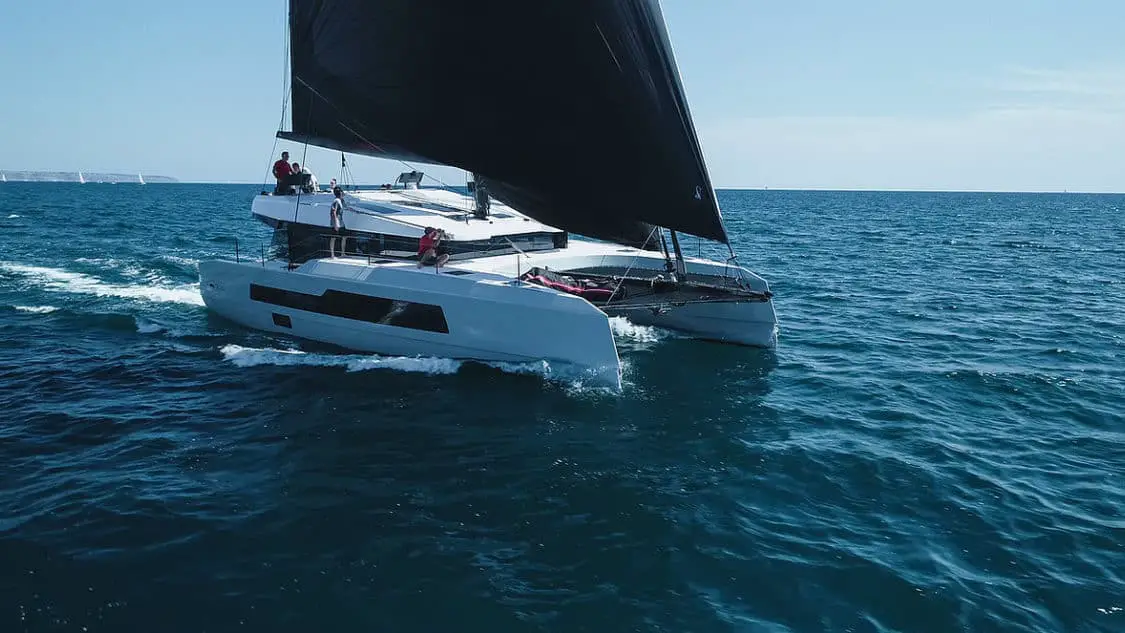
Performance Cruising Catamarans Have Narrow Hulls
Performance catamarans contain two small narrow hulls, which cause them to have less water resistance. Smaller hulls mean the vessels have much smaller bow waves to fight, allowing them to move extremely fast. In addition, the less hull area is underwater, the faster the boat is capable of moving since there’s less drag.
Having said that, it’s important to note that a narrow hull is more prone to burying its bows in rough seas. The wider the hull, the more buoyancy it offers, but only up to a given point. After which, the excessive width becomes unmanageable and performance suffers. The key lies in finding the right balance.
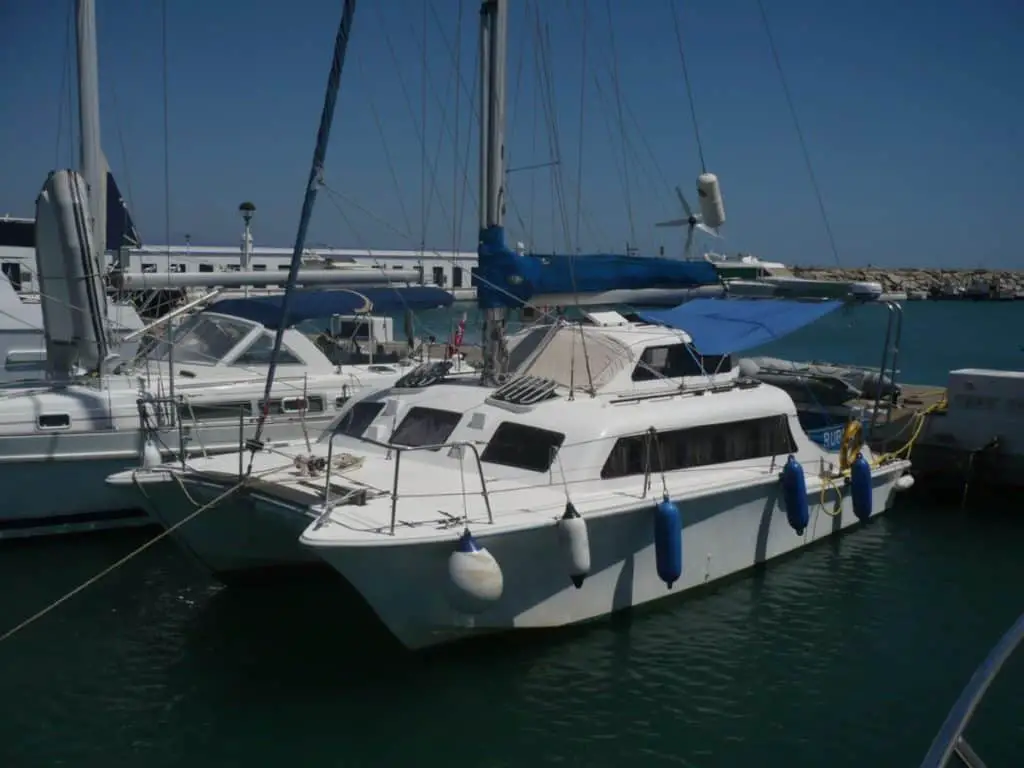
Performance Cruising Catamarans Have Considerable Length
The longer a cruising cat is, the faster it’ll move. While each vessel bears a maximum hull speed, in most cases, the lengthier the boat, the higher the speed it can reach. The length of the hull (length on the waterline) also has a significant impact on the speed performance. Thus, the cat attains maximum speeds when the wavelength is equal to the length on the waterline (hull speed).
Therefore, the longer the length of the hull, the better the performance of a high-speed cruising cat. You can also compare two cruising cats’ speeds based on this measure.
Performance Cruising Catamarans Have Quality Builds
Modern cat manufacturers continue designing more innovative high-performance cruising cats that deliver a new blend of performance and cruising features. They achieve this by using advanced construction materials, better daggerboard designs, and creative weight allocation. They also keep a keener focus on onboard amenities. For instance, asymmetrical daggerboards placed midships in each hull can help achieve proper balance and hull trim.
The overall goal is to design cruising cats that offer high speeds, outstanding performance, and enough offshore comfort.
Here’s an article if you are wondering what daggerboards and centerboards are and why they impact performance so much.
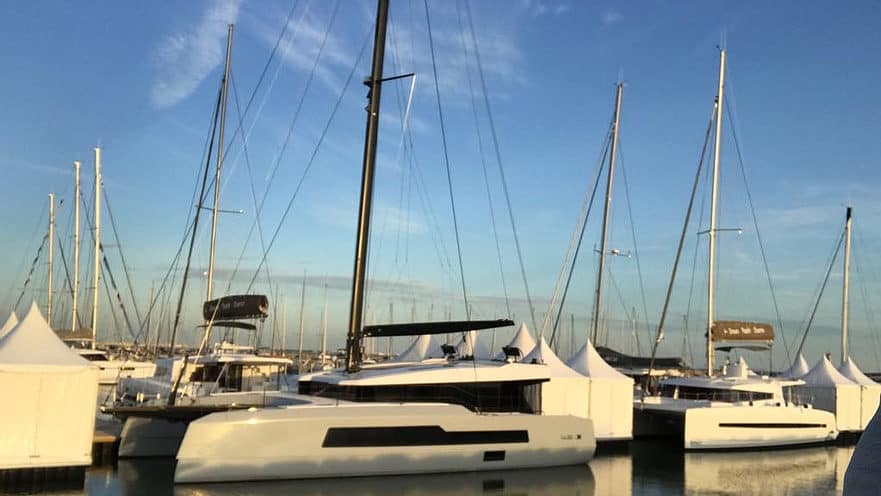
Performance Cruising Catamarans Are Light-weight
The lighter a cruising catamaran, the greater its performance. And some of the most popular high-performance catamarans find an optimal balance between performance and comfort. As a result, modern performance-based cruising cats have embraced the use of carbon composite construction for hulls, daggerboards, and rigging, instead of the somewhat heavier glass fiber materials.
A weighed-down cat produces less speed, which means excess immersion of the hulls renders the boat sluggish . The hull submersion also reduces the bridge deck clearance, promoting uncomfortable hull slamming.
You won’t find much difference in top speed between performance catamarans bearing similar lengths because they all have displacement hulls and mostly sail to hull speed with occasional surfing. This means that under skilled hands, these cats should exhibit roughly the same performance. A cruising cat’s performance is also highly dependent on the state of the sea, wind direction, and speed, amongst many other factors.
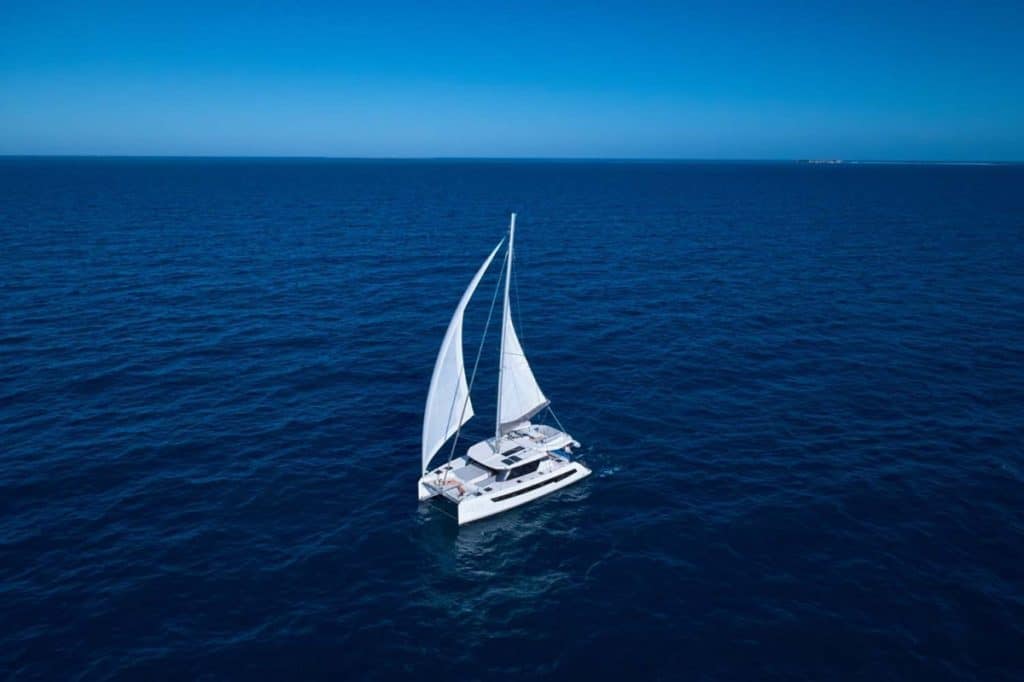
What To Consider When Choosing a Performance Cruising Catamaran
Speed is the number one consideration when choosing a high-speed cruising cat. Yet there are other factors just as important since they contribute to the overall cruising performance, including:
- What you’ll use the vessel for and where. Are you planning on doing coastal cruising or serious offshore cruising? Consider the number of people that you’ll be sailing with and the activities you’ll engage in. This also helps determine the size catamaran you’ll need.
- Comfort. While some racing enthusiasts might prefer spartan accommodation plans, most enjoy relative comfort on the high seas. In any case, modern high-speed cruising cats are designed to provide a certain level of creature comforts. And since most performance cats are custom-made, new boat owners may decide precisely which features to include in their cats.
- Quality. To produce light boats, builders employ the use of fine resins, carbon, epoxies, foam cores, and fiberglass. They build using a combination of vacuum-bagged techniques, foam cores, foam composite bulkheads, and make furniture and cabinetry with cored sandwich construction .
- Livability. One cannot underrate the appeal of sailing in a vessel with no heeling, not to mention the high privacy attained from separate living and sleeping areas. Panoramic views and exceptional deck space for lounging and entertaining are also essential in ensuring maximum cruising comfort. Fortunately, most high-speed cruising cats offer all these features and more.
- Equipment. Sailing upwind is a challenge for cruising cats since they tend to make lots of leeway. To make things easier, high-speed cruising cats come equipped with bigger rigs and either daggerboards or centerboards. However, this also means skilled sailors are required to operate them.
- Cost. Catamarans are generally expensive, but a cat built with longer, leaner hulls and less costly materials can still give an outstanding performance. Such materials include foam cores, epoxy bulkheads, and epoxy resins. Furthermore, it’s not necessary to use only carbon to build a lightweight boat.
Final Thoughts
Performance cruising catamarans are built using exotic, high-tech, lightweight materials to deliver an electrifying sailing experience. And as we’ve seen from the above list, these boats deliver performance plus much more. They’re not only speed cruisers, but they also provide a smooth, comfortable, and enjoyable cruising experience.
So, whichever option you go for – from the luxurious Gunboat 62 to the much more affordable Nautitech 44 – you’re sure to get a boat that suits your needs.
- Wikipedia: Spinnaker
- Wikipedia: High-Performance Sailing
- Yachting World: Fountaine Pajot Elba 45 Review
- Aeroyacht: Catamaran Speed
- Cruiser’s Forum: Nautitech 44…
- Nautitech Catamarans: Nautitech
- Katamarans: Marsaudon Composites ORC50 (TS5) Review
- Outremer USA: New Outremer 4x Performance Catamaran
- Dutoit Yacht Design: Balance 526 Review
- Go Downsize: How Fast Do Catamarans Go?
- Catamaran Guru: The Cruising Catamaran Performance Debate
- The Boat App: The Fastest Cruising Catamarans of 2020
- Sail Magazine: Performance Cruising Cats Set New Standards in Sailing Speed
- Cruisers Forum: Fast Cruising Catamarans – How Fast?
- Lagoon – Inside: The Secrets of a Catamaran’s Performance
- Sail Magazine: 10 Great Cruising Cats
- Cruising World: 40 Best Sailing Catamarans and Trimarans, Cruising Catamarans…
Owner of CatamaranFreedom.com. A minimalist that has lived in a caravan in Sweden, 35ft Monohull in the Bahamas, and right now in his self-built Van. He just started the next adventure, to circumnavigate the world on a Catamaran!
Leave a Reply Cancel reply
Your email address will not be published. Required fields are marked *
Save my name and email in this browser for the next time I comment.
Recent Posts
Must-Have Boat Gear for Catamaran Sailors!
Sailing is probably the most gear-intensive activity I've ever done; there are so many decisions to be made about what gear to buy now, for tomorrow, and what to definitely never buy. The gear on...
6 Best Trailerable Trimarans For Bluewater and Coastal Sailing
Having a boat costs a lot of money, even when you are not using it, marina fees, etc. And once it is in the water most sailors never go very far from their "home marina" and sailing will be somewhat...
Yachting World
- Digital Edition

Catamaran cruising: everything you really need to know
- Nikki Henderson
- September 21, 2022
Expert skipper Nikki Henderson reveals what you really need to know before going bluewater catamaran cruising

It has become routine now for me to bookend the summer sailing season with a trip to the south of France for the biannual ‘Outremer Week’. This hugely popular event gathers 100-plus new Outremer catamaran owners for five days of training, both in the classroom and on the water, and three days of friendly racing. The goal is to educate future owners so they are as prepared as they possibly can be for their upcoming bluewater catamaran cruising plans.
It’s an intensive week of 12-hour days, with a lot of information to absorb. Unsurprisingly there are some discussions specific to bluewater catamaran cruising that come up repeatedly, and they apply to owners or prospective owners of all brands of bluewater multihull. Here are some of the most common questions people ask me:
What sails should I buy for a cruising catamaran?
Every day after sailing a new catamaran owner will come up to me and say, “Nikki, I’d love to take up some of your time and rack your brains about sail selection .”
To pitch my advice appropriately, I always ask some key questions about your catamaran cruising plans, and I’d encourage you to ask yourself the same.
What is your route plan?
Tradewind sailing will be predominantly downwind. So, focus your attention on downwind sails. A route involving more upwind requires more focus on headsails. Routes involving more upwind tend to be more coastal routes, or schedules with strict timings that will reduce the option to wait for downwind weather windows.
All bluewater sail plans will need storm options. Three reef points in the main is a must, or at the very least an extremely generous second reef. A storm headsail is another key component. Ideally it should be possible to hoist the storm jib up over the top of your furled foresail. In very big conditions, reliance on the thin furling line gets quite nerve-racking.

Catamaran cruising sail options range from symmetric spinnakers to Code sails for reaching performance. Photo: Nicolas Claris
How performance-orientated are you?
Performance catamarans are designed to sail angles downwind, ideally with an asymmetric spinnaker wardrobe. However, there is a cost to the incredible speeds that you can attain reaching on these boats: comfort. So, a key question is what is your attitude to speed versus comfort?
Performance-focused sailors are typically racing sailors, sailors without kids, or sailors who are in good physical shape. If you fit this category, then I’d advise purchasing one heavy weather flat-cut asymmetric sail that can withstand a squall up to 40 knots, and a rounder, lightweight sail that you can sail quite deeply in light to moderate conditions.
If you don’t have a taste or attention span for speed, then one heavy weather symmetric spinnaker (approximately up to 40 knots TWS) should be enough. This will allow you to sail a rhumbline course, and make night-time take-downs less of a worry because the kite will survive a squall.
For upwind, if you will enjoy fine tuning your boat to get that extra half a knot, your ideal option is a large genoa for drive in light to moderate conditions, and a small flat blade-shaped jib for heavier conditions – small enough that it does not need to be furled to an inch of its life to cope with a Force 6. If an inner forestay is an option, the latter could be a staysail which will keep the centre of effort low and reduce sideways drift.
For anyone less performance orientated in their catamaran cruising, the key for upwind sailing is a strong, flat jib that is not too big. Mark three reef points on the foot with sail tape. Keep an eye on how much it stretches and don’t be surprised if you need to change it every few years to avoid losing 5-10° of height.
Downwind the tradewind route logic applies: performance sailors should invest in asymmetric and non-performance sailors in symmetric spinnakers.

Left: taking videos and photos to remember key points of spinnaker handling technique. Photo: Robin Christol/Outremer
Who’s the crew?
At this point, the conversation often goes full circle. Sailors get enthusiastic about performance, and then remember that the kids will need home schooling, or that this is a retirement plan with potential health and fitness considerations.
Most sail changes will require more than one person, and conditions at the bow can be bouncy. Crew also have to be able to sleep, cook, and live on the boat while it is thrown about. If you are short-handed, you could compromise for downwind sailing by choosing furling sails.
A furling asymmetric such as a Code D can replace the ‘hoist and drop’ asymmetric. Or you can make the sock line on a symmetric long enough to route back to an electric winch.
Upwind sailors could compromise by returning to a single jib and consider altering routing to sail slightly off the wind but faster; optimising for VMG. If you have a staysail, ensure it could be furled and therefore left rigged at sea – though make time to speak to the yacht designer about the impact on stability that having two heavy furled sails up continuously could have on the boat.
How ‘eco’ and time-conscious will you be?
Do you care about motoring? Increasingly for many of us, awareness of climate change is a strong motivator to avoid using the engine. And will you be more focused on the destination or more interested in the journey?
If you are keen to avoid motoring, and you are free of time constraints such as fixed crew changeovers or grumpy children who need to stop and swim, then I’d recommend you invest in a Code 0. A Code 0 can double or even triple the boat speed: in 6 knots of wind, an Outremer will sail at 2-3 knots with a jib, but 5-6 knots with a Code 0. It’s a great sail and worth the investment, but first work out if you will use it. They often have low wind limits – around 15 AWS – which upwind could be 10 knots TWS.
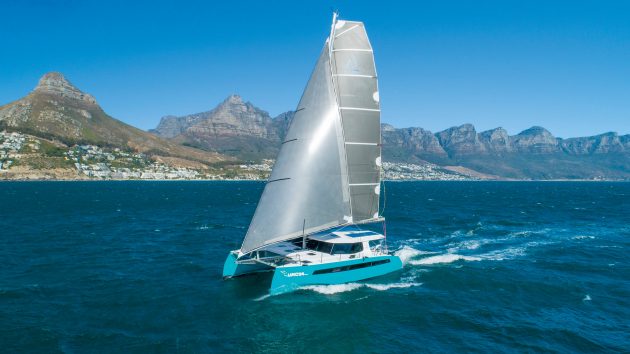
Code sails for reaching performance. Photo: Balance Catamarans
When do you reef a catamaran?
Many bluewater cruisers will reef down before dark every night. I’m not a huge fan of this as a rule; reefing should be straightforward enough to not be an intimidating manoeuvre in the dark.
But all new catamaran owners who are planning to go bluewater cruising are concerned about knowing when to reef, especially if they come from monohull sailing, as a catamaran communicates whether it is overpowered or not in a much more subtle way.
You want to conserve your equipment while sailing the boat effectively. So aim for the least amount of sail necessary to achieve your target speeds and angles. The best way to get to know this is to put reefs earlier or later each time and take note of whether it was beneficial or not. Over time you will know your boat very well.
Sailing favours guidelines over hard rules, but it’s good to have a starting point so here are some general ranges. For more cautious sailors or bigger sea states, use the more conservative side of the wind range:
- Reef 1 in at 15-20 knots TWS
- Reef 2 in at 20-25 knots TWS
- Reef 3 in at 25-30 knots TWS
Note that I am using true wind and not apparent. When sailing downwind it’s tempting to fly more sail because the apparent wind is so low. However, if you need to turn upwind – perhaps to reef – the 12 knots AWS in 20 knots TWS will quickly become closer to 25 knots AWS.
Reliance on numbers is great until the wind instruments stop working (it will happen at some point). Remember your RYA Competent Crew course and use the descriptions of the sea surface at various Beaufort Scale forces to identify how windy it is.

How to share roles is a frequent question among couples planning a catamaran cruising adventure. Photo: Robin Christol/Outremer
There are other telltale signs that the boat gives if she needs a reef. Although hulls don’t fly unless you are at the performance level of a Gunboat or similar, you may feel the windward hull just slightly lifting. This is a sign that a reef might be needed. Another is if the bows are diving down when you are sailing downwind. Heel angle can be most obviously sensed while lying down.
The main hindrance to learning when to reef – and when not – is a hesitation to perform the manoeuvre. If taking a reef feels arduous, people avoid it. I admit I can find myself in this camp: I have to remind myself that it’s a win/win, either it’s the right decision and the boat sails better, or it’s wrong and I’ve learnt from it.
The key to reefing is to practice. Taking a reef should be possible to do in under two minutes, especially if you have fast electric winches.
It’s handy to have the option to reef downwind, especially if you’re tradewind sailing. Fully battened mainsails struggle to come down so set up downhaul lines from each reef tack point. Run them through the reefing point on the sail and through the reefing points on each side of the mast so the sail is pulled down in line with the track. Watch out for chafe on the back of the main if reefing a lot downwind, and add spreader patches to your sail where applicable. Centring the traveller during the manoeuvre can help, but keep your eyes looking up and check nothing is getting caught.
Also practice solo reefing ; aside from the possibility of needing to reef alone, this also builds a big picture understanding of the whole manoeuvre. It means reefs are put in faster because anyone can work anywhere.

Catamaran designs at the ARC start cover a full spectrum of performance. Photo: James Mitchell/WCC
How can couples close the ‘experience gap’?
The argument for both halves of a cruising partnership being competent on board has always been that if something happens to the skipper, their partner will know how to safely get to a port of refuge.
However, most people assume that this will simply never happen to them, or they practise parking a couple of times, pick a fender out the water – then never think about it again. The difficulty with starting a bluewater sailing project with a large experience gap is that it tends to widen over time. Each day as leader will be a learning opportunity for the skipper.
They will grow in competence and confidence. Meanwhile, the first mate’s skills will suffer. They will get used to following instructions, their confidence will decrease, and a habit of helplessness will develop. Then, when an emergency does occur, they’ll be in a worse position to take charge than when they started.
It’s critical that couples approach buying a bluewater catamaran for cruising as a team exercise from day one – for both safety and enjoyment. Ideas on how to level up your partnership include:
- Rotate roles each day, or follow a rota. Who drives the boat into dock? Who makes the navigation calls (do this passage by passage)? Who does the safety checks? Who runs the watermaker?
- Divide the boat – maintain one hull each and share the saloon. This forces you to both understand how everything works from bilge pumps and engines to steering gear and gear storage.
- Take a coach with you for the first few crossings. It can be hard to learn to sail from your spouse. A professional coach will force you into a learning environment. They will also create space for the less experienced to be able to take charge in a safe way.
- Sail the boat without your partner. Creating a scenario where your leadership role feels natural is the optimum way to practice skippering. So, invite a few friends who don’t know as much about sailing as you, and go for a low pressure cruise. It’s a brilliant confidence builder, and a chance to develop your own style and your own voice on board.

Do you have the skills for a faster cat? Photo: Rick Tomlinson
Production or performance cruising catamaran?
A common view is that you pay more for less when you buy a performance catamaran: fewer creature comforts, less living space, fewer berths, bathrooms, and instead get narrow hulls and sparse design. So, is the big price tag worth the upgrade in performance?
If you are lured by the comfort of a production catamaran, but plan to sail intensively around the world for the next five years, it might not actually be the most comfortable option. No dishwasher or air conditioning is going to make a boat feel safer in a storm. Conversely, why buy a performance catamaran if you plan to leave the boat at the dock for 10 months a year?
Ask yourself if you have the skills to harness the performance of a faster catamaran? And if not, how prepared are you to invest time into learning how to use the boat to her full potential?
A common justification for buying a performance catamaran is that it can outrun bad weather and therefore is safer. But you cannot take advantage of that option if you sail everywhere with three reefs in the main because you are nervous of the boat’s power.
Similarly, the power of performance catamarans comes in part from how light they are. If you load the boat with extras – personal gear, kitchen appliances, heating, aircon – you will quickly reduce a lot of the speed and safety advantages you’re paying for.
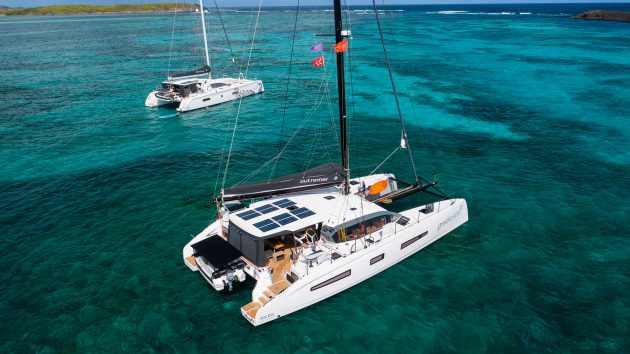
The dream – catamaran cruising in paradise! Photo: Robin Christol/Outremer
How to handle heavy weather in a cat?
A popular heavy weather strategy is avoidance: account for global weather patterns when planning your passages to ensure you sail during the more favourable months; invest in a good satellite connection to download accurate forecasts so you can see bad weather coming; use your boat speed to position yourself out of the predicted storm track; be flexible with departure windows and leave at an optimum time.
However, do not misinterpret avoidance of heavy weather as a safety net. With weather systems becoming increasingly extreme and unpredictable (see page 38), this risk management strategy is becoming less and less dependable.
- Develop scenario plans for the type of boat you have so that you don’t have to start with a blank sheet of paper as a storm approaches.
- In all scenarios, on all boats, avoid 90° wind and waves. Your boat is at its least stable in these conditions. Sail with the weather forward or aft of the beam.
- Keep an eye on heel angle. Reduce sail if you start to see any more than 5° or so, unless you have a catamaran that is designed to lift a hull. Lower the centre of effort by reducing sail, starting with the main.
- Set up and practice how to reef downwind in case the weather comes in more quickly than you were expecting.
- If you can’t sail as fast as the waves, consider trailing warps to slow you down and help with steerage. You should aim to keep the speed relatively high. The key is to reduce the erratic surfing which drops the bows into green-water troughs. I prefer warps to drogues where possible because we are more familiar with them. Unless you practice using a drogue regularly, you will likely need to read the instructions when you get it out, which isn’t ideal in an emergency.
- If waves are breaking over your stern, consider turning into the seaway and holding steady. In a performance cat, you can drop the windward daggerboard, lift the leeward board, and pinch into the wind. In a production cat with no daggerboards, this will be difficult. Running the leeward engine might help you keep your bows into the wind. Watch that there is no back flow of water into the exhaust.
- Avoid lee shores at all costs, sea room downwind is key.

Outremer Week crews receiving coaching on sail handling. Photo: Robin Christol/Outremer
When should we go?
How long should you wait after buying a boat before heading out on your first bluewater passage? Whether you spend £100,000 or £1,000,000 on your boat, it’s likely to need some fine tuning. I’ve never heard of a new boat that was perfect.
Some yards will cover the initial issues as part of the warranty, so staying close to the yard is a good idea within that period. Even if you don’t have a warranty, proximity to the yard can help you access parts, boat builders and people who understand how your boat has been constructed.
The flip side is that you want to get going, and experience all the freedoms of your new yacht! Some serious bluewater sailing is also needed to test some of the systems.
Give yourself two to six months before you head out on the first crossing. This is enough to test the boat out, but not so long that ‘passage-anxiety’ builds up and you never actually leave.
Do not treat the first few months as a holiday. This is commissioning, and it is the last stage of the build. Test the boat as rigorously as you can before you leave the proximity of the yard. Complete a couple of substantial offshore passages of 48 hours or more to test the systems. Run everything, including the watermaker. Fly all the sails you own. Sail in fruity conditions relative to your ability (Force 6-8 as a guideline) to see how the boat (and you) cope.
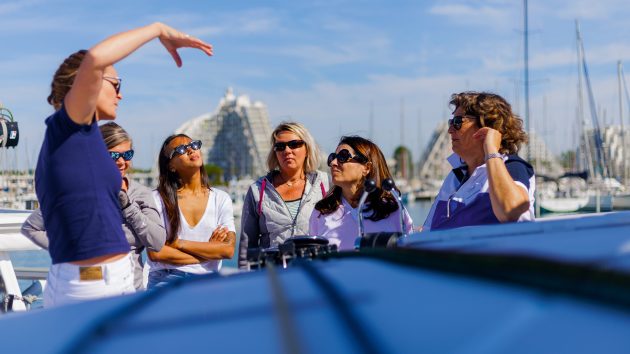
Women’s only coaching groups for catamaran cruising sailors help bridge the ‘experience gap’. Photo: Robin Christol/Outremer
Get some experienced people on board to bolster the crew for the early days. The ideal is to hire a professional coach, as this will make pushing the boat much safer and more fun for you.
Do some training ; the MCA AEC four-day engine course is a really useful opportunity to explore the parts of the engine you are normally too nervous to. A safety at sea course is worth its weight in gold. Use this to put together a safety kit that you feel confident in and that is appropriate for your cruising plans. A basic maintenance course can also be helpful, ideally one that covers beginners’ sail repair, rigging, splicing, and electrics.
Ask other sailors for a good tools and spares inventory list. On top of the standard parts that the equipment manuals recommend, current and previous owners of your boat model will have a plethora of advice.
Confident to cast off
Preparation for any type of bluewater sailing can feel daunting. Training courses and cruisers’ seminars like Outremer Week are a little paradoxical – learning how to insert an IV line in a morning medical session, then toasting your upcoming lifelong dream in the evening. It’s a bit like watching the flight safety demonstration before taking off on a once in a lifetime holiday.
The reality is that bluewater sailing is the most incredible opportunity in the world to be both savoured, and treated with an appropriate level of respect. But the most rewarding thing is to see sailors’s enthusiasm grow as they learn. With the opportunity to make mistakes and ask questions in a supportive environment, everyone develops their own skippering style and mantras.
Knowledge nurtures confidence, and confidence breeds positivity – which all contribute to a safe, and successful bluewater catamaran cruising experience. If in doubt, ask!
If you enjoyed this….
Yachting World is the world’s leading magazine for bluewater cruisers and offshore sailors. Every month we have inspirational adventures and practical features to help you realise your sailing dreams. Build your knowledge with a subscription delivered to your door. See our latest offers and save at least 30% off the cover price.
SEAWIND 1600
The 1600 passagemaker reflects our aspiration to create the ideal cruiser in every aspect: this is the ultimate offshore cruising catamaran., pointing ability & shallow draft, the ultimate offshore cruising catamaran.
Captive daggerboards, which don’t protrude through the deck, reduce maintenance and keep a clean deck that could otherwise prove hazardous offshore. Keeping these large foils captive also prevents windage aloft which can cause a catamaran at anchor to swing and swerve about her mooring. This approach conveniently maintains the aesthetic of the stunning Reichel Pugh design. The daggerboard lifting mechanism is run to a dedicated control in the cockpit, so there’s no need to rush forward and then cross the boat to raise the boards.
PERFORMANCE WITHOUT COMPROMISE
Comfort and performance are a trade-off discussed endlessly. The Seawind 1600 Passagemaker strikes this balance through the use of advanced build technologies and continuous weight-saving efforts. Strategically placed carbon fiber reinforcements throughout the structure, Kevlar reinforcement under the waterline and revolutionary daggerboard integration not only make the Seawind 1600 Passagemaker an extremely stiff and fast catamaran, but also gives her the beach ability that so many Seawind catamarans are renown for.
SHALLOW DRAFT
Through the use of Kevlar reinforced hulls with retracting daggerboards and rudders, the Seawind 1600 Passagemaker is safe on a sandy shoal. The minimum draft (with daggerboards and rudders up) is only 54cm – or 2ft 1 inches. That means the Seawind 1600 Passagemaker can enter protected anchorages and waterways inaccessible to almost any other cruiser on the market today.
Designed for extended ocean crossings, the Seawind 1600 Passagemaker has all of the cruising practicality you would expect from a new Seawind catamaran, but delivered on long and fast performance hulls.
High aspect deep retracting rudders and daggerboards offer performance and practicality - this catamaran sailboat tacks easily and is a nimble performer, but has a minimum draft of only 54cm with the foils raised.
At 52 foot, this Reichel Pugh designed performance cruiser offers sailors a true sailing experience whilst not sacrificing on safety or comfort. The Seawind 1600 Passagemaker has proven to be a world class catamaran capable of being sailed anywhere, by anyone.
The Seawind 1600 Passagemaker carries an exclusive interior full of the elegant finish work expected of a true thoroughbred sailing yacht.
A delightful light-oak interior oozes Italian style. The chic grey of the oak interior contrasts well with the modern walnut floor timbers. Soft LED lighting and quality sound system enhance the carefully planned atmosphere aboard.
Reichel Pugh design expertise, along with Seawinds 35 years of practical catamaran handling experience combine to create a yacht ideal for long extended cruising or live-aboard sailing.
Designed by world renowned naval architects Reichel Pugh, this 52-foot luxury catamaran is the perfect balance of cruising comfort and performance sailing.
With simple sailing systems, twin protected helms and a large open cockpit space, this blue water luxury cruising catamaran sets the standard for offshore sailing.
At 52 ft, our Seawind 1600 Passagemaker is the flagship of our range with a brief to be the “ultimate luxury offshore cruiser”. And after thousands of design hours, and thousands more in the early construction and testing phases, that work has been rewarded in a competition we hold in high regard.
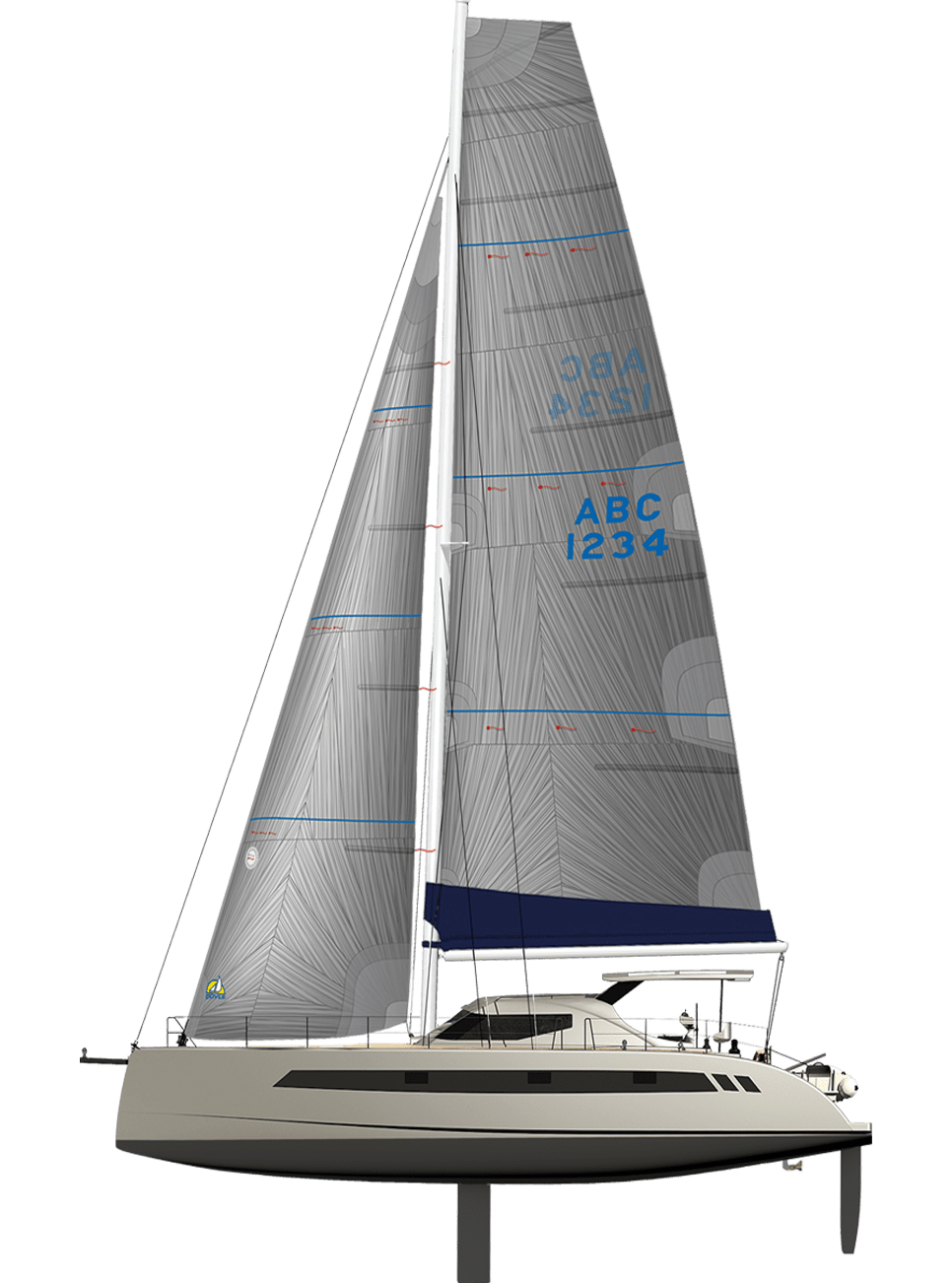
SPECIFICATIONS
Overall length, 52'8" / 16.1 m, 26'6" / 8.1 m, 1'9" / 0.6 m, displacement, 31,700 lbs / 14,400 kg, diesel saildrives, 2 x yanmar 57 hp / 43 kw, 196 us gal / 744 litres, fresh water, 174 us gal / 658 litres, 1,558 sq ft / 144.5 sq m, 21'8" / 16.1 m, 200 us gal / 750 litres, 1,080 sq ft / 100 sq m, 478 sq ft / 44.5 sq m, screecher (optional), 990 sq ft / 92.5 sq m, spinnaker (optional), 2,370 sq ft / 220 sq m, recommended options.
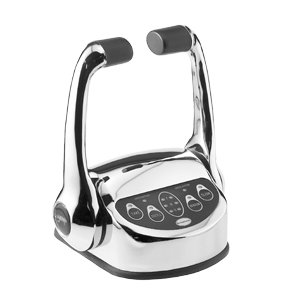
DUAL ENGINE CONTROLS

A second electronic engine control mounted at the stbd helm makes for easy maneuvering and makes the boat manageable from either helm.
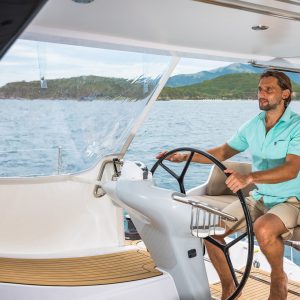
SIDE CLEARS
These removable role up clears are an essential item for any blue water sailor. Attaching to the outboard side of both the port and stbd helms they allow skippers to remain warm and dry at the helm in even the worst of conditions whilst still allowing for easy access and use of the sail controls.
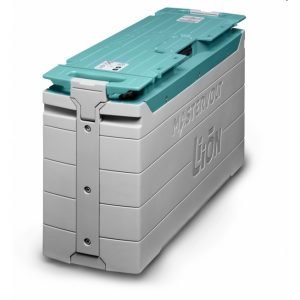
BATTERY LITHIUM UPGRADE (720AH)
Change from the traditional AGM battery system to a high capacity Lithium system from Mastervolt. This option not only upgrades the batteries but also modifies the entire charging system ensuring a total compatible system including upgraded mastervolt alternators and regulators, additional AGM start battery and DC/DC charging unit.
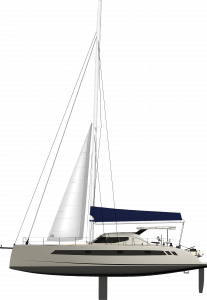
STORM JIB WITH FURLER
The storm jib is designed for use in winds too strong for the regular jib, typically in conditions 40kts and up. It provides just enough sail area to maintain directional stability.
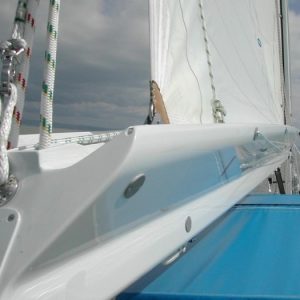
#SW1600-OPT001
Carbon park avenue boom.
Very simply, the wings of the carbon fiber boom extend outwards to catch the mainsail as it is lowered. Lazy jacks ensure that the mainsail is captured within the confines of the recessed area of the boom deck and hides the bulk of the sail when moored. The sail cover is fit to the inboard groove of the track system installed on the inside perimeter of the boom top.
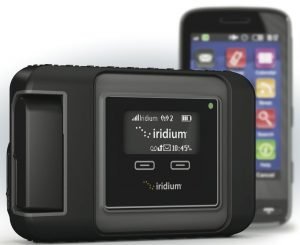
SATELITE PHONE/DATA WIFI ROUTER IRIDIUM GO
The Iridium GO! is a satellite wifi router/phone. Once installed in the boat the boat will have a wifi hotspot the same as any office/home and all devices (phones, computers, chartplotters, c-zone etc) can then easily be connected to the internet.
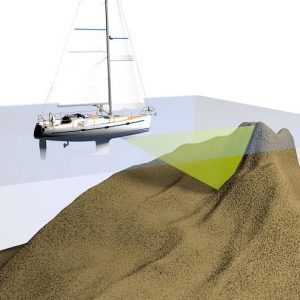
B&G forward Scan option
Explore poorly-chartered or unfamiliar waters confidently, avoid upcoming dangers or obstructions and set custom shallow depth alarms with B&G’s forward-looking sensor. With an effective range eight times the actual depth, ForwardScan® helps you avoid groundings or damage to keels and rudders while pinpointing the ideal spot for anchoring.
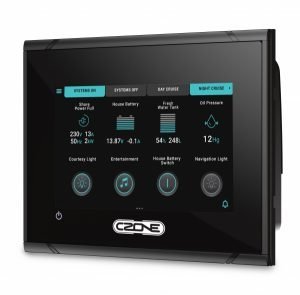
C-ZONE DIGITAL SWITCHING
The sleek CZone® touch screen digital switching system provides a lightweight sophisticated switching system enabelling control and monetoring of your vessel through the navigation tables touch screen display or through WiFi connection the system can also be controlled at the helm mounted chart plotter or wirelessly via tablet or smartphone.
- Full Production Now Underway in Turkiye with Completion of the First European Built Seawind 1170
- Seawind 1370 Hull 1 Test Report
- New Production Facility and European Service Center in Izmir, Turkey.
- Seawind 1600 Reviewed by Pacific Yachting
- Seawind Blog
- Charter A Seawind
- Find A Dealer
- Français ( French )
Tel +84 28 3873 3630
Sales Enquiry:
Customer Service Enquiry:
© 2024 Seawind Group Holdings, Pty Ltd. All rights reserved.
Privacy Policy

IMAGES
VIDEO
COMMENTS
Gunboat 62. gunboat_catamarans. An original performance catamaran cruiser from the iconic Gunboat manufacturer, the Gunboat 62 has truly cemented its place as one of the best catamaran sailboats to ever grace the oceans. Honestly speaking, this cat-inspired a whole range of other incredible boats including HH66 Catamaran and the Balance 526.
Gemini 105M Courtesy of Gemini Catamarans. Pioneering catamaran sailor, builder and designer Tony Smith launched the first of his 33-foot Gemini 105M's (10.5 meters = 33′) in 1993, and soon after found a ready and willing stream of sailors enamored of the boat's compact size, affordable price tag, and such innovations as the nifty lifting rudder and transom steps.
Hallberg-Rassy. Hallberg-Rassy is a Swedish shipyard that makes very sturdy and capable bluewater cruisers since 1943. Over the years, the company has made everything from small 24-footers to the flagship HR 64. Their best-known yacht was the smaller HR 35 Rasmus, of which they built 760 hulls.
Today I have chosen a little bit different perspective on how to evaluate the best catamaran brands. Leopard, Nautitech, and Catana are some of the best cruising catamaran manufacturers. They offer safe and easy to handle cats with impressive speeds. Leopard boasts the best family-friendly vessels, Antares is environment friendly, and Nautitech ...
Lagoon makes 9 sailing catamaran models and 2 powercat models, ranging in length from 40 to 78 feet. It also used to make shorted boats like the Lagoon 380 at 37 feet, but unfortunately, it was discontinued. You can find a Lagoon on the used market starting at $150,000 (like a 2002-2007 Lagoon 380) and as high as $5 million USD for their top of ...
Admiral Yacht Manufacturers: (954) 713-0412, www.admiralyachtsusa.com. Alliaura Marine (Privilège): The Catamaran Company, (954) 727-0016, www.catamarans.com
A well-built catamaran offers several features aimed at ensuring the safety of those onboard. First, catamarans have inherent stability due to their wide beam and twin hull design. This makes them less prone to capsizing than monohull boats. This stability allows me to confidently navigate various water conditions.
Lagoon Catamarans. Lagoon has always enjoyed a sweet spot in the 38 to 40-foot catamaran market. The Lagoon 380 became one of the most popular cats ever, with nearly 1,000 hulls being produced over a 20-year run. The L400 and L39 attempted to tweak that popular design, but neither caught on to the extent the 380 did.
Photo via Leopard Catamarans. Leopard is a catamaran brand that's been around longer than many, having launched its first 45 back in 1997. But they started with sailing catamarans and just began adding powercats a decade later; today there are three offerings in the power line at 40', 46', and 53'.
Oct 8, 2020. Powercats continue to gain traction in the cruising-boat market offering owners more space, greater privacy and better fuel efficiency and seakeeping ability than monohulls of similar length. Here is a sample of some of the best cats (and tris) on the market today. NAUTITECH 47 POWER. Nautitech 47 Power.
The best catamarans for sailing around the world include: Lagoon 42. The Fountaine Pajot Ipanema 58. Manta 42. Catana 50. Dolphin 42. Gunboat 62. These cats focus on speed, safety, and comfort for longer journeys. This article will show you the seventeen best catamarans for long journeys, and why they're the best.
Best catamaran and multihull winner 2024 - Outremer 52 My highlight test of 2023? Sailing this Outremer 52 for 200 miles over two days and nights! Quite how such a large vessel, one that is ...
A winning balance, it turns out, with the Balance 482 securing its position as the Best Performance Cruiser for 2022. More: balance catamarans, Boat of the Year, Boat of the Year 2022, catamaran, Kinetic Catamarans, print 2022 jan, Sailboats, seawind catamarans. With a powerful, versatile sail plan—as well as light, solid construction and go ...
By the way, Groupe Beneteau also owns Lagoon, a renowned catamaran maker, Prestige, luxury yacht manufacturer, Monte Carlo Yachts, CNB Yacht builder, the semi-custom sailboat maker, Four Winns, Glastron, Scarab, Wellcraft, Excess, and Delphia… some of these make motor yachts only, but if you combine fans of all of these, you get a sizable ...
With its powerful rig plan, extra-large cockpit, king size beds, and deep daggerboards, the HH60 is sure to ignite the imagination. "Boat of the Year" in 2018, the HH66 is where our journey began. Now with a full range of yachts spanning 44 to 88 feet, the HH66 remains our flagship luxury performance cruising yacht.
This is a list of notable sailboat designers and manufacturers, which are described by an article in English Wikipedia. Sailboat design and manufacturing is done by a number of companies and groups. Notable designers. Sailboat designer articles in Wikipedia: Alan Payne; Ben Lexcen; Bill Langan; Bill Lapworth;
Hobie's fiberglass beach-launchable catamarans revolutionized sailing. Fly a hull and you'll understand the global obsession. Hobie 16. Mirage Islands. Hobie Mirage Island trimarans are multi-mode performers: sail, fish, pedal, paddle. Yet approachable thanks to the hands-free power of the MirageDrive 180.
Set sail to new horizons from the power and beauty of Leopard Catamarans. Sea-trialed and tested off the coast of South Africa, Leopard Catamarans are known the world over for extraordinary craftsmanship and optimal performance. EXPLORE THE LEOPARD 40PC. EXPLORE THE LEOPARD 46PC. EXPLORE THE LEOPARD 53PC. discover our power range.
The best liveaboard catamarans are the Manta 42, the Nautitech 44, the Voyage 44, the Privilege 435, the Elba 35, and the Lagoon 380. These vessels are seaworthy, comfortable, and ideal for long-term living. We sourced the technical specifications of these vessels from maritime records and directly from sailboat manufacturers.
The Outremer 4x is a stable and comfortable high-speeding cruising catamaran that performs ocean crossings and confronts any weather with remarkable ease. Named the European Boat of the Year in 2017, this 48-foot (14.6 m) bluewater cruiser sails faster than wind speed and attains maximum cruising speeds of 20 knots.. The 4x is an upgrade of the extremely popular Outremer 45, thus retaining ...
Sail with the weather forward or aft of the beam. Keep an eye on heel angle. Reduce sail if you start to see any more than 5° or so, unless you have a catamaran that is designed to lift a hull ...
Photo: Leopard Catamarans. Displacement: 14.5 tons Beam: 24ft 2in Draft: 4ft 11in Features: Forward-facing cockpit, 3 or 4 cabins, 8 to 12 berths, up to 4 heads, up to 5 showers, 2 45hp engines, 780L water capacity, 700L fuel capacity. The big unique selling point of this best catamaran for sailing around the world is the forward-facing cockpit - a shaded and well-ventilated area to relax ...
With simple sailing systems, twin protected helms and a large open cockpit space, this blue water luxury cruising catamaran sets the standard for offshore sailing. At 52 ft, our Seawind 1600 Passagemaker is the flagship of our range with a brief to be the "ultimate luxury offshore cruiser". And after thousands of design hours, and thousands ...